Susannah: Back from Venice, to Stoke, via Birmingham International Airport. “Was it hard to say goodbye to the canals?” asked Alastair sympathetically, when I came home. I gave him the fish-eye because I knew what he was getting at. And indeed, he followed up with “it must’ve been hard to leave Venice, as well.”
Yes, it is true that Birmingham has more miles of canals than Venice. It’s true that the canals in Venice are not technically inland waterways. Nevertheless, I must admit to preferring Venice to Birmingham, as a city.
I was there for Carnevale—my third—with several friends from NYC. If you’re already on this side of the Atlantic, the trip, and the whole of Carnevale, is shockingly inexpensive: it’s about as much to get a round trip plane ticket to Venice from Birmingham as it is to get a return train ticket from Stoke to London, and over the past years I have learned the art of Cheap Carnevale, as well as the art of navigating Venice itself.
For more about the city and also about Vienna and about why the Austro-Hungarian Empire is an anti-fascist anti-ethnonationalist icon of the New Jerusalem, go here. (That piece also contains a detailed and I am convinced riveting account of our attempt to track down the bus we had bought tickets on from Venice to Ljubljana, an appreciation of the Viennese Jewish historian Fred Morton, and a blow-by-blow history of the development of the Sachertorte, including a thirty-year long lawsuit.)
Alastair will give you the rundown of what we did together after he arrived; for what I did before he arrived… What happens at Carnevale is that, in the week or so leading up to Lent (actually two weeks, but I only come for one) there is a party every night, nearly, each one with a separate theme. You come up with an appropriate costume for the theme, and after you get dressed but before you go to the party, you go to Florian, a coffeehouse that has been in continuous operation since its founding in 1720.
The parties have period music, an open Prosecco bar, and some kind of dinner; they are very elaborate but quite inexpensive. Nobody makes any money: this is done for love. There are also public parties that professional event planners do: those can be wildly expensive, but I’ve never gone to one.
This year’s parties ranged from Faerie Tales to Botticelli’s Primavera to 16th Century Venice to Orient Express: possibly the Botticelli party was the most breathtaking. It was held in the palazzo of a woman who has spent an enormous amount of time researching the everyday life of the Renaissance; she’s also painstakingly restored and decorated the palazzo. She worked with a chef to recreate 15th century recipes, and invited a madrigal group to sing period music during dinner.
I can’t begin to describe everything: you’ll have to content yourself with the pictures:
Botticelli’s Primavera: 15th Century Florence
Orient Express
Miscellaneous
Alastair: In March 2020, I had arranged to visit Italy for the first time. My flights to Trieste were booked and I was eagerly awaiting the trip. Then COVID hit the north of Italy and I had to cancel my plans. While the cancellation actually worked out well for me—and for us!—I had been deeply disappointed not to visit Italy.
As Susannah was in Venice with her Carnevale gang again and had been given the use of an AirBnb for the rest of the month after it was over, we had planned for me to fly over after all the parties, socializing, and dancing were safely concluded, to spend a week and a half of a working holiday with her. Although it did mean even more travel and we both would need to be quite productive on the trip, the prospect of spending some time away together, without travelling to an event or to spend time with friends or family, was exceedingly welcome. We can work anywhere we can set up our laptop and recording equipment; it is also about as cheap to fly to Venice and back as it is to get a return train ticket to London.
But after I booked the trip, various things (particularly my parents’ impending move to sheltered accommodation) came up which meant that, reluctantly, I decided that I had to cancel the trip.
Last year, we had to cancel a trip that we had been invited on to Israel due to work and other commitments and my 2020 planned trip to Italy had been cancelled, so having to cancel this long-awaited trip as well—especially as we had been given the use of the accommodation—was a huge disappointment.
The next day, however, my mother told me that, as they did not yet feel prepared for it, they had decided to put back the date of their move. Although I had to purchase a different ticket to come back earlier, it meant that I was able to make the trip.
It is barely believable that the city of Venice exists, especially when one considers its inauspicious origins and location. Constructed by refugees from barbarian invasion in the early fifth century AD, the city is built in a marshy lagoon. The first settlers drove tens of thousands of wooden piles down through the mud and sand of the lagoon into the clay beneath, forming a platform upon which much of the city still rests. The gaps between the piles were filled with crushed stone and limestone blocks were placed above them. Not being above the water level, the wood was not as subject to decay; the timber of the piles has since petrified. The city has always been at risk of flooding and, with both rising sea levels and the sinking of the city, addressing this threat has become more urgent.
Venice is strategically situated at the head of the Adriatic and, especially during the High Middle Ages, it ascended to become an immensely powerful merchant republic, with great naval power (for which the remarkable Venetian Arsenal was largely responsible) and vast commercial and financial wealth. As Byzantine imperial power waned from the ninth century, Venice ceased to be a province and became an independent republic, enjoying special trade privileges from the Byzantine Empire in exchange for its naval support. Its dominance in Mediterranean trade, backed by its naval might, especially prior to the discovery of the New World, made it enormously wealthy. The heart of a thalassocracy, it had coastal territories around the head of the Adriatic, down the Dalmatian coast, the Peloponnese, Crete, Cyprus, and mainland territories up to the Alps.
Besides its significance as a place of trade, naval power, and finance, it was a centre of glass and textile manufacturing and, chiefly through the work of Aldus Manutius, became a capital of early printing within Europe.
Venice is formed of over one hundred islands, connected by about four times as many bridges. While one can easily get around the city on foot—we did not splurge on a gondola ride and I only took one waterbus ride during my trip—the city feels as though it is floating above the many canals that wind throughout it.
The complete absence of roads beyond the entrance to the city has also saved Venice from the dehumanizing and fracturing effects of the automobile and the privileging of cars in much town planning. So many of the dysfunctions of modern society and the ugliness and unpleasantness of our places result from our privileging of the automobile within our towns and cities, and the many habits and practices that follow from that determination. It is no accident that so many of the towns and cities most celebrated for their beauty and livability are places where geographical constraints or preexisting building have restricted the destructive ingress of the automobile. I probably could do without further radicalization in my desire to marginalize cars and discourage driving within the lived environment, but Venice did not help on that front!
The Republic of Venice was ruled over by a doge—and, yes, during our visit I made several references to the meme—and a relatively large though increasingly closed and hereditary oligarchic elite, which, all things considered, worked surprisingly well for the city. The doge was a member of the oligarchy, typically elected for life to the role, although checks were placed upon the role to ensure that it did not become a hereditary monarchy. The ducal residence was the Doge’s Palace, an immense building of glorious gilded chambers surrounding a vast courtyard, next to the Piazzetta San Marco and looking out onto the San Marco Basin, and within which various other Venetian political bodies also met.
While the canals of Venice may not match those of the famed West Midlands city of Birmingham in their length [Susannah: 😡], they still have much to commend them. There are numerous narrow canals threaded throughout the city, wider canals, most notably the Grand Canal, or bodies of water such as the Giudecca Canal, which divides Giudecca from Dorsoduro (where we stayed) and flows out into the San Marco Basin. Then, scattered throughout the Venetian Lagoon, there are many other islands of various sizes, such as Murano, renowned for its glass. The canals are both romantic and awe-inspiring; Venice is a city of lovers, but it also constantly reminds you that it was once the heart of a maritime empire.
Our Venice trip needed to be a productive working holiday, so I brought recording equipment with me, to record podcasts, participate in meetings, and teach my classes. At one point, Susannah and I were both recording in our two room AirBnb, Susannah in the kitchen/living room and me in the bedroom. When we were not teaching or recording, we worked in places like the glorious Danieli Hotel. To save money, we generally cooked for ourselves, although we had three meals out.
We did not have as much work on the Wednesday, so we visited the spectacular Fortuny Museum, devoted to the life and work of the artist, inventor, and designer Mariano Fortuny (1871-1949), who used to have his studio there. That evening we went to a memorable Vivaldi concert in the church of Santa Maria della Pietà or della Visitazione.
The next day the weather was more overcast and, as our work appointments were in the afternoon, we spent the morning looking around the Doge’s Palace, easily among the most incredible buildings I have ever seen. Having seen one vast chamber surrounded with impressive murals beneath a great gilded ceiling, I presumed we had seen the most impressive room, but there were several others that exceeded it in their splendour.
In contrast to the majesty of the chambers were the prisons, through which we passed before crossing the famous Bridge of Sighs. We also spent some time looking around the great courtyard of the Palace.
The next day, we visited St Mark’s Basilica, which claims to house the relics of Saint Mark the Evangelist, the patron of the city. Situated on the Piazzetta San Marco, it is also attached to the Doge’s Palace. The historic Byzantine influences upon Venice are not difficult to recognize in this building. It has great domes, covered with golden mosaics.
Visitors to the Basilica can ascend to a higher level, where there is a museum, and from which you can go out onto the balcony. The balcony has four gilded horses, replicas of the Triumphal Quadriga looted from Constantinople during the Fourth Crusade. The originals, which some believe to have been constructed as early as the fifth or fourth century BC, are now within the museum. From the balcony, one can look out onto the Piazzetta and, to the south, over to the San Marco Basin.
We had arranged to meet up with some dear friends of mine in Ljubljana, the capital of Slovenia, on the Saturday, so we left Venice at around 11am. While I have visited many more American states than Susannah has (my tally is currently thirty-three), before my Venice trip, she had visited one more European country than I had. However, as she had previously visited both Italy and Slovenia, I was able to overtake her. She will draw level again when we visit Ireland in May.
Ljubljana has a population of around 300,000 people and is built on the site of the Roman city of Emona. Its former association with the Austro-Hungarian Empire is easy to recognize in the architecture, not least the Schönbrunner gelb of several of its major buildings. It is an utterly charming southern European city, above which the picturesque Ljubljana Castle serves as a landmark.
Although I have caught up with them over Zoom on several occasions, I had not spent time with my friends since 2019, and Susannah had not yet met them in person. We arrived in Ljubljana at around 2pm and enjoyed a large meal with my friends, giving us plenty of time to catch up and for Susannah to start to get to know them. They are another Transatlantic couple, dividing their time between Croatia and Memphis, Tennessee. While I had visited them and their church several times in Memphis, this was my first time seeing them in Croatia.
We spent a few hours exploring the centre of the city before travelling back to their home in Croatia. On the way we stopped off to buy krofne, the largest doughnuts I have ever seen. Driving to Croatia, we were struck by the many roadside shrines that we passed; Croatia is still a strongly Catholic country in many respects.
After church on Sunday, we looked around the beautiful city of Varaždin, which has an astonishing wealth of spectacular and charming architecture, much of it Baroque. Like Venice and Ljbuljana, the absence of vehicles in much of the city made it an extremely pleasant place to wander around.
From Varaždin we went on to Čakovec, where we walked from the castle into the city. That evening, the end of the last full day of my visit, we had another walk near our friends’ house. The weather, as it had been throughout all but a couple of days of the trip—one overcast, another with torrential rain—was wonderful.
I was flying out from Zagreb Airport on the Monday afternoon, so we left for Zagreb after breakfast and spent the late morning and early afternoon seeing some of the sights in the centre of the city. The cathedral is currently being repaired after an earthquake, but there were several other impressive churches and squares.
The week was such a happy and memorable one, just the chance to catch our breath that we need before the insanity of the two house moves that we need to accomplish in the next fortnight! Please pray for us—I am sure that we will need it.
A Lenten Reflection
And calling the crowd to him with his disciples, he said to them, “If anyone would come after me, let him deny himself and take up his cross and follow me. 35 For whoever would save his life will lose it, but whoever loses his life for my sake and the gospel’s will save it. 36 For what does it profit a man to gain the whole world and forfeit his soul? 37 For what can a man give in return for his soul? 38 For whoever is ashamed of me and of my words in this adulterous and sinful generation, of him will the Son of Man also be ashamed when he comes in the glory of his Father with the holy angels.” Mark 8:34-38
Our Lord’s teaching in this passage is arresting and shocking. Coming shortly after his first statements foretelling his death, statements which had provoked a scandalized response in Peter, it is the first time in the gospel of Mark that the specific manner of his death is implied—‘take up his cross and follow me.’ If Peter had objected to the prospect of his Master willingly going to his death, our Lord’s teaching in response suggested that faithful disciples must follow him on that path.
Almost two millennia later, the symbol of the cross is ubiquitous and overwhelmingly seen as positive; it is seen on jewelery, on places of worship, on national flags, on the crowns of kings. Yet to Jesus’s first hearers, the cross might have evoked the ignominious deaths of subdued insurrectionists or rebellious slaves. It represented imperial might and cruelty and was a grisly spectacle of abject humiliation and agonizing suffering.
While some have compared it to the electric chair, crucifixion as a means of execution was designed to produce spectacle in a way that the electric chair or lethal injection are not. It was not a fast or a clean death delivered in some room deep in a government facility: the drawn out suffering and utter humiliation of the crucified person was on the most public display, exposing them to ridicule and abhorrence, and presenting them up as a warning to others. That Jesus should willingly travel towards such a death and to charge others to follow him on that path would naturally have appalled his disciples and hearers.
In his teaching, Jesus presents the sharpest of contrasts: gain and loss, life and death, shame and glory. And, shockingly, he presents his way of the cross, that symbol of the most gruesome and shameful death, as the way of gain, life, and glory. Behind the contrasts lies a deeper contrast, between seeking ultimate security, life, and honour from the people of a wicked society and seeking such things from God. Although the cross represents the ultimate rejection of a cruel and evil society, when the path of the cross is taken in the faithful service of God, it ascends to the place of highest honour.
In his charge to his disciples, Jesus identifies the more fundamental action that is required of them, and of us. Rebels and revolutionaries, in their opposition to the established powers, can situate the line between good and evil between them and their enemies. Perhaps for the most radical such persons, one could imagine the cross being treated as a symbol of revolutionary heroism against a brutal regime. Yet the deeper adversary that Jesus focuses upon is neither the Jewish religious leaders nor the Roman Empire, but our own fickle hearts. Our desire for security, our wish to avoid suffering, our hunger for praise, our sense of shame before the slights and ridicule of our family or neighbours: this is where the greatest threat resides.
We must deny ourselves.
Yet we should beware of so emphasizing the renunciation that Jesus commands that we miss the promise that he holds out. The path of the cross is the path in which we follow Christ himself, the path he has pioneered for us, the path where we ascend to be with him. The cross has become for us the Tree of Life, the disarming of false powers (Colossians 2:14-15), a beacon of hope to the world, a sign of victory, the mark of honour, a promise of deliverance to all oppressed by the evil one, and the symbol of our very salvation. This is because of the One who hung there for us, overcoming in his sacrifice. It is through him that the cross is not merely an empty and suicidal gesture of political renunciation.
In taking the path of the cross, we don’t merely reject the world and ourselves, but affirm Christ. We take this path as those called to be witnesses, as martyrs.
The centrality of the cross was paramount in the teaching of St Paul in his Epistle to the Galatians. Against any who sought to move beyond the scandal of the cross to present the Christian faith merely in the unthreatening and respectable clothing of religious or social conformity, Paul insisted that no such movement was possible. “But far be it from me to boast except in the cross of our Lord Jesus Christ, by which the world has been crucified to me, and I to the world” Galatians 6:14.
For Paul, while it was never less, the cross was much more than a sign of Christ’s once for all vicarious sacrifice. The manner of Jesus’s death mattered. It marked and symbolized the fundamental and comprehensive reconfiguration of Christian existence. The Christian response to the spectacle of radical shame and dishonour that was crucifixion is not to seek to minimize it, but to proclaim it, even to boast in it.
For the cross is a spectacle and must never cease to be such. It is a radical unmasking of the truth of things. It is a stripping and disarming. It is a manifestation of triumph and victory. In John’s gospel, Jesus refers to his cross as his ‘lifting up’, as an exaltation that would draw all peoples to him (John 12:32-33; cf. 8:28; 3:14-15). In Colossians, Paul describes God disarming rulers and authorities and putting them to open shame, and triumphing over them in Christ and his cross (Colossians 2:13-15). For Paul, the cross is a spectacle of shame, of subjugation, and of utter defeat, yet of the rulers and authorities of this age, not of Christ!
The ultimate sanctions of rebellious humanity—destruction of the body, death, utter shame, social rejection and expulsion—were rendered impotent in the cross. To the destruction of the body, the cross is the sowing of the seed from which a more glorious body will spring forth. To death, the cross is the opening up of the fountain of water and blood from which everlasting life will be enjoyed. To utter shame, the cross is that in which we glory and Christ’s exaltation to universal rule. To social rejection and expulsion, the cross is the foundation of a new society and that through which we will find welcome into eternal habitations.
Although the visceral shock and offence of the cross as a symbol has greatly diminished, through distance from the wider practice of crucifixion and familiarity with the cross as a religious symbol, we must revisit the cross and rediscover its meaning. And Lent is a perfect time to do so. As we recall Jesus’s journey towards Jerusalem, his setting his face towards his cross, let us learn to take up our own. Let us learn to carry our crosses, not merely as unwelcome and onerous burdens, but as what they are in truth—the signs of our living union with Christ, our deepest identity and belonging, and the assurance of our destiny and inheritance.
We carry the cross as those marked for death. We release our desperate grip upon the praise of men, the security this present age has to offer, the social standing it affords, the power, wealth, and fame it pursues. These things, of which most people’s ‘selves’ are formed, must all be denied or surrendered. And, marking ourselves out for such ‘death’, we recognize that we, like Christ, must be prepared to be a spectacle. In our renunciation, we must be witnesses and martyrs, our lives a site in which the unveiling, disclosure, and disarming of Christ’s cross might be manifest. And the triumph on display is first and foremost a triumph over our selves, Christ’s victory over that within us that is in the thrall of the world and all that it has to offer. While we are displayed as those over whom Christ has been victorious, we are also the beneficiaries of his victory: in surrendering the whole world, we gain our very souls.
The cross remains the true symbol of the Christian faith, the symbol of our having been crucified with Christ, of our standing relative to the world, and of our allegiance to Christ. As a paradoxical intersection of shame and glory, life and death, gain and loss, salvation and destruction, in the cross the full mystery of our salvation is displayed, and we discover the path that leads to joy everlasting.
Recent Work
Alastair:
❧ Our latest two Mere Fidelity episodes have been an episode on C.S. Lewis for Everyone and a Lenten-themed Ascesis and the Modern World.
❧ The Theopolis Podcast hit its seven hundredth episode with Deuteronomy 23: Excluded from the Assembly. Our Deuteronomy series just keeps on going with further episodes on Deuteronomy 23: Uncleanness in the Camp and Deuteronomy 23: Slaves and Cult Prostitutes.
❧ Ad Fontes published a slightly edited version of my latest Substack reflection: The Anglicanism of C.S. Lewis.
❧ You can listen to an audio version of my Pilgrim Faith podcast with Ryan Hurd here.
Susannah:
In case you haven’t yet, do check out my long (sorry) but entertaining piece on Habsburg cities as rebukes to ethnonationalism and fascism, and as offering an alternative vision of Christian cosmopolitan multiculturalism. Much more to come in the next Substack.
Upcoming Events
❧ Alastair’s next Davenant Hall course is now open for registration:
Christian teaching regarding the sexes has grown in prominence as a source of controversy both within and without the church over the past century. Yet these debates often devolve into hurling around proof-texts, straining the gnats of first-century context, and contesting abstract ideas about rights, progress, and equality. What all sides often fail to consider is how much the material changes of modernity have affected this whole topic.
This course will consider ways that the transformed material realities of the modern world and its associated ideas have altered both how we understand ourselves as male and female, as well as how sexual relations are practised and conceptualized more broadly. By examining the greater felt incompatibility between scriptural teaching and social reality and practice, considering topical issues and live debates, and engaging with important texts, it will propose ways in which we can thoughtfully and faithfully understand, adhere to, and communicate Christian teaching in the twenty-first century.
❧ Alastair will be out in the Bay Area in late April, delivering a two-day course on a biblical theology of the sexes: Beyond Rules and Roles. You can sign up for it here.
❧ Most of Alastair’s work is as an independent scholar, funded by Patreon donors. His primary goal is to create thoughtful yet free Christian material for the general public, most notably his largely-completed chapter-by-chapter commentary on the whole Bible (available here and here). If you would like to support his continuing research, teaching, writing, and other content production, you can do so here.
Much love,
Susannah and Alastair








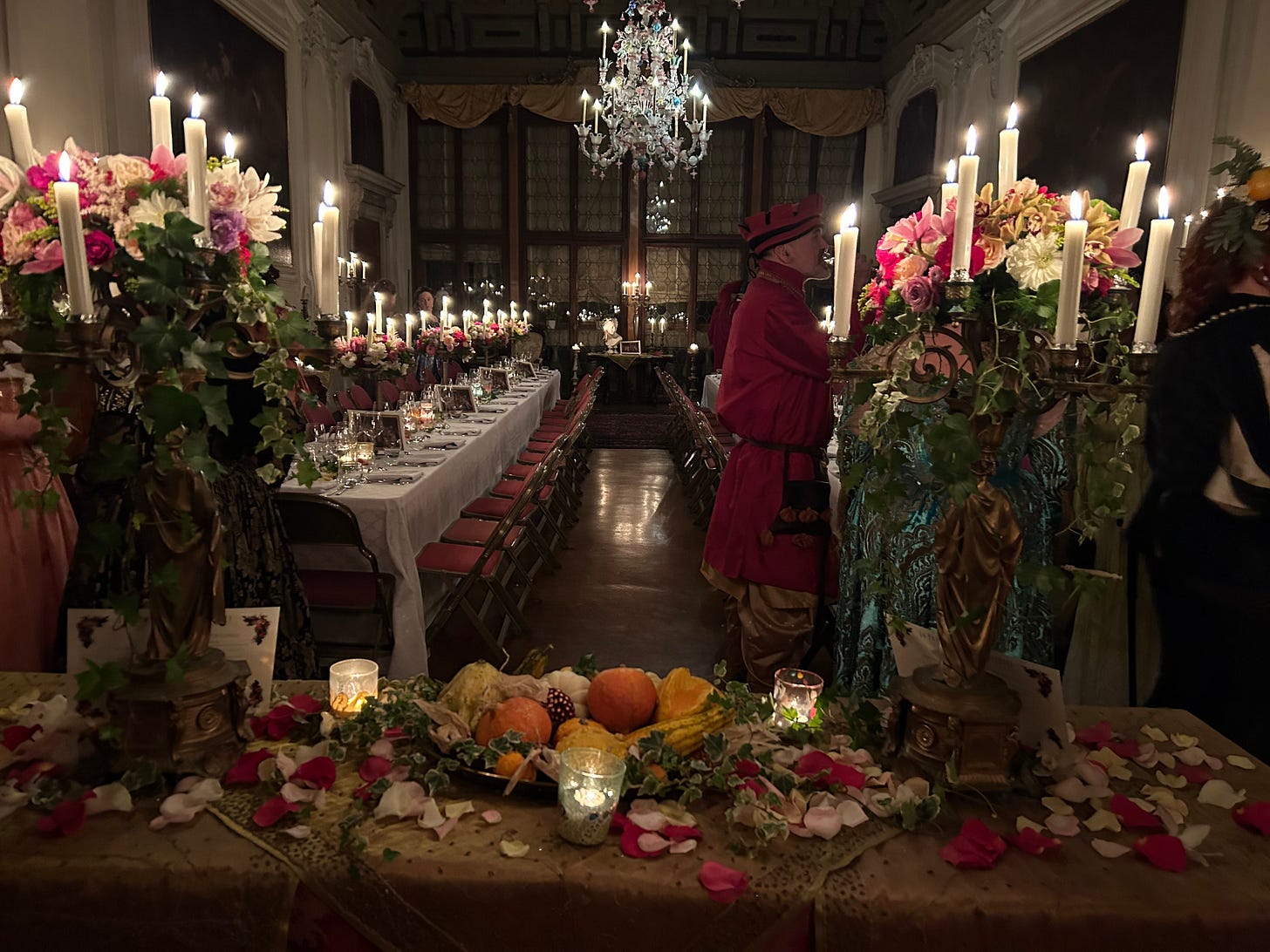

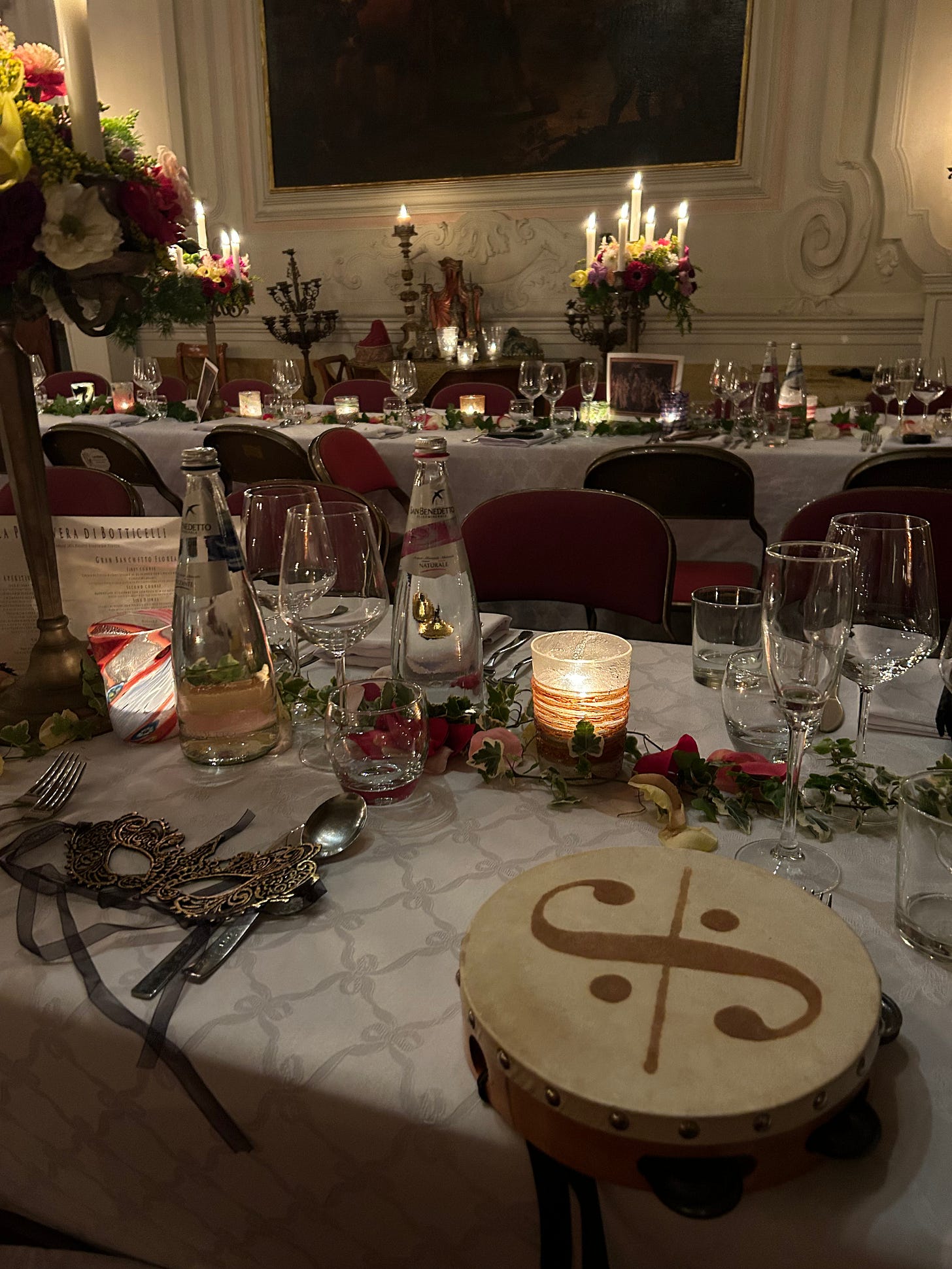
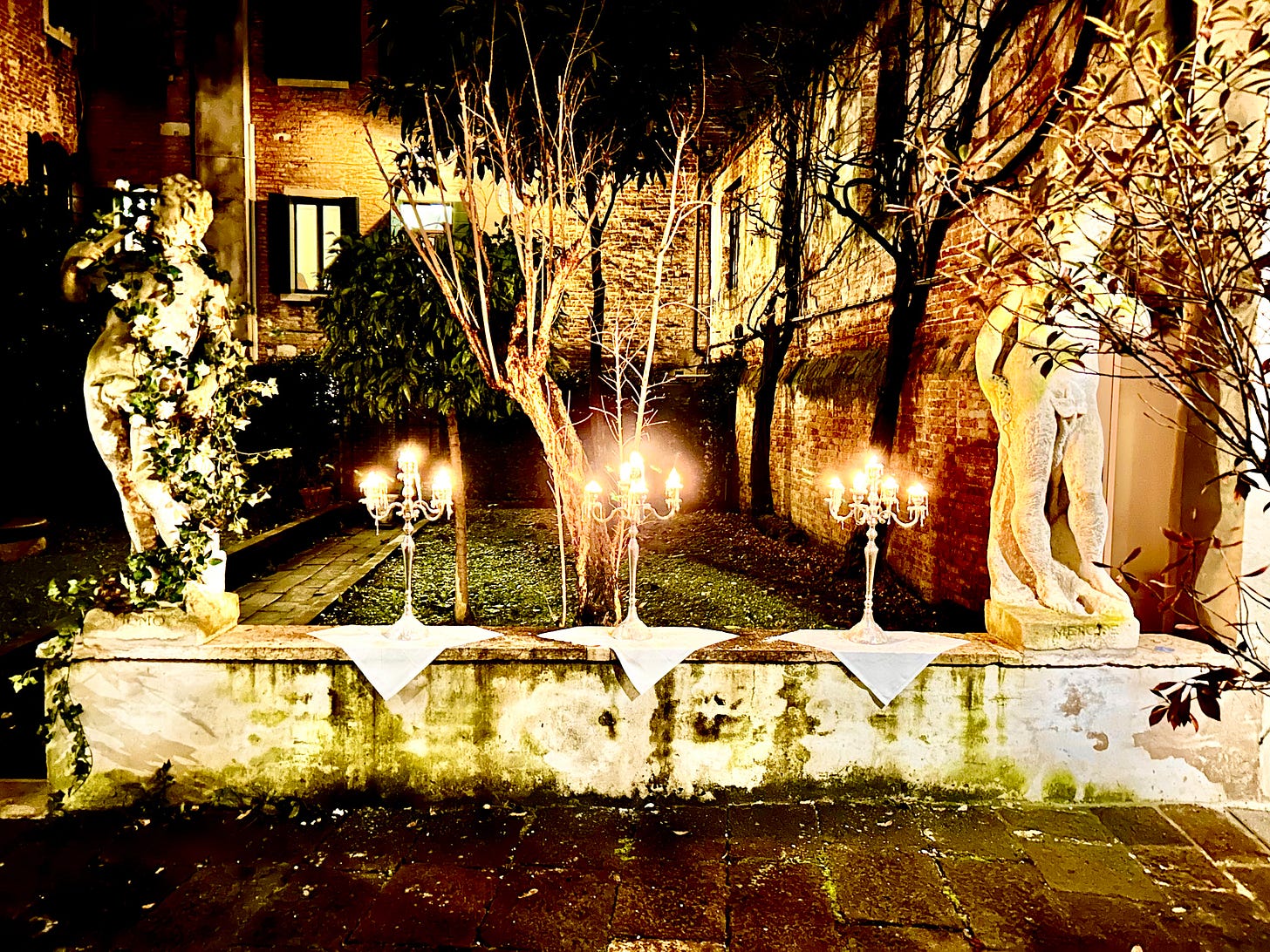
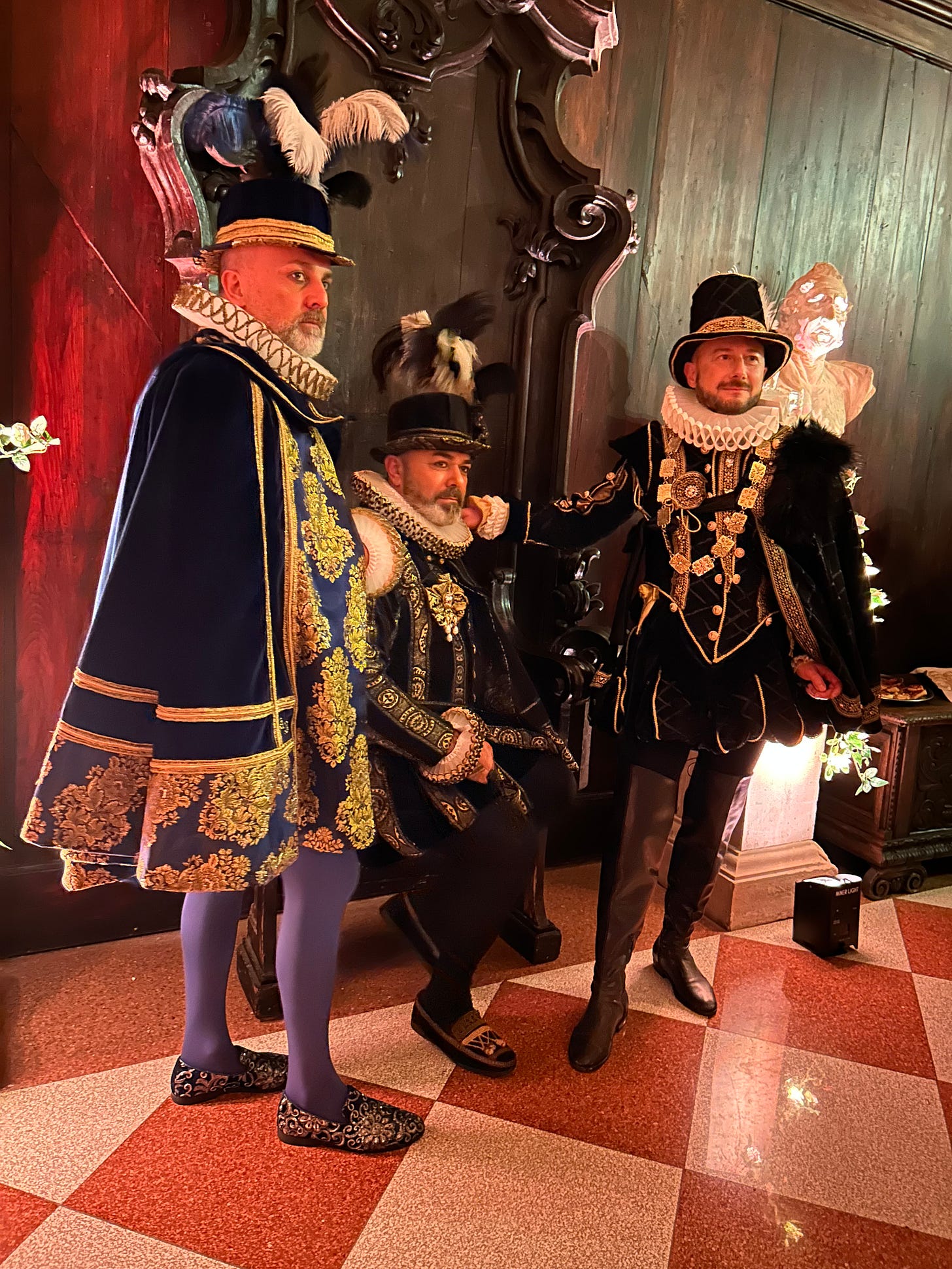
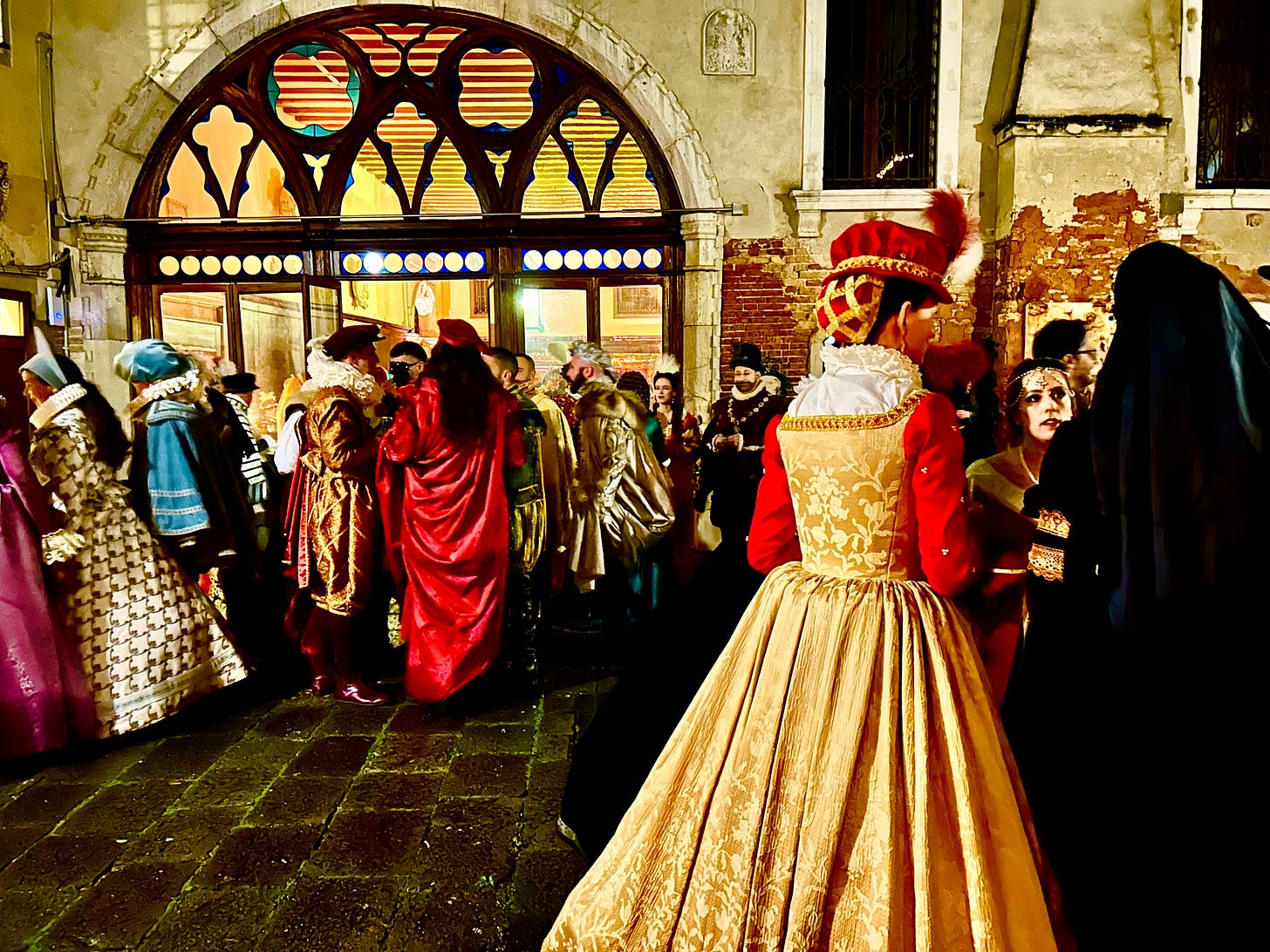
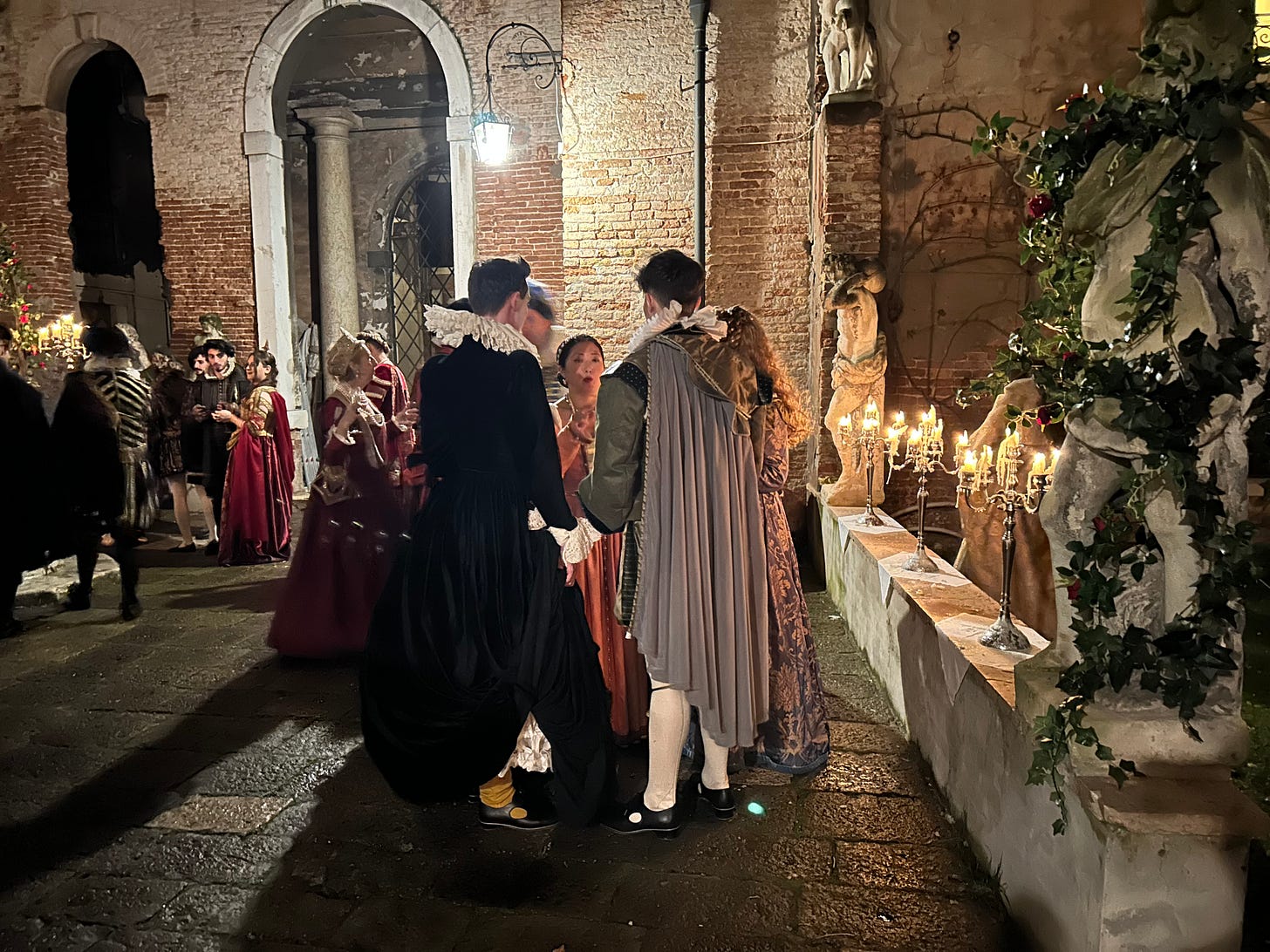

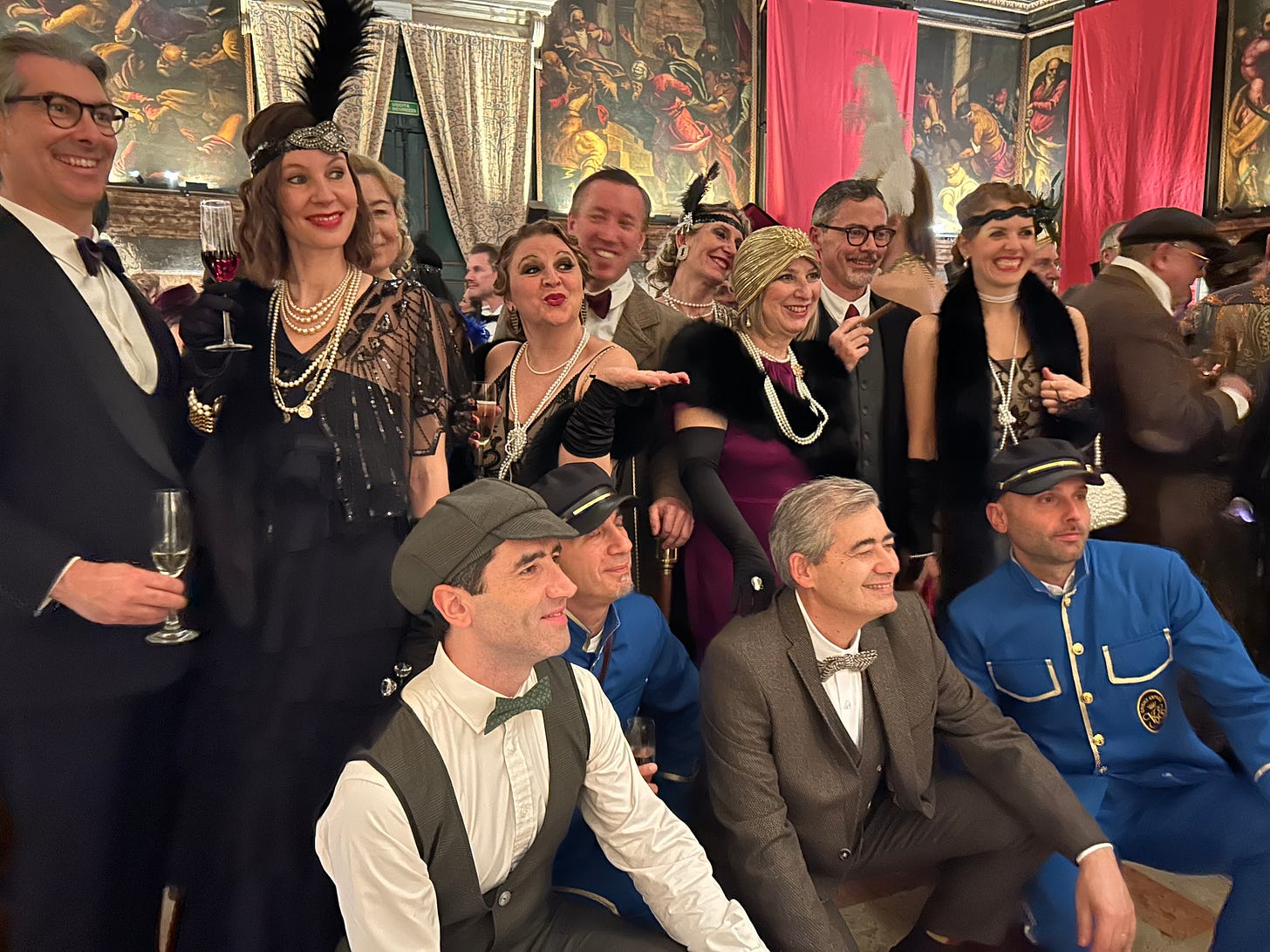

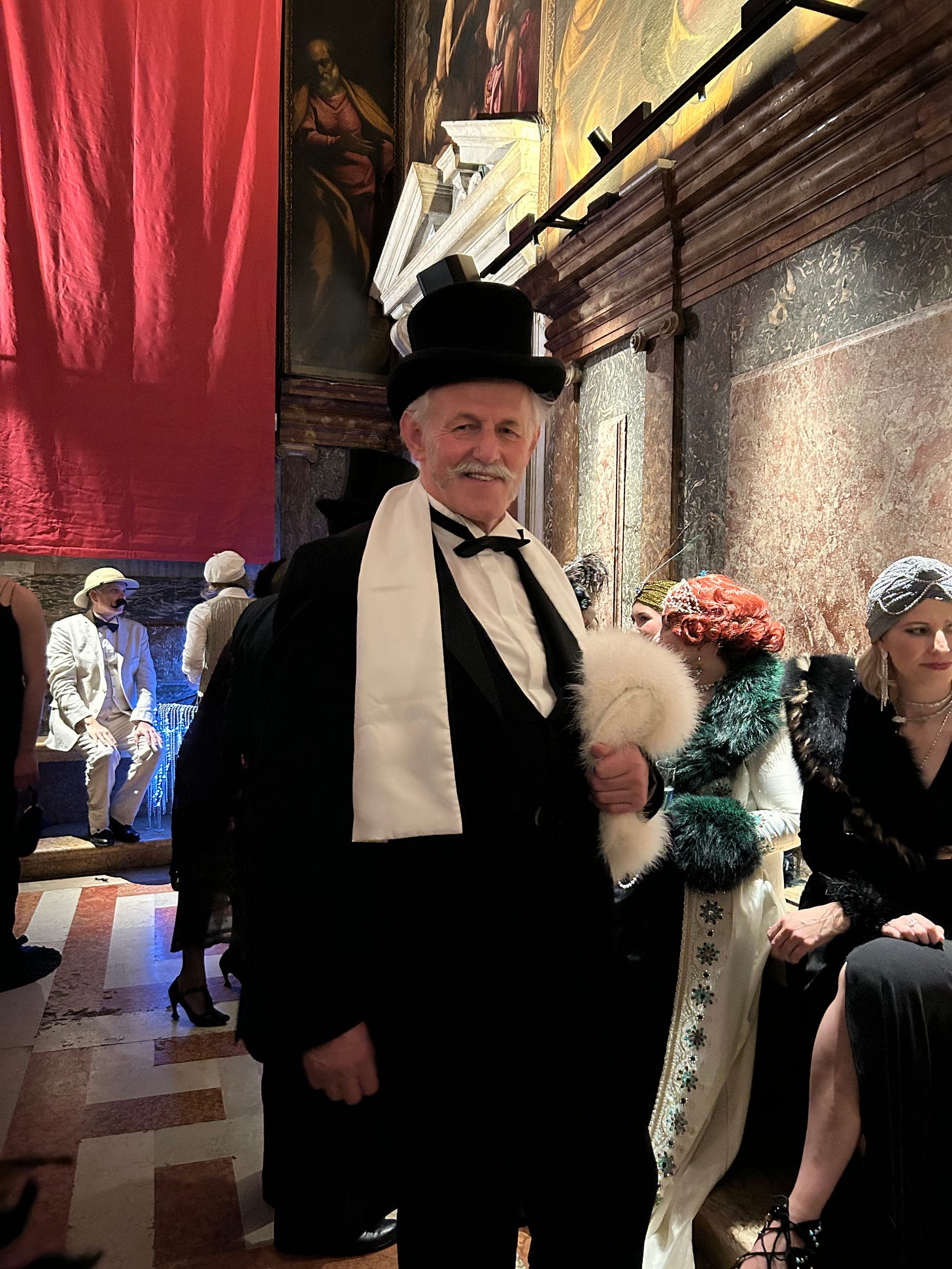

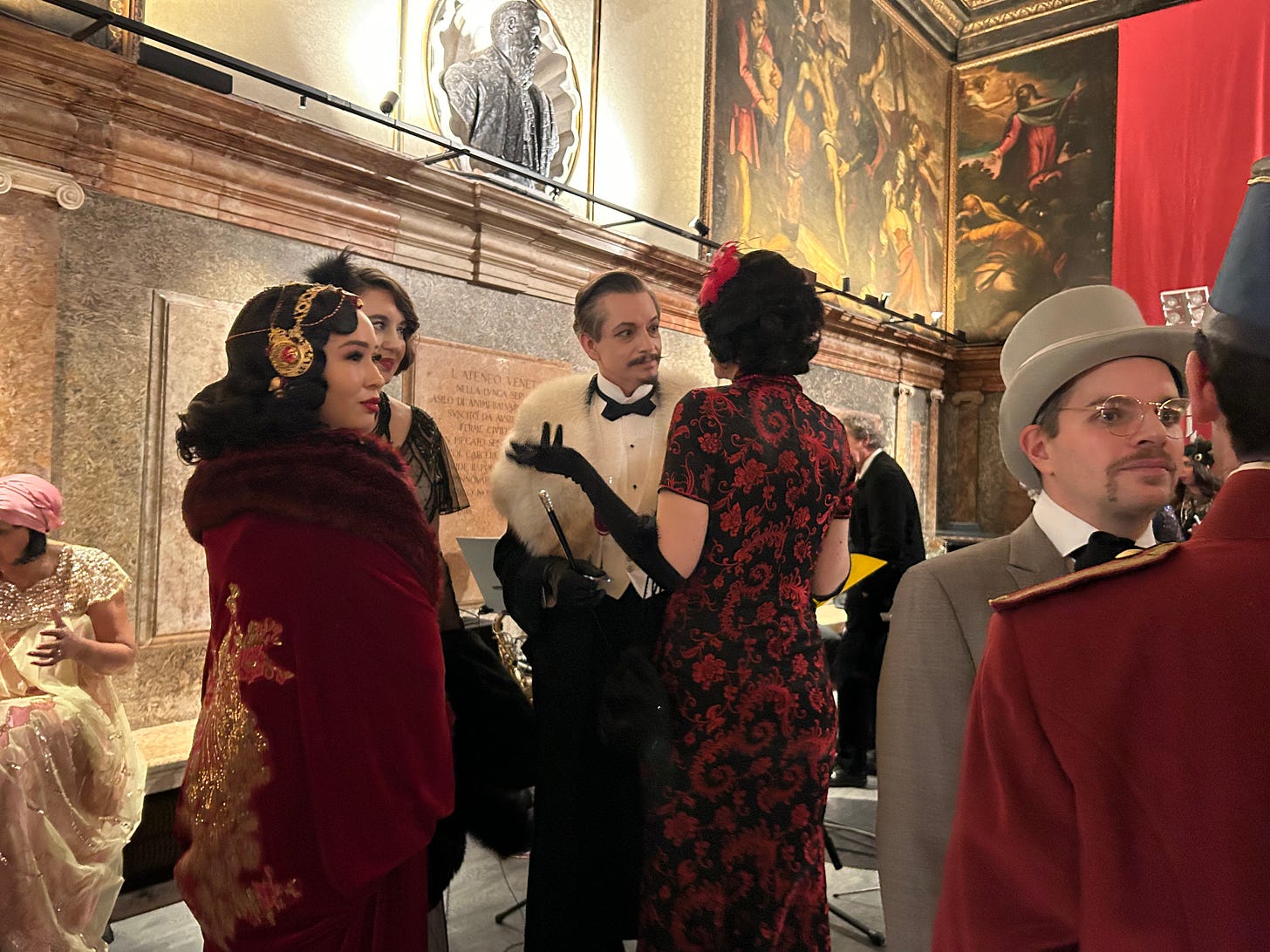


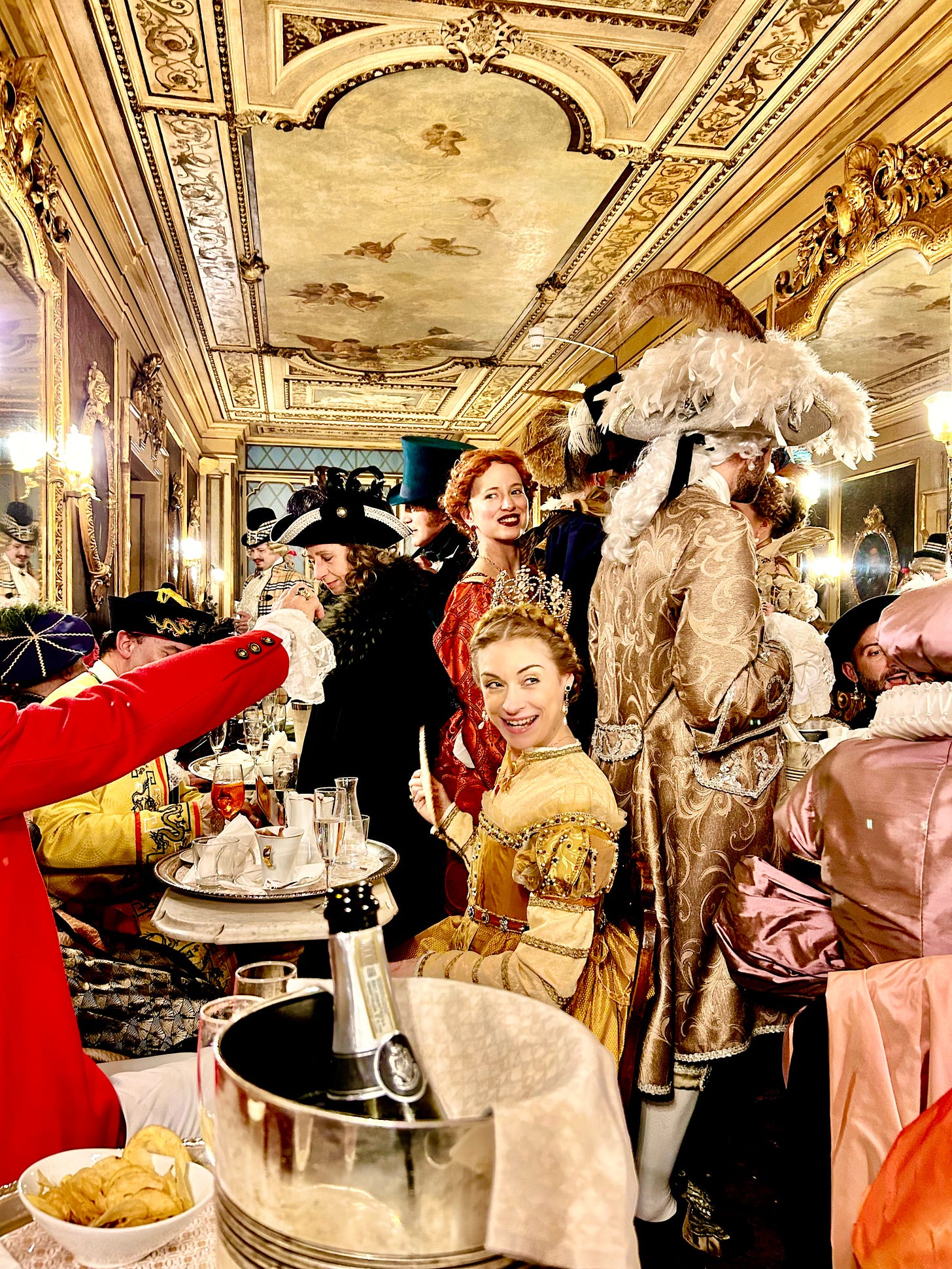




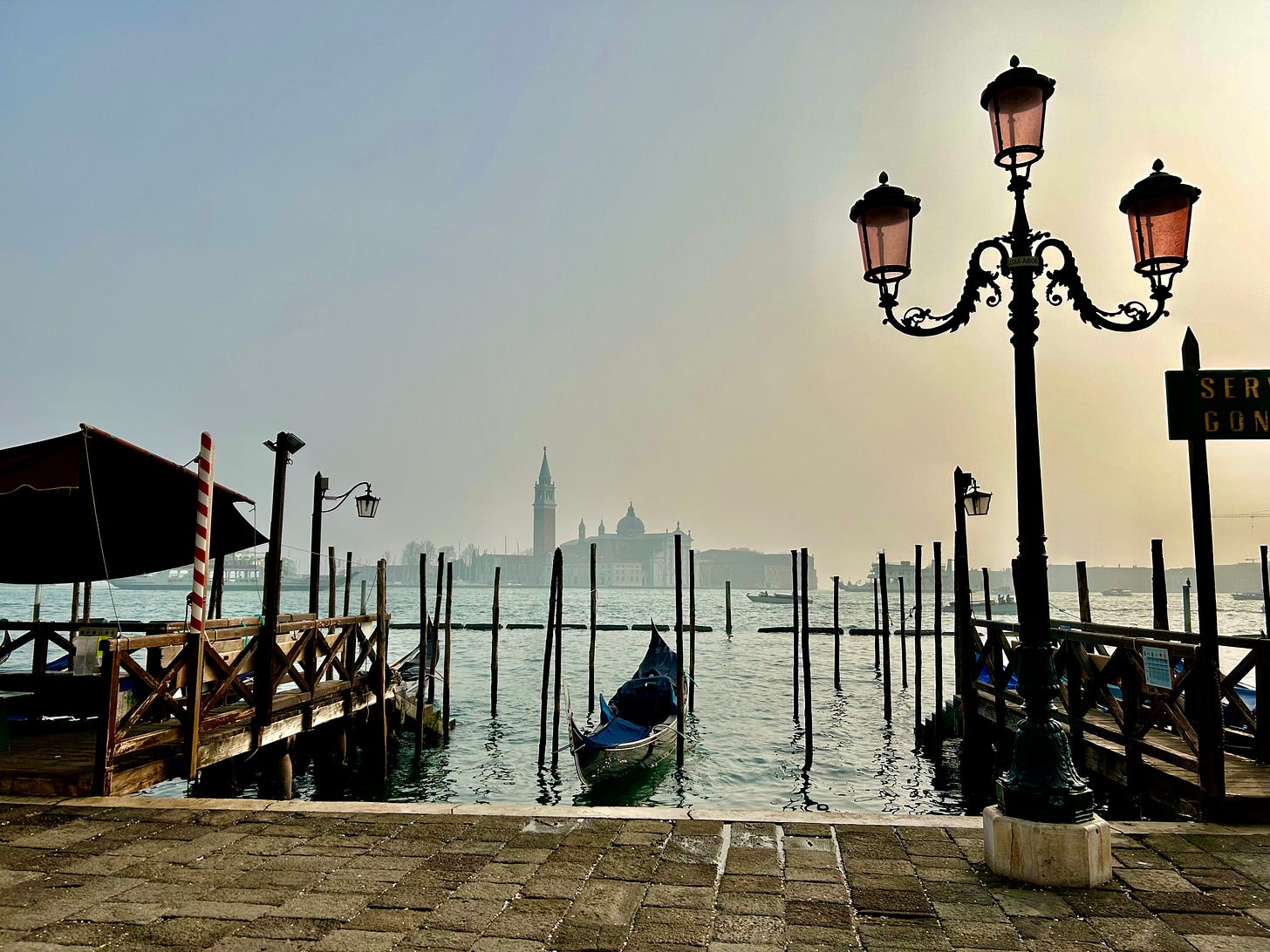
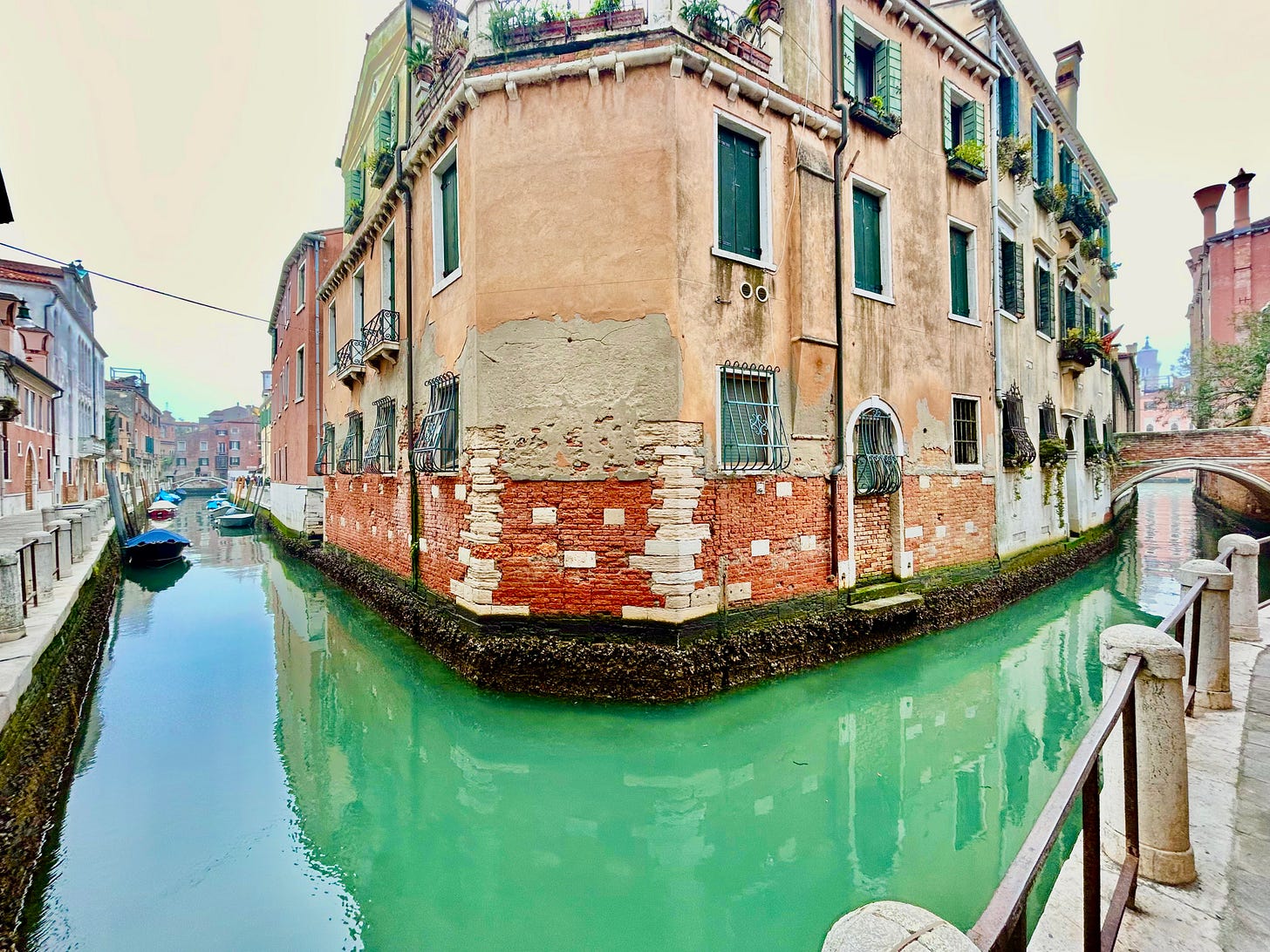


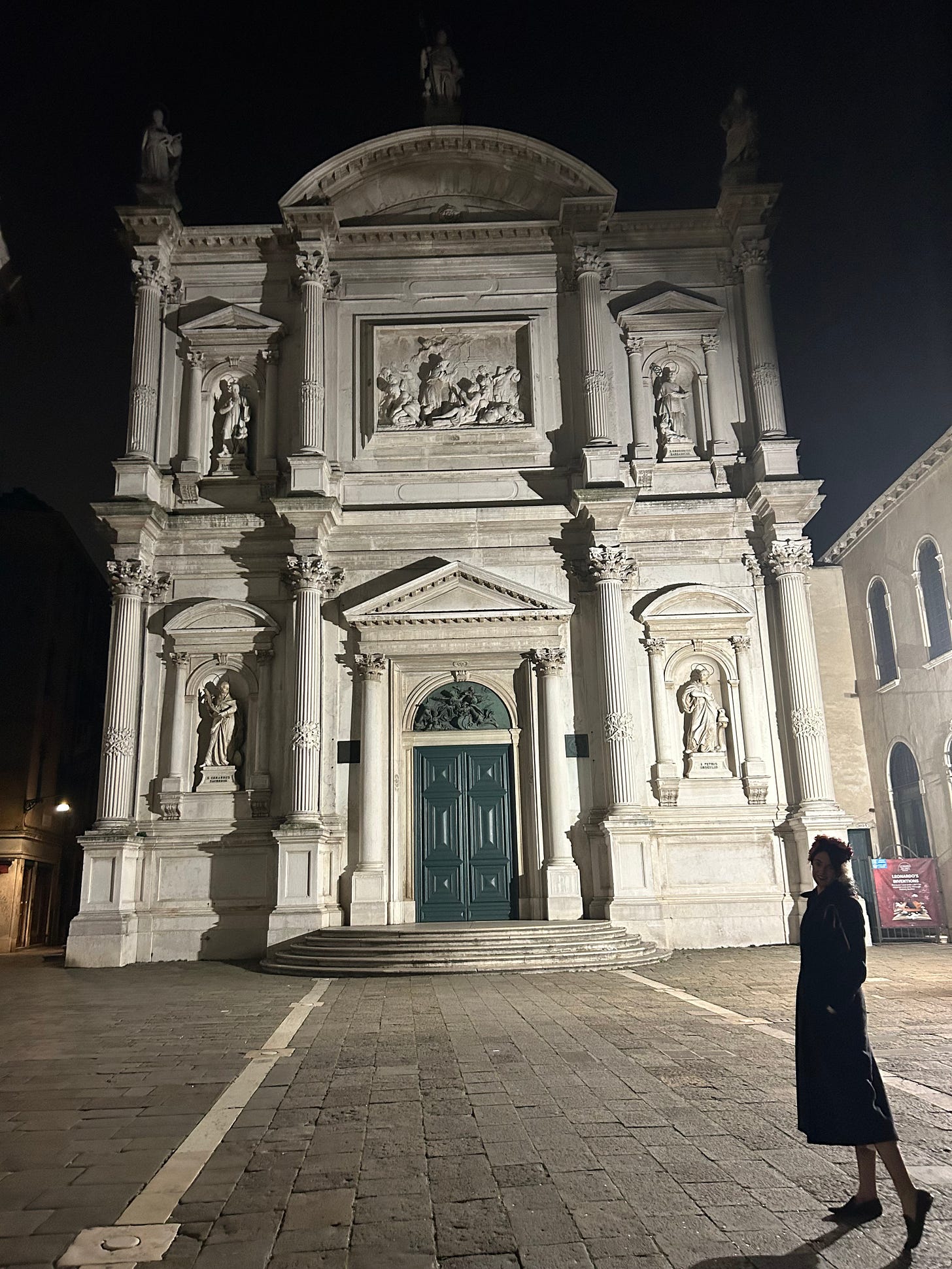
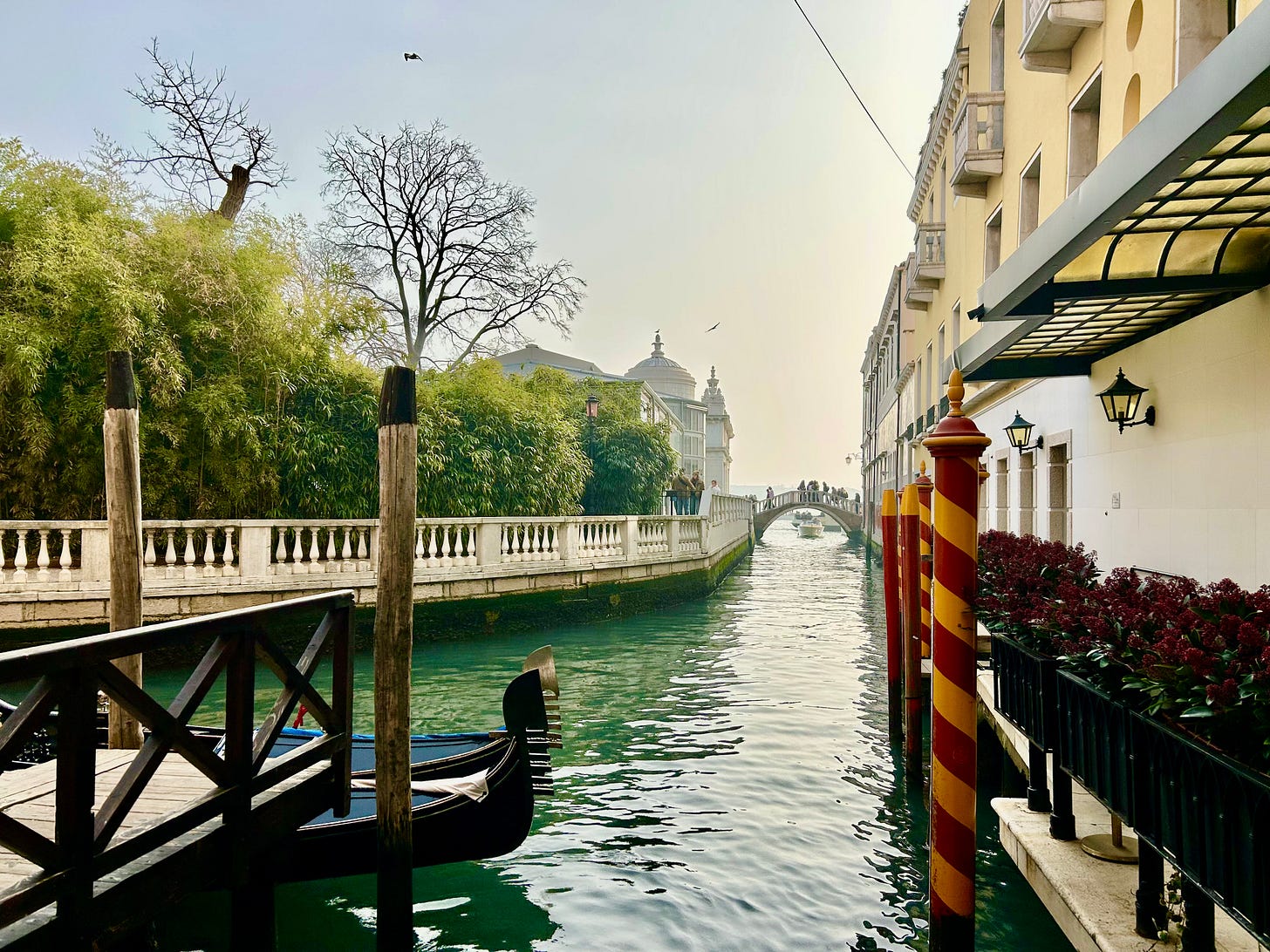


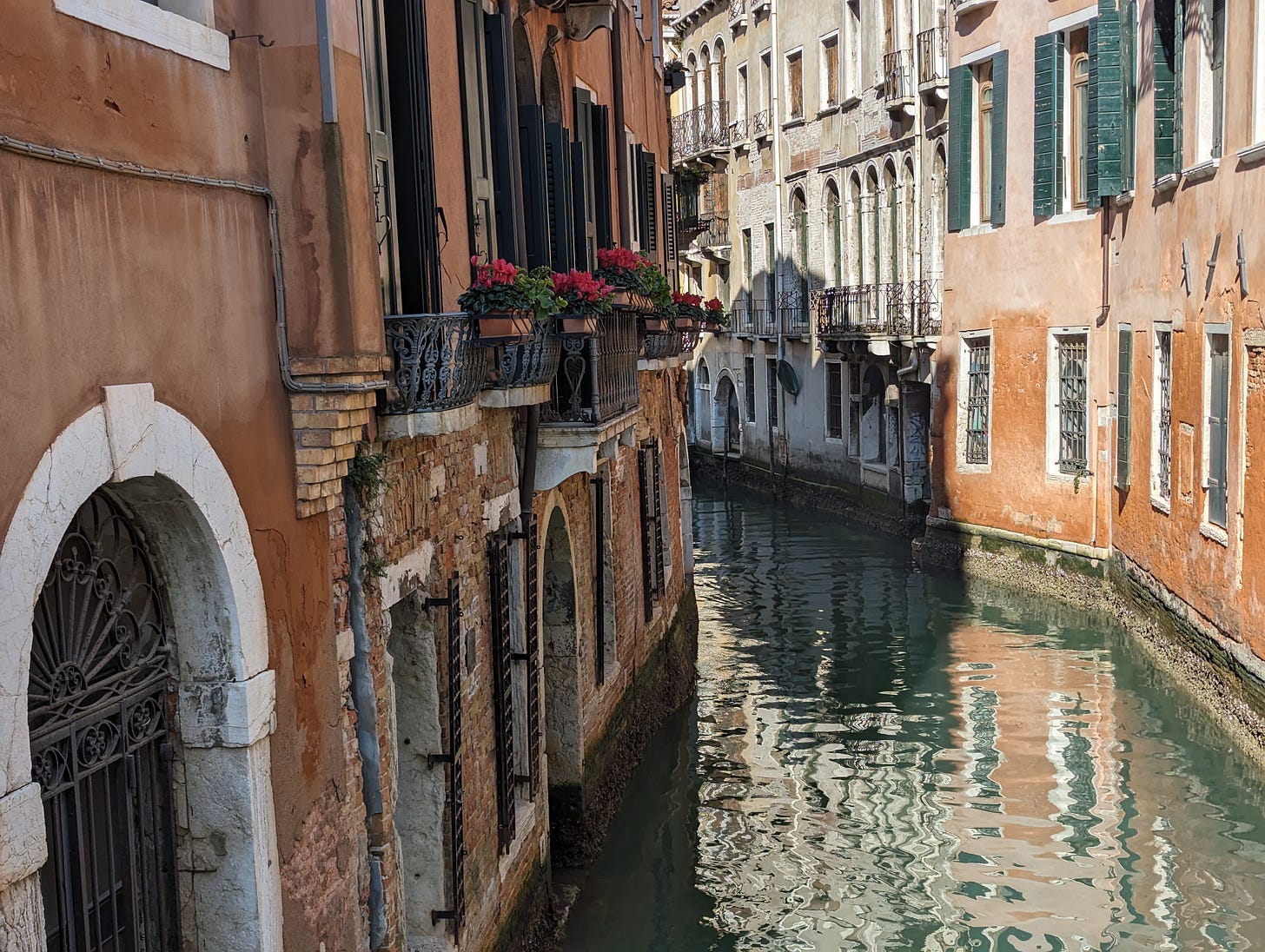
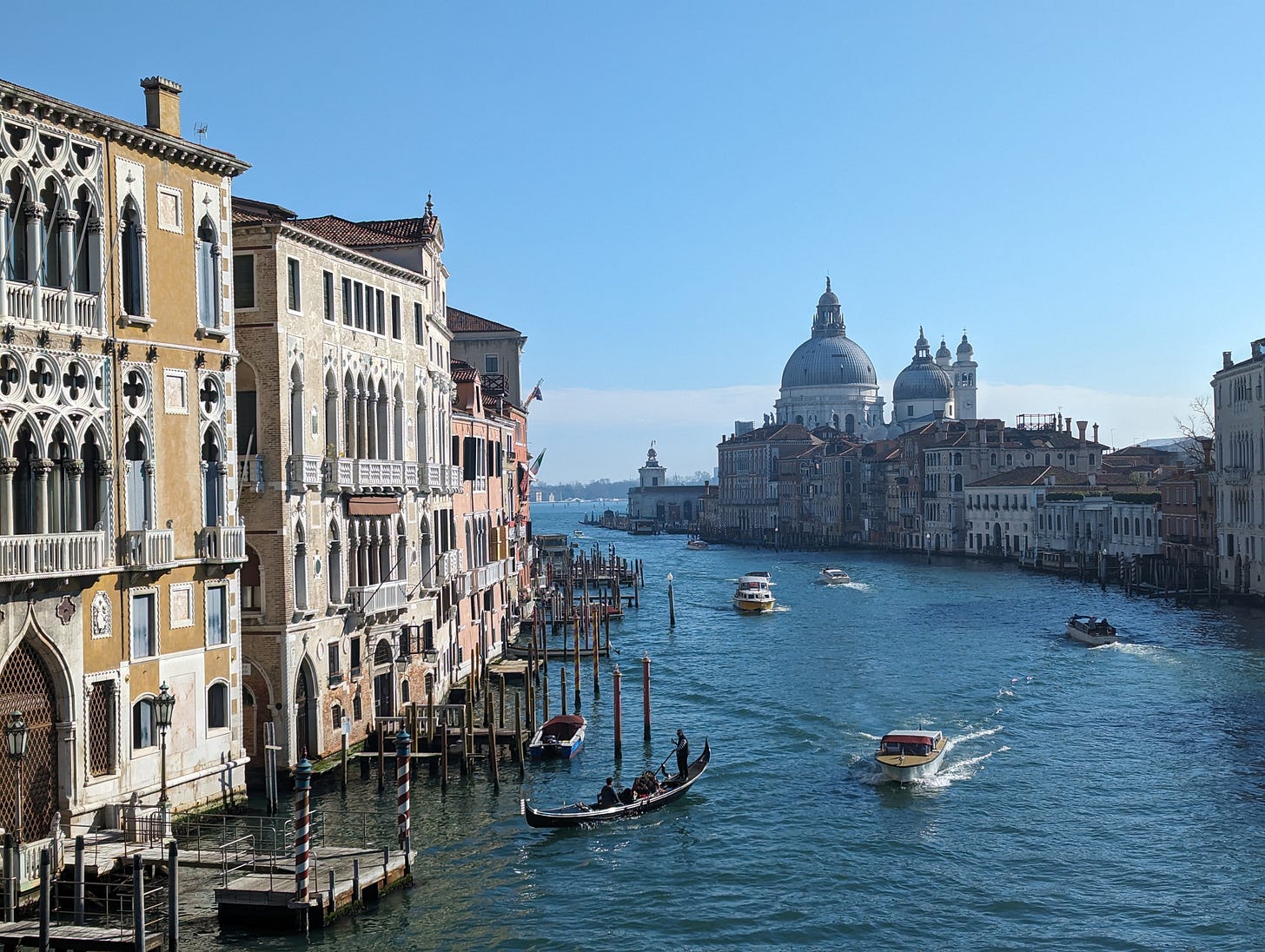
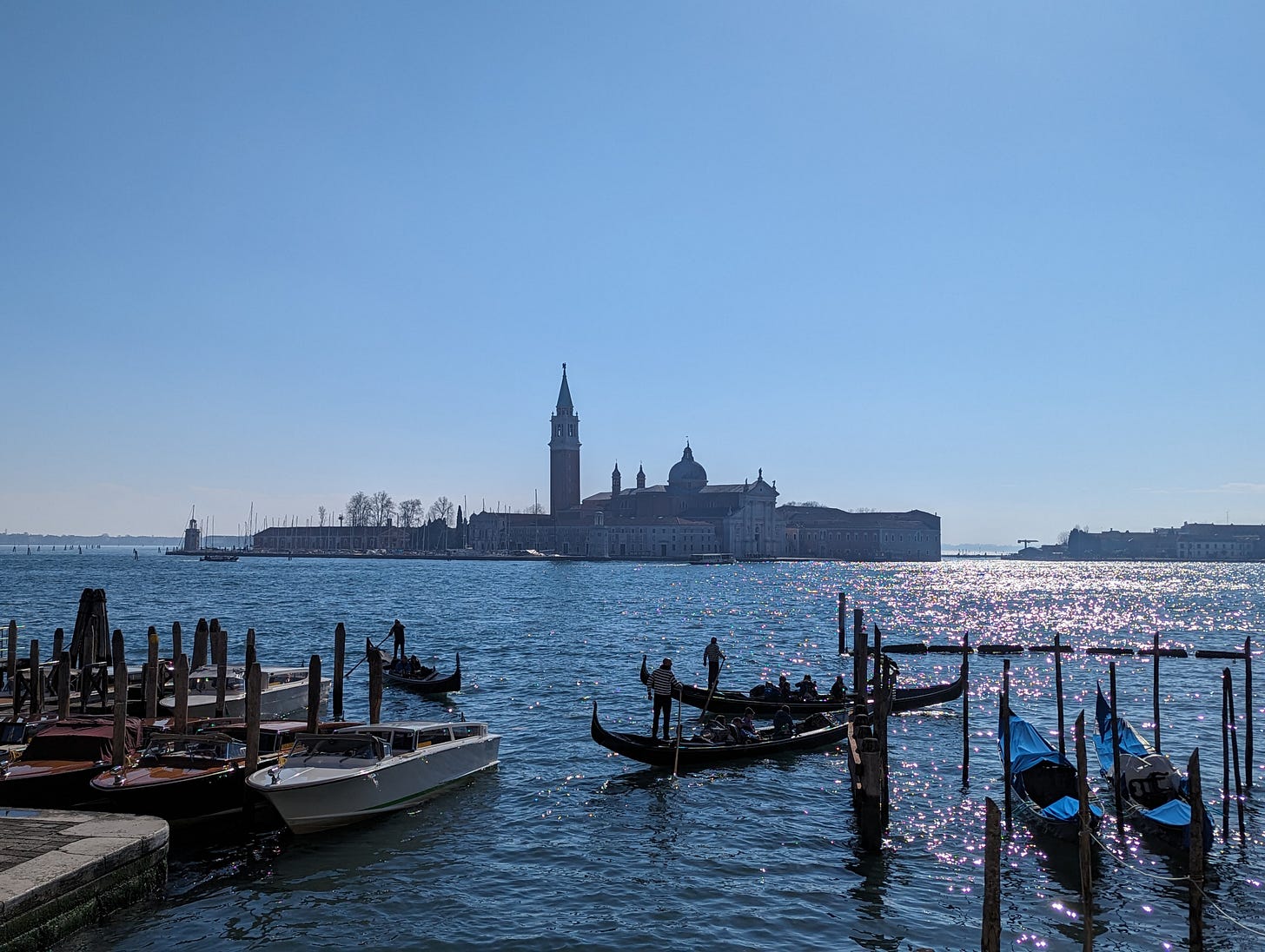

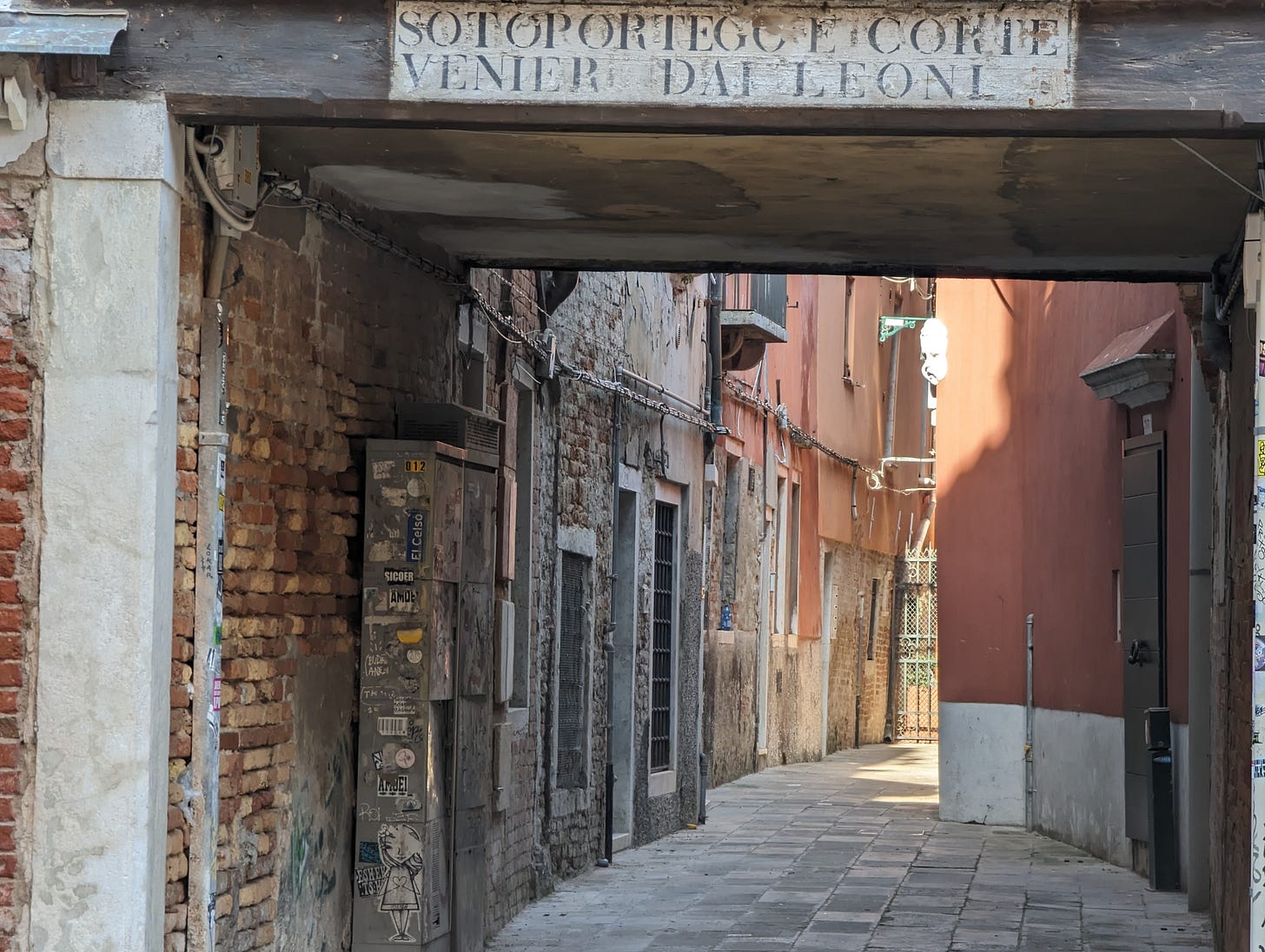
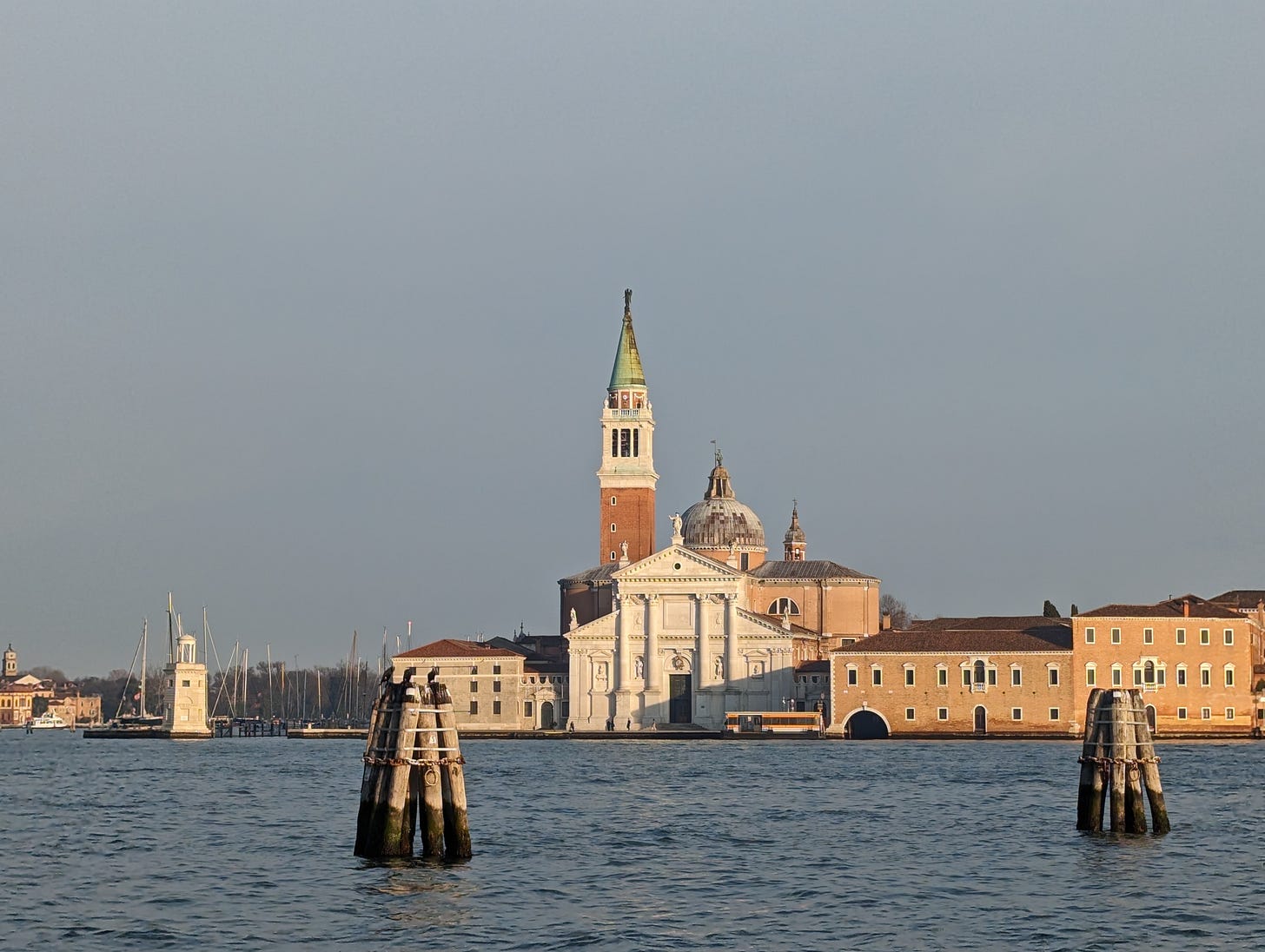
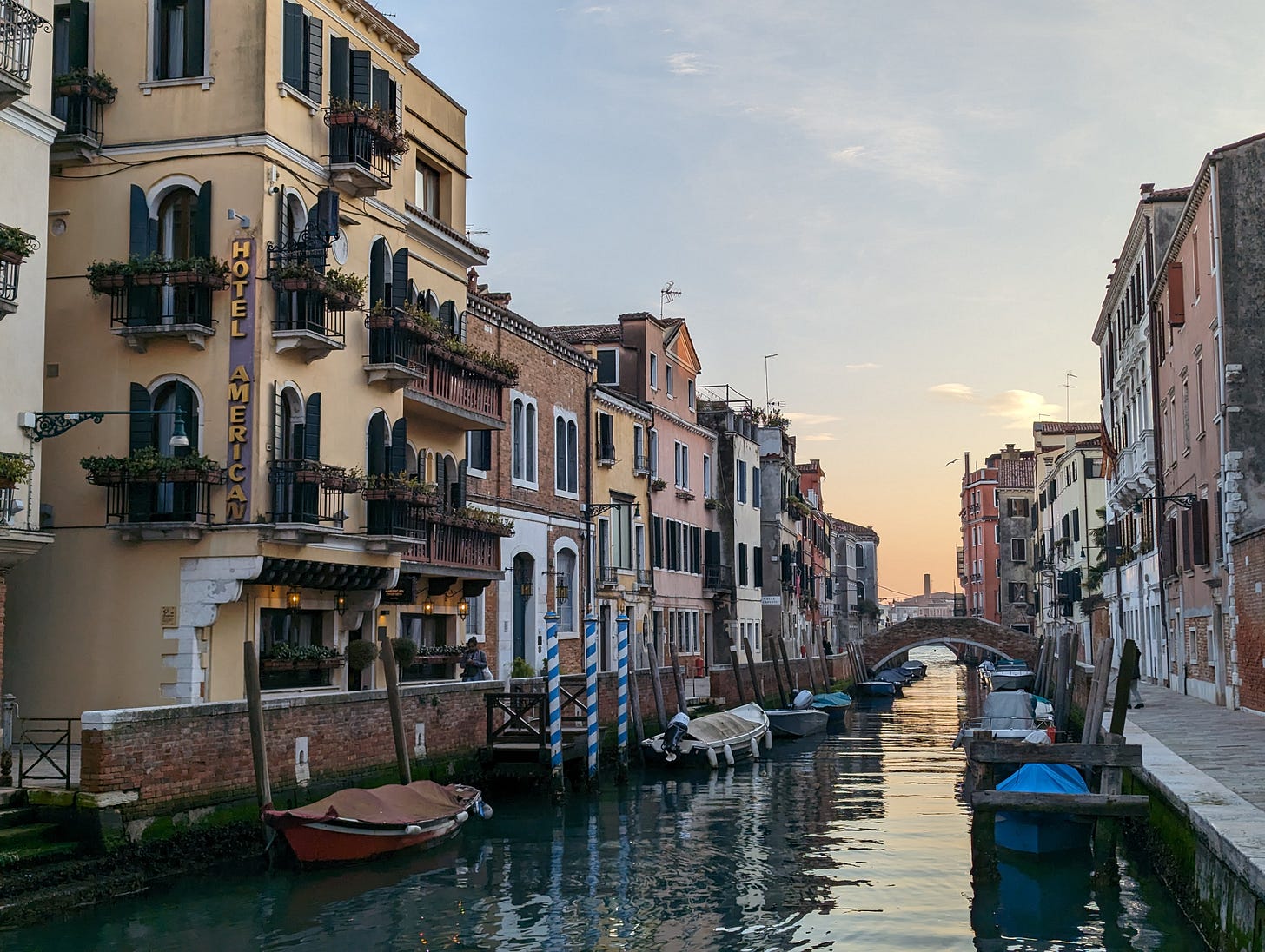
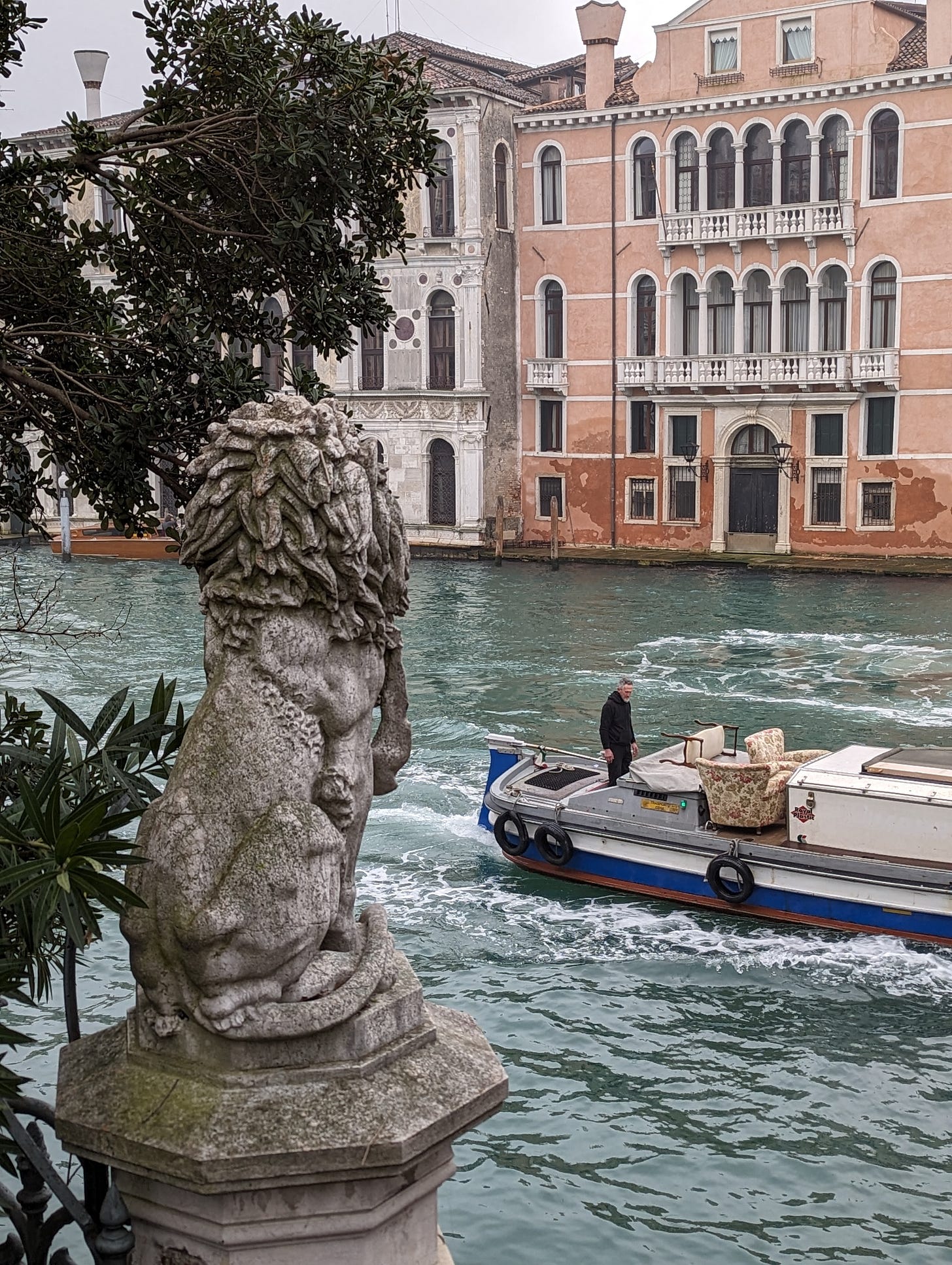

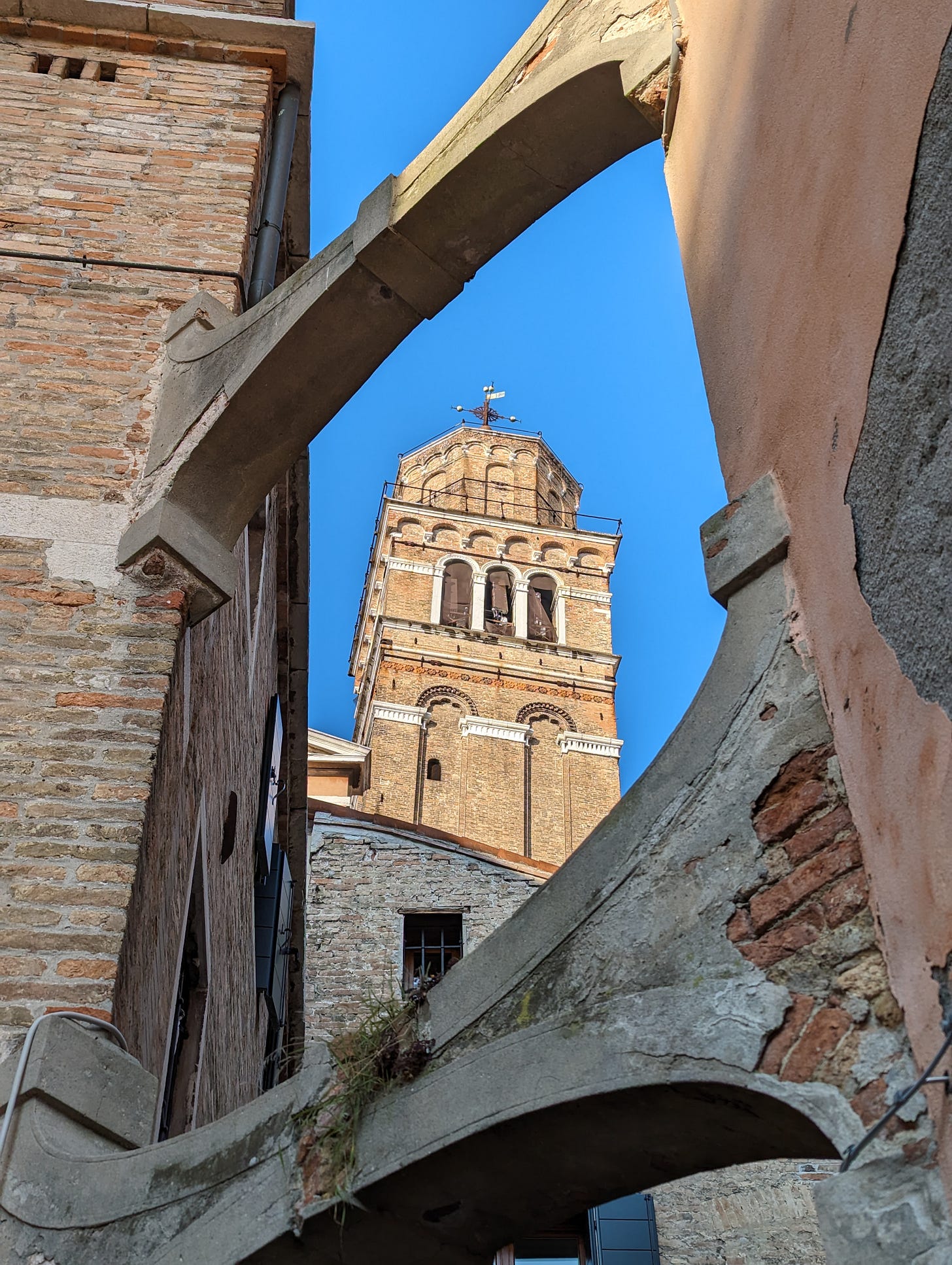
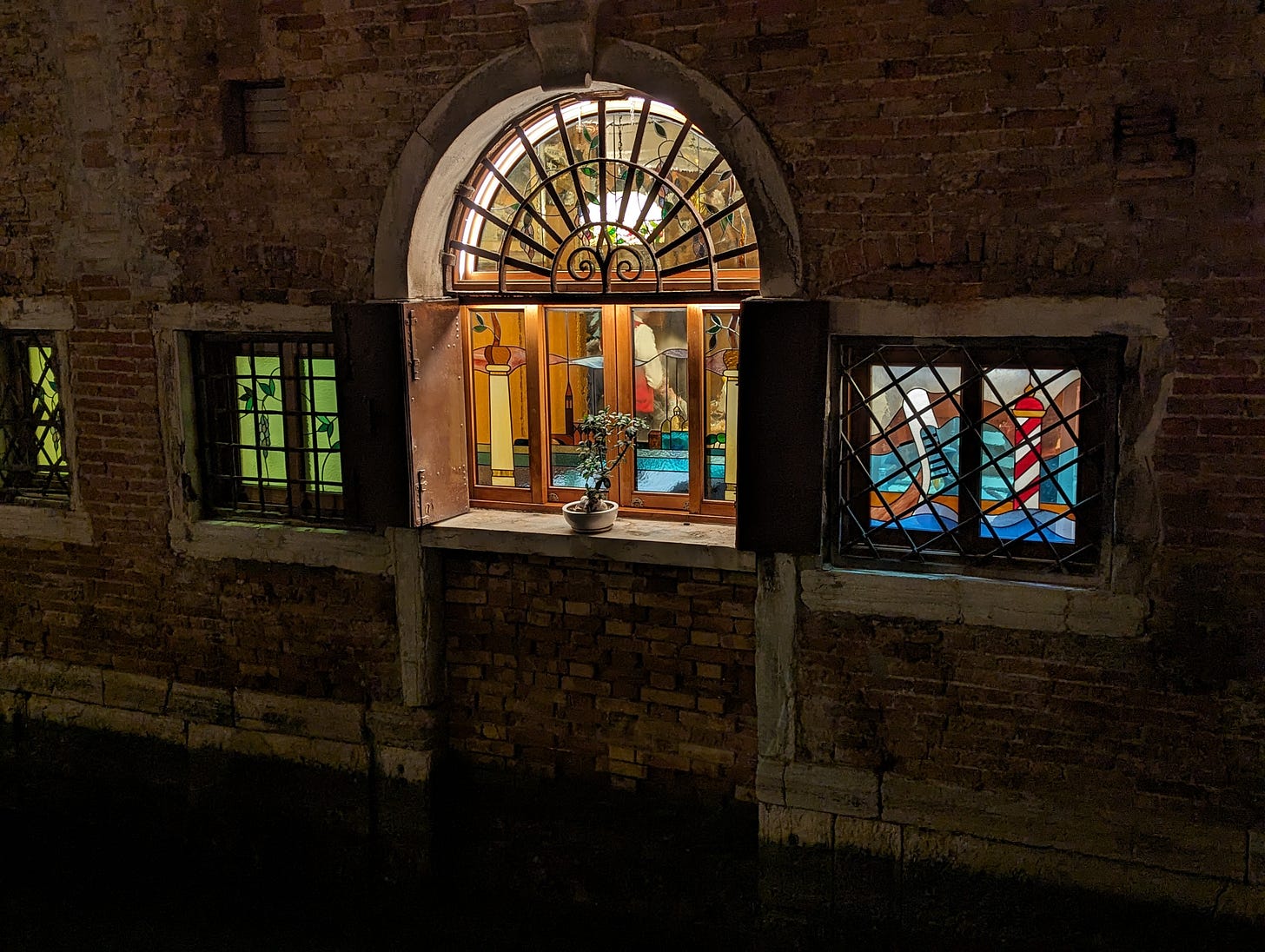

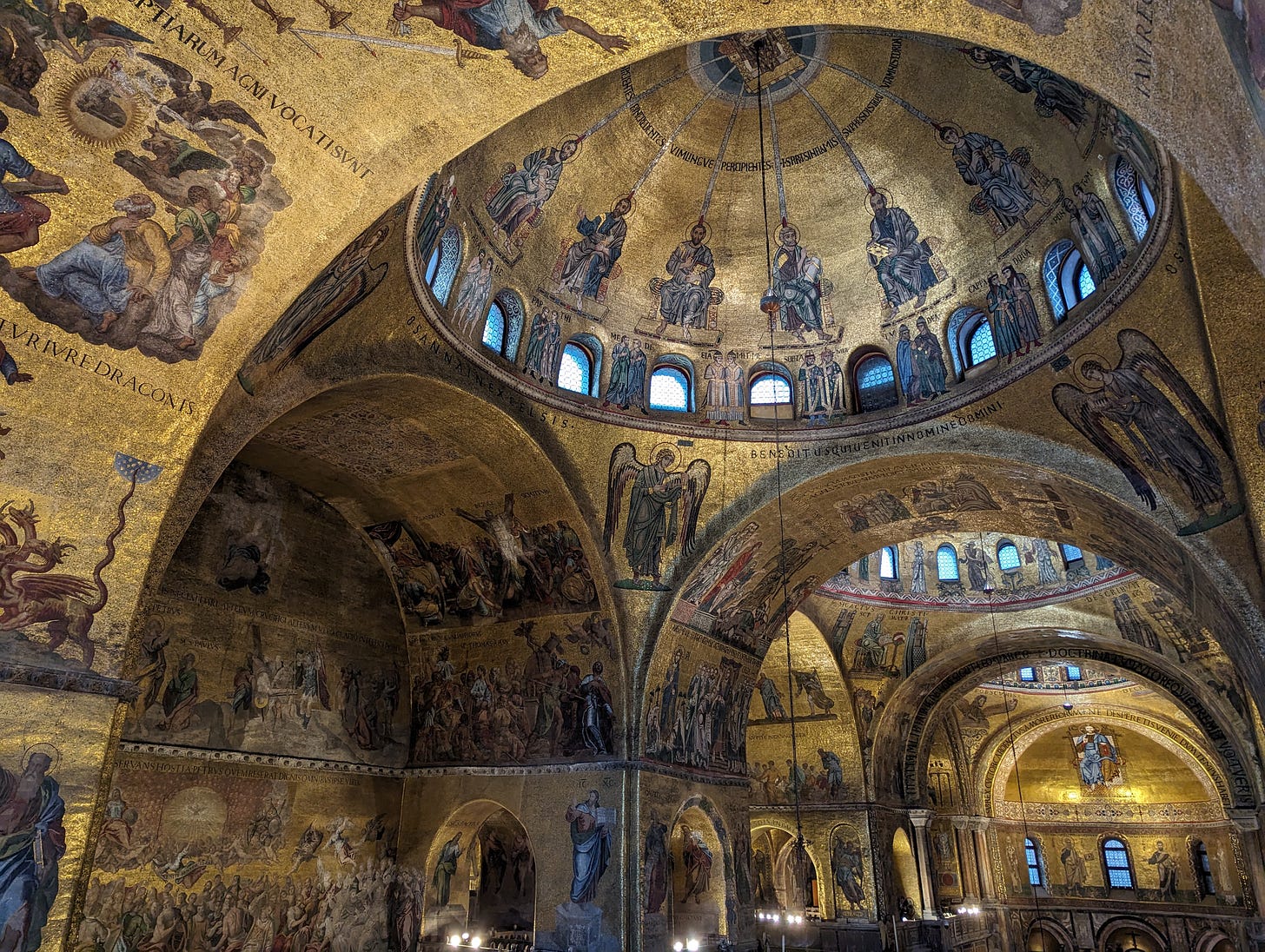

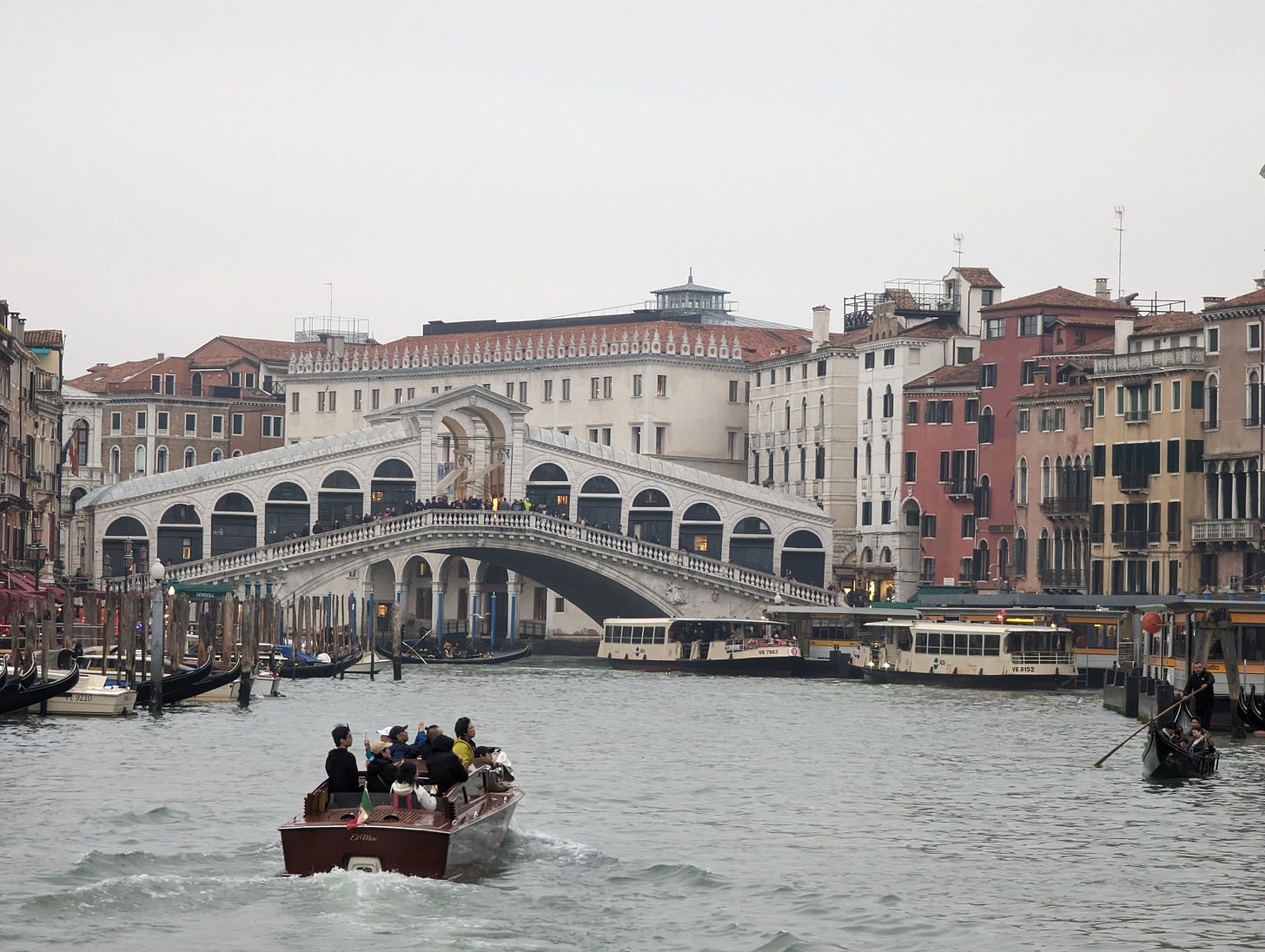
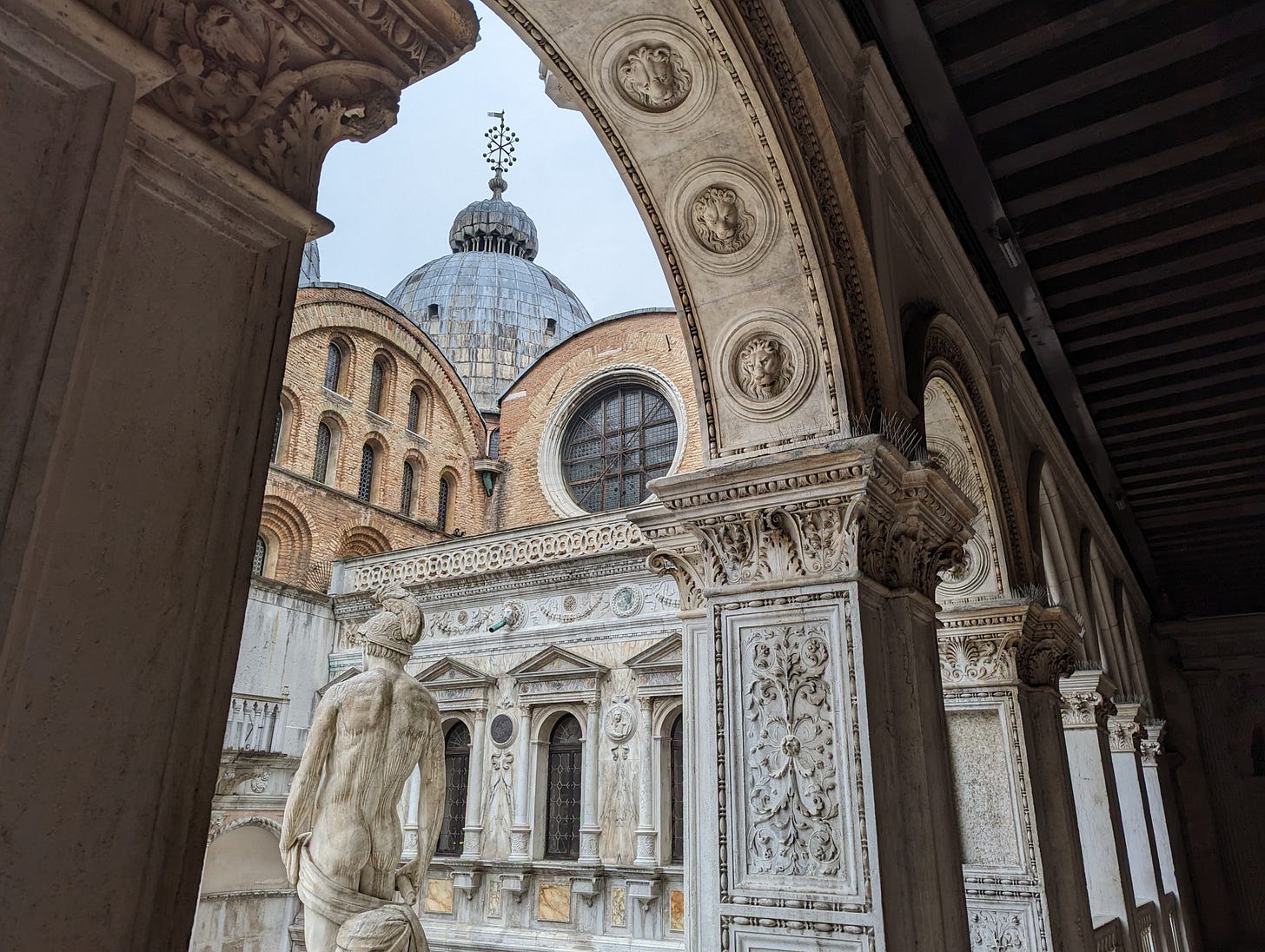
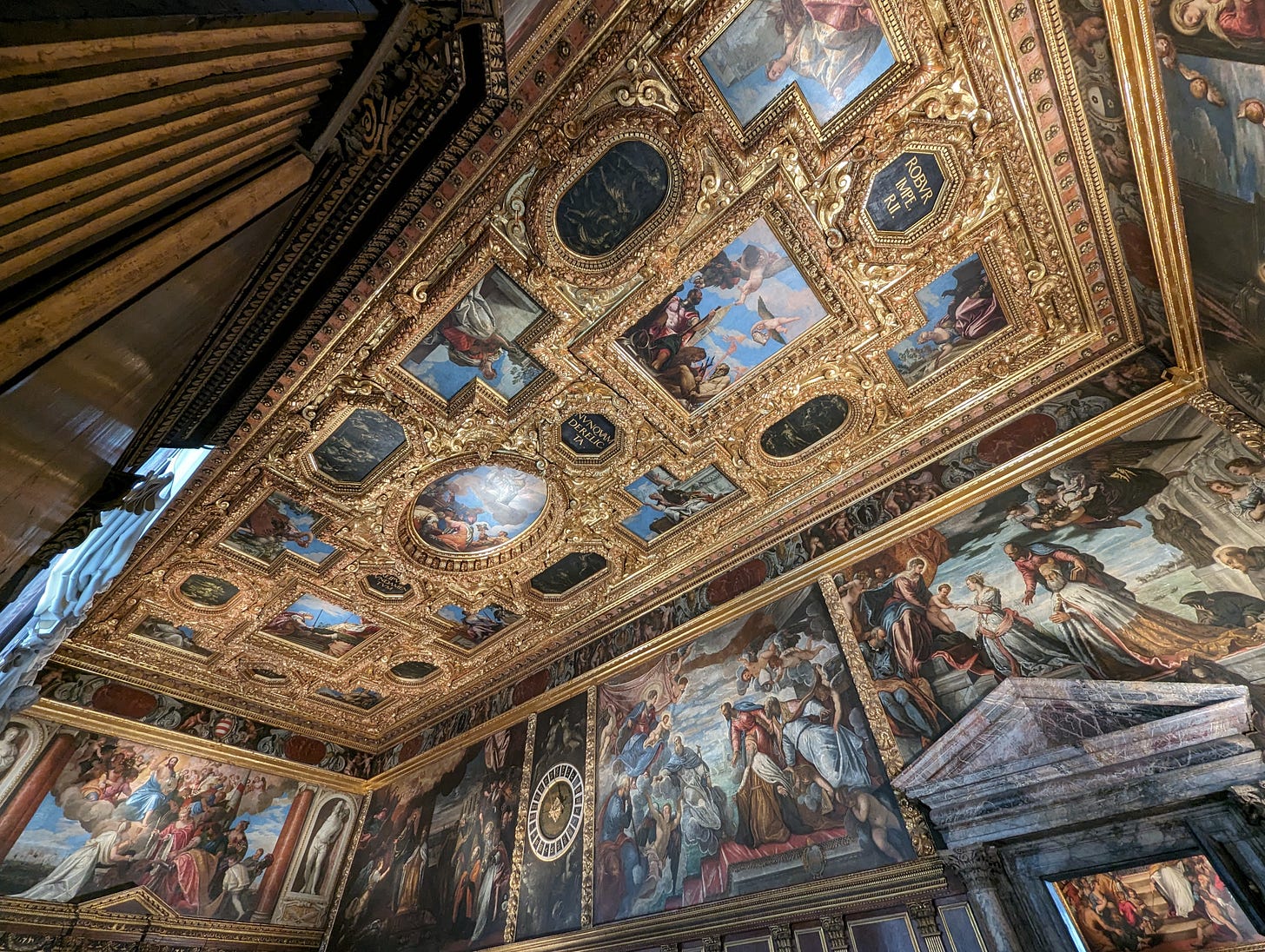
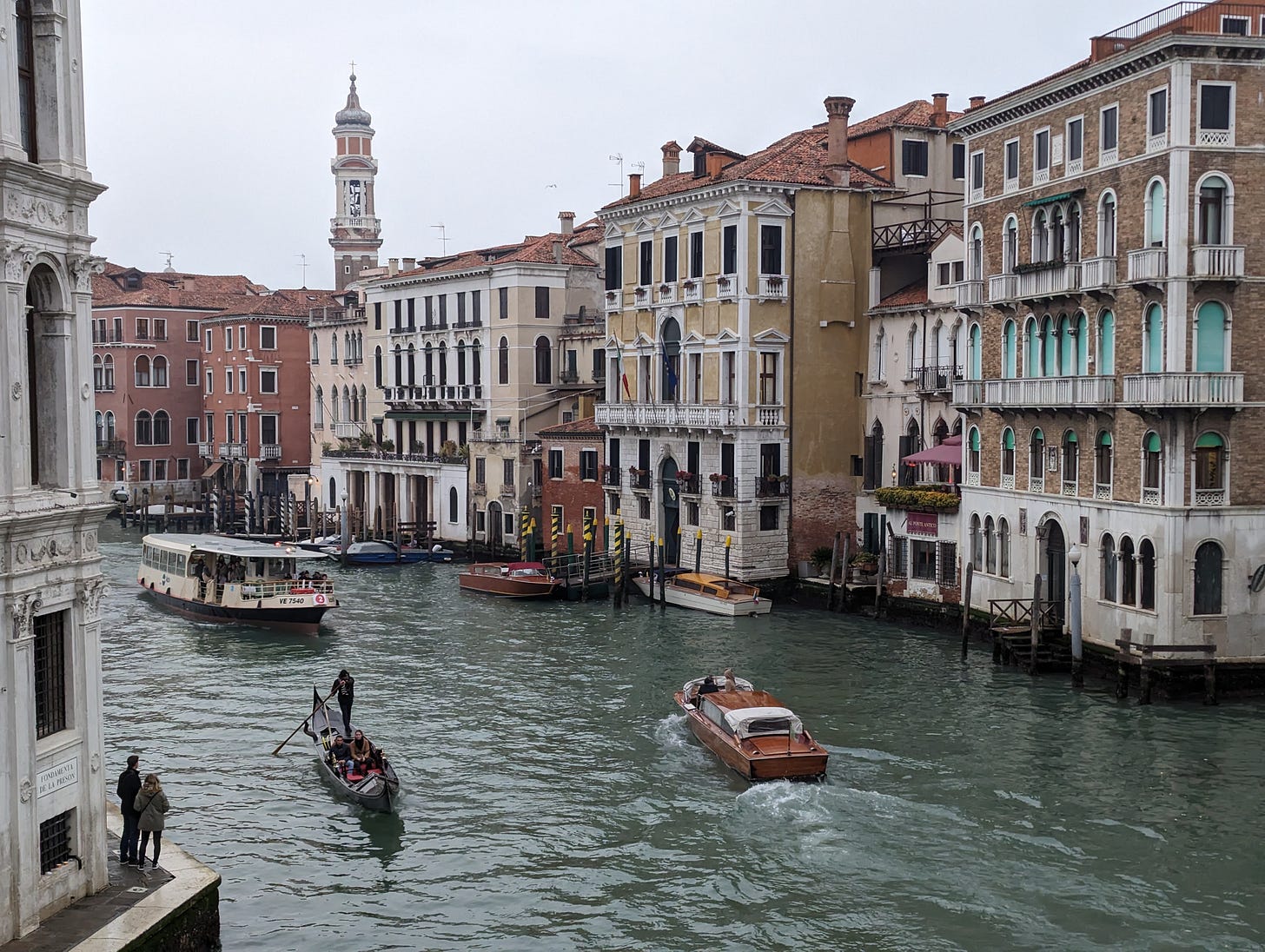

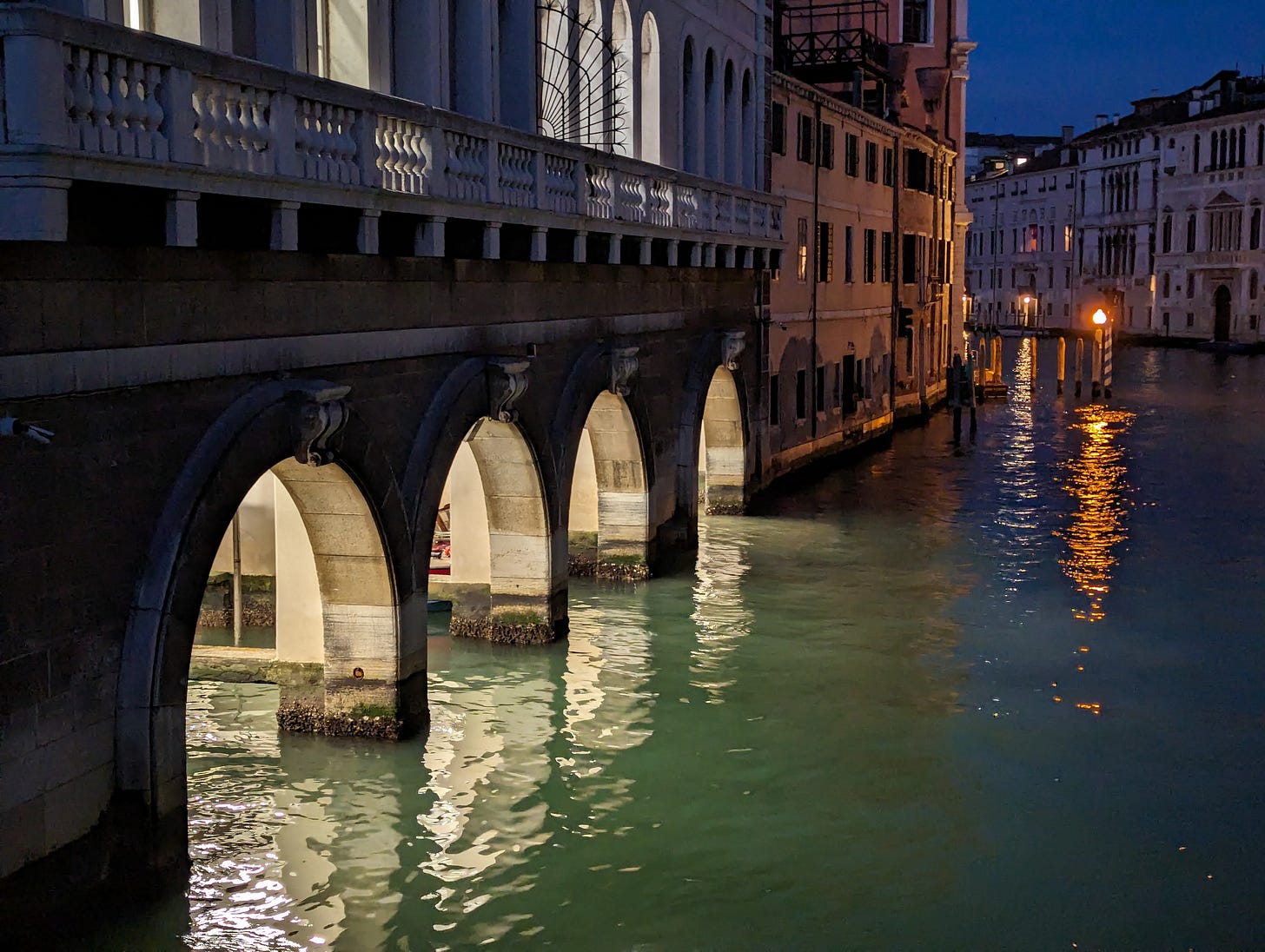


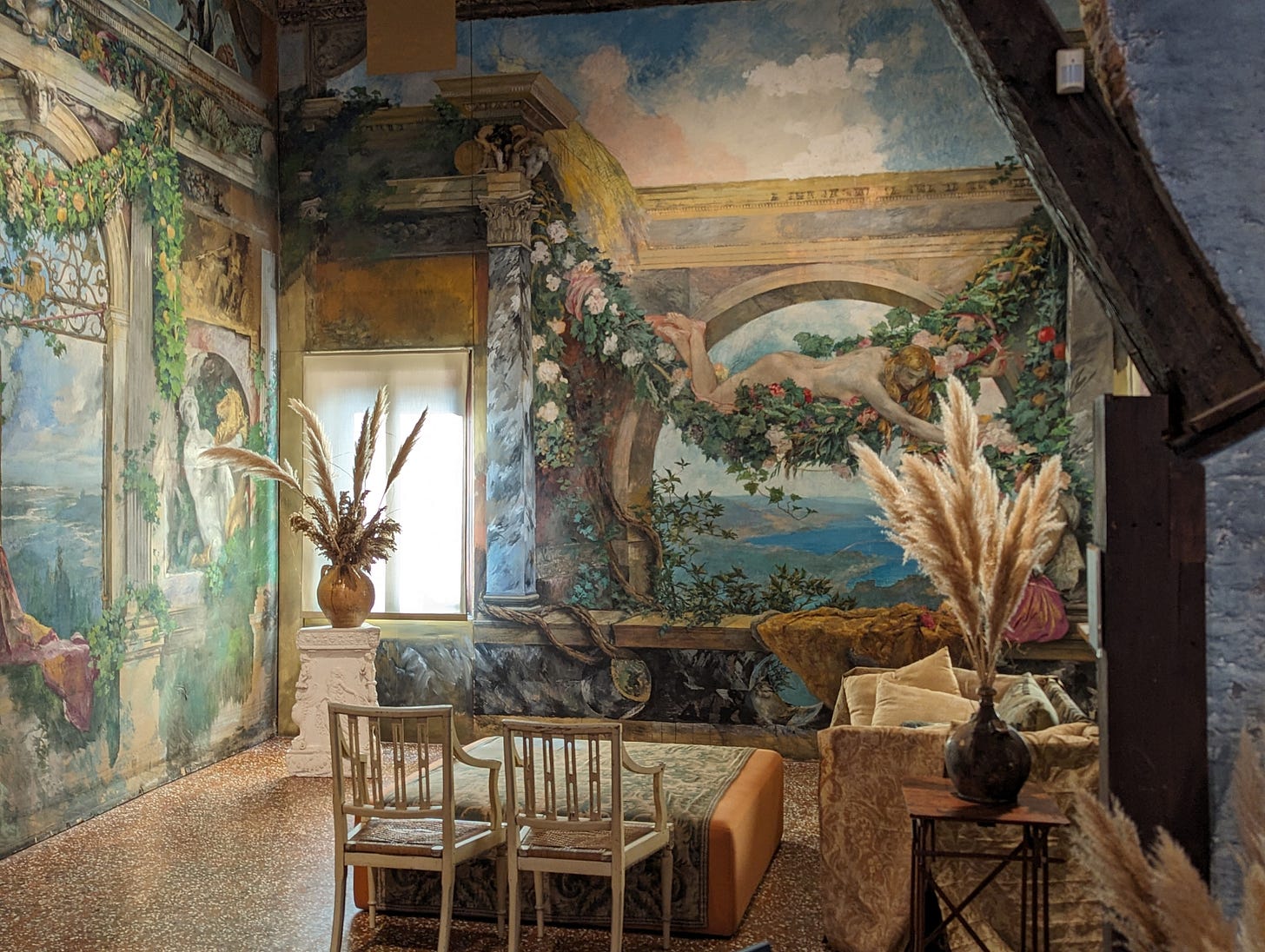

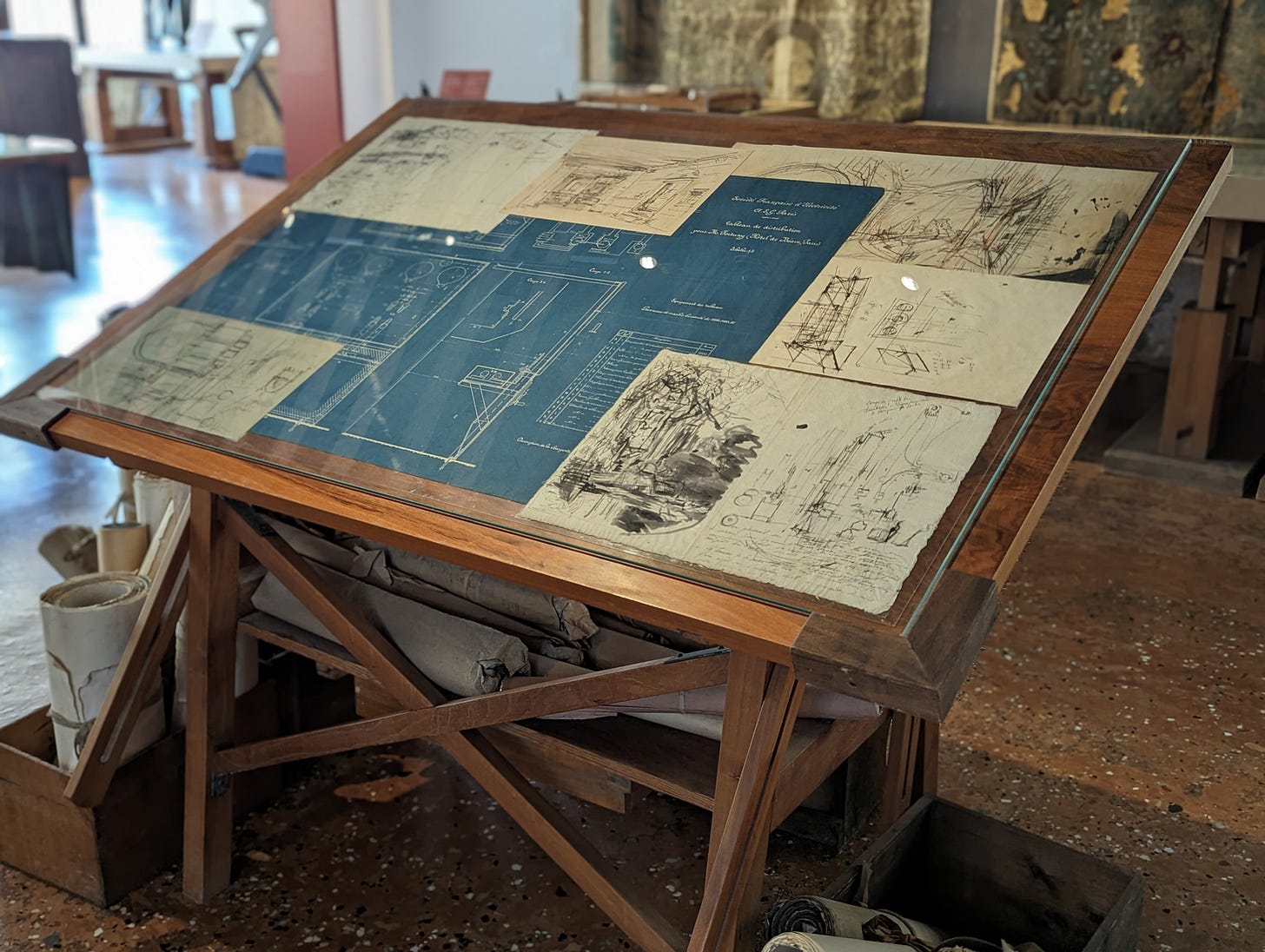
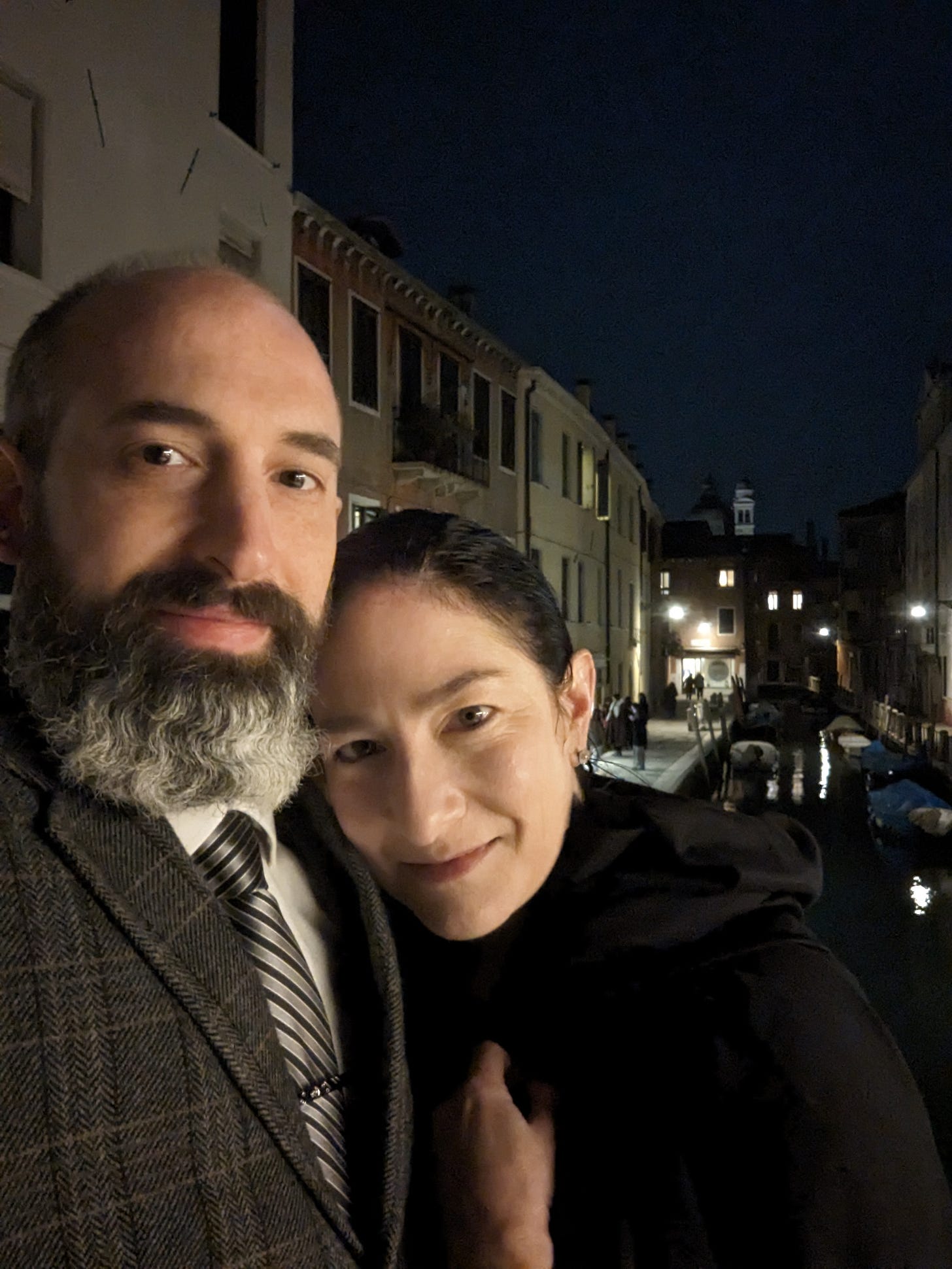
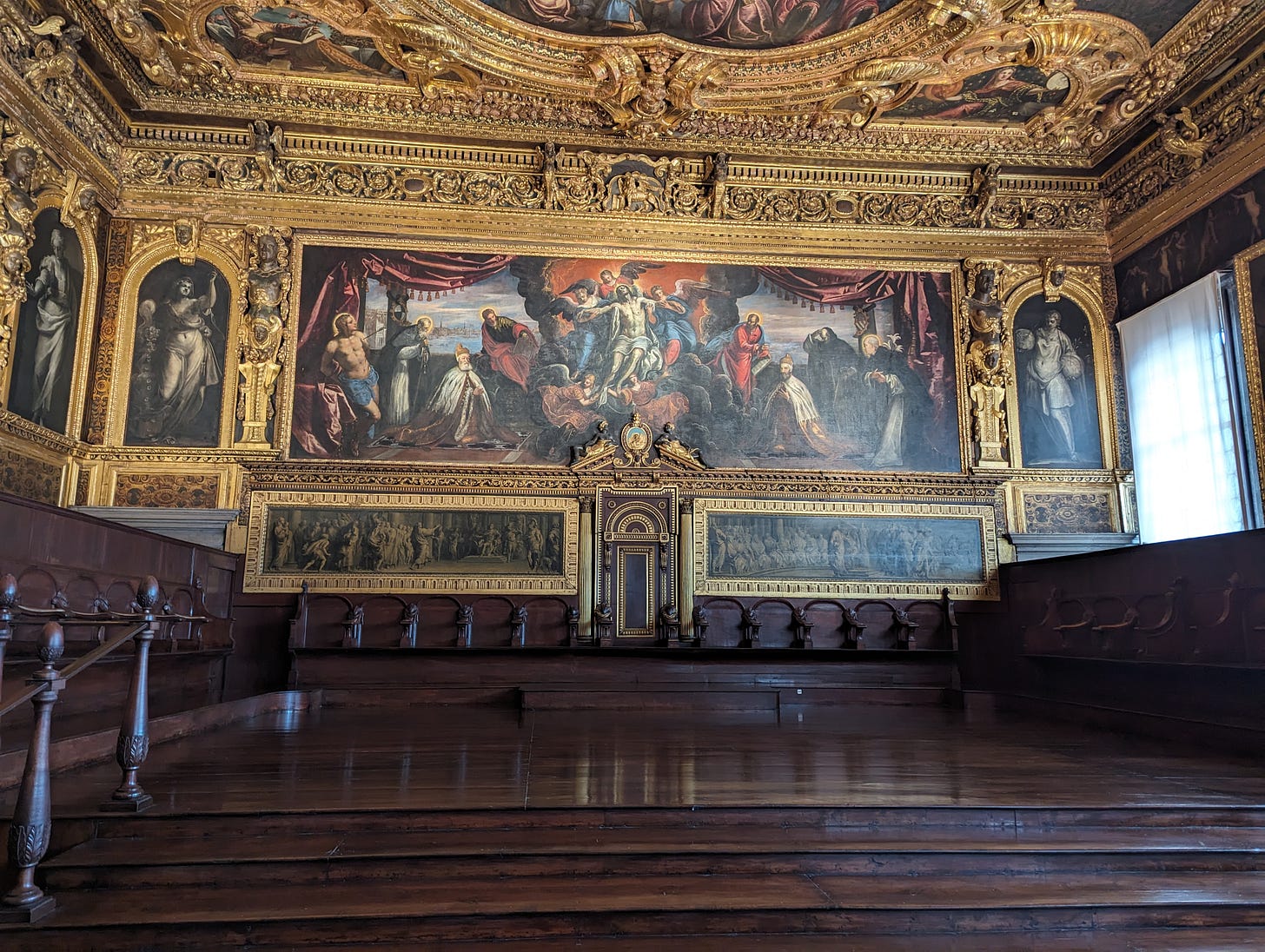
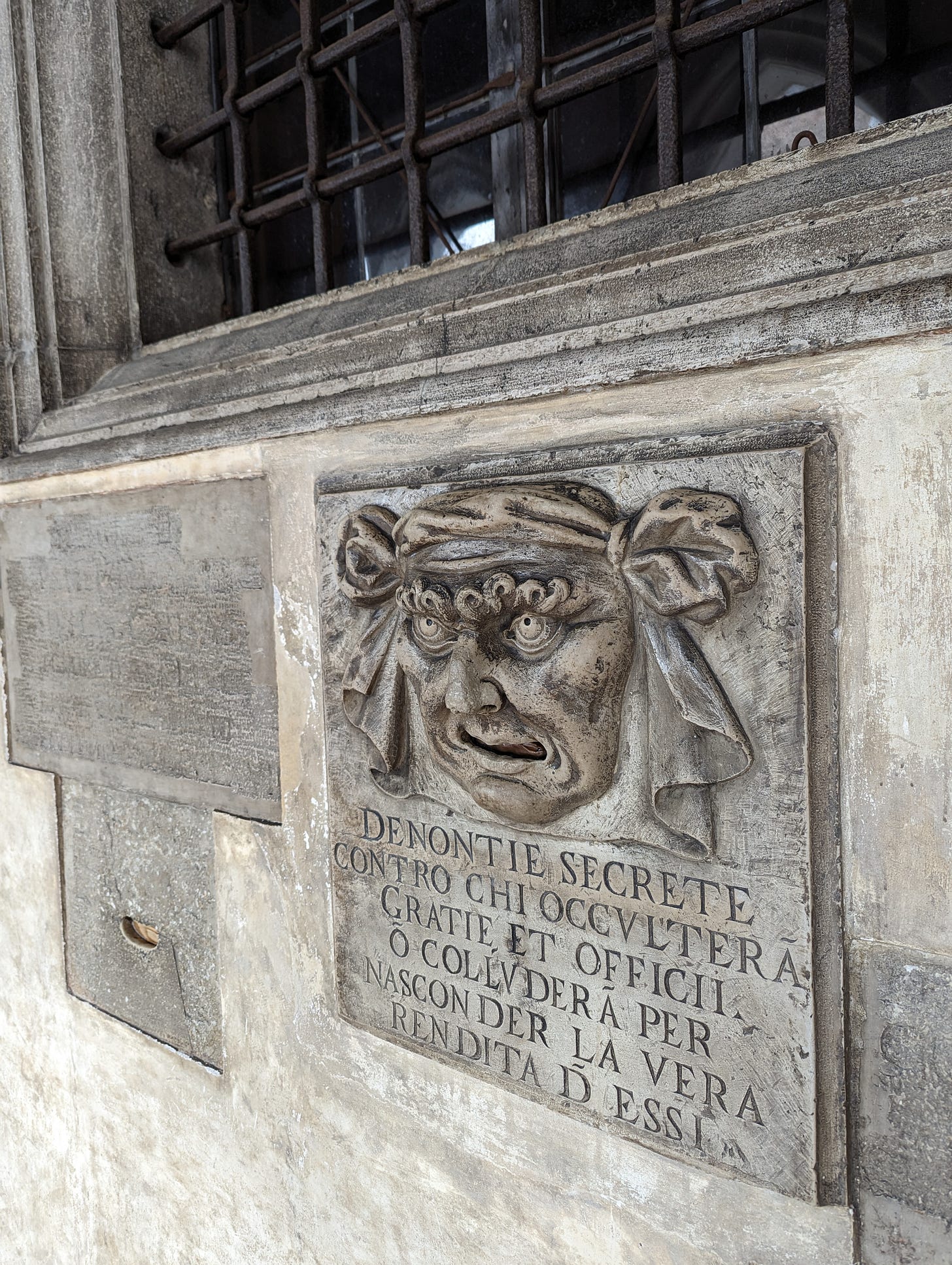

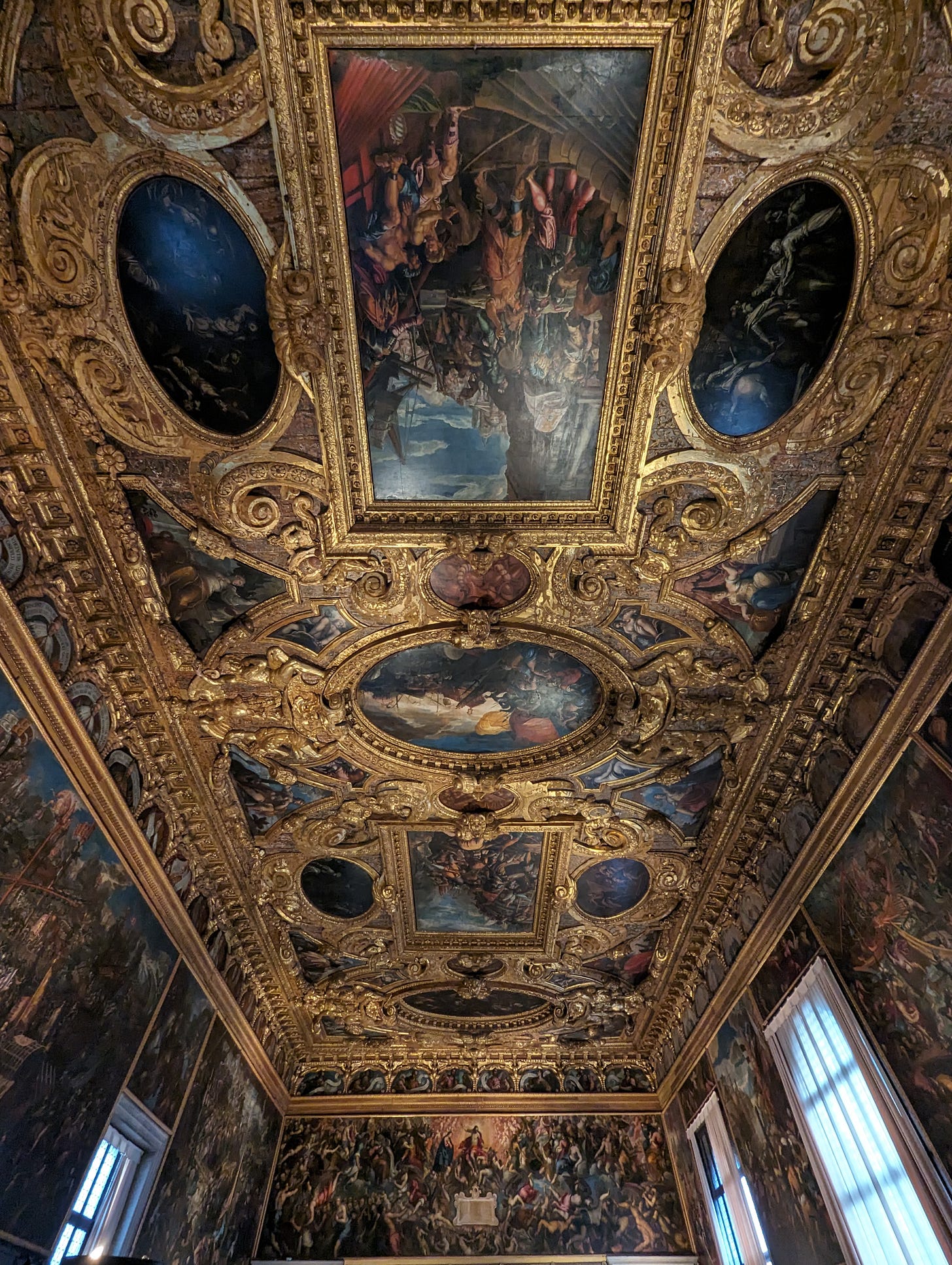
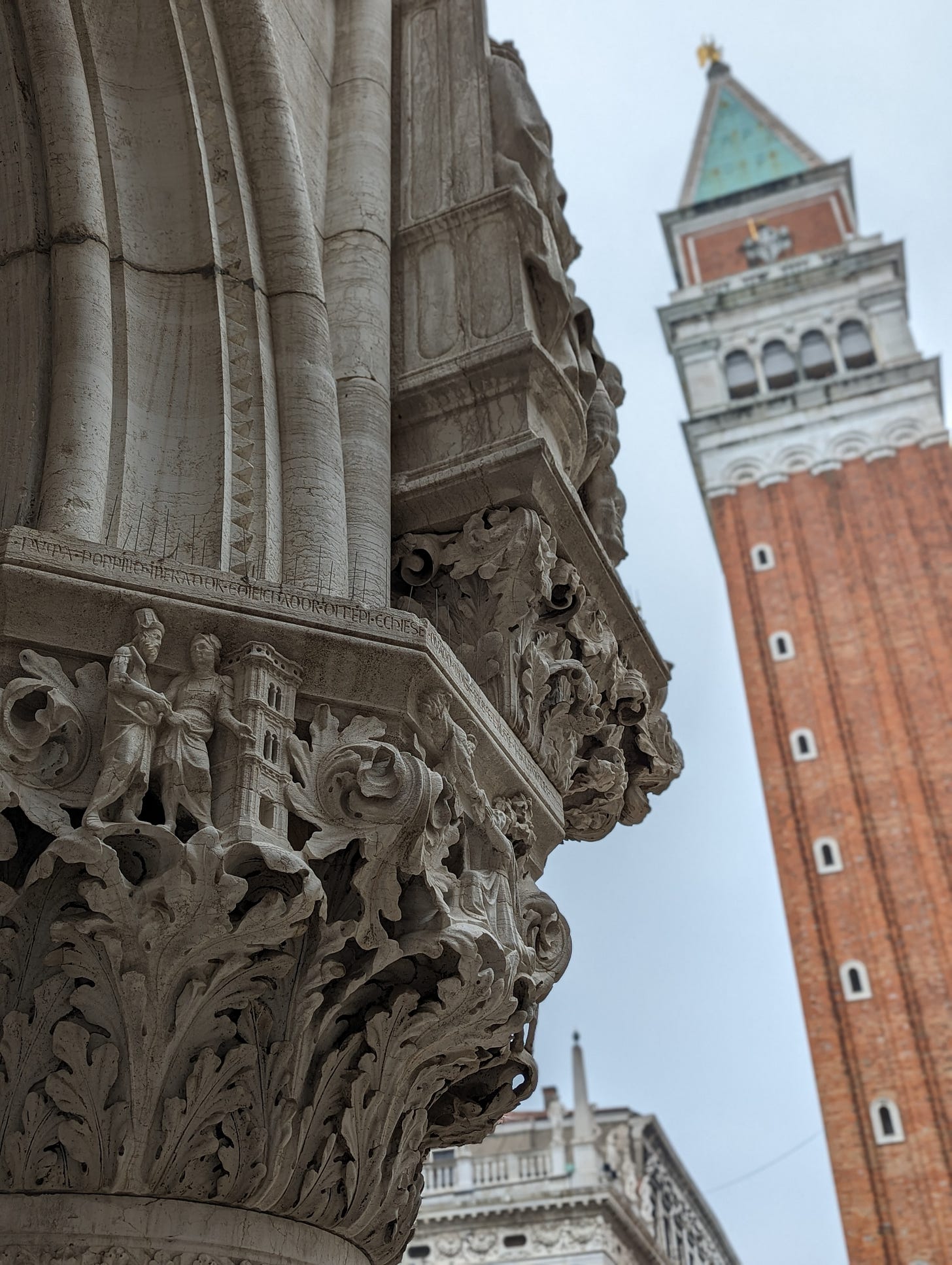
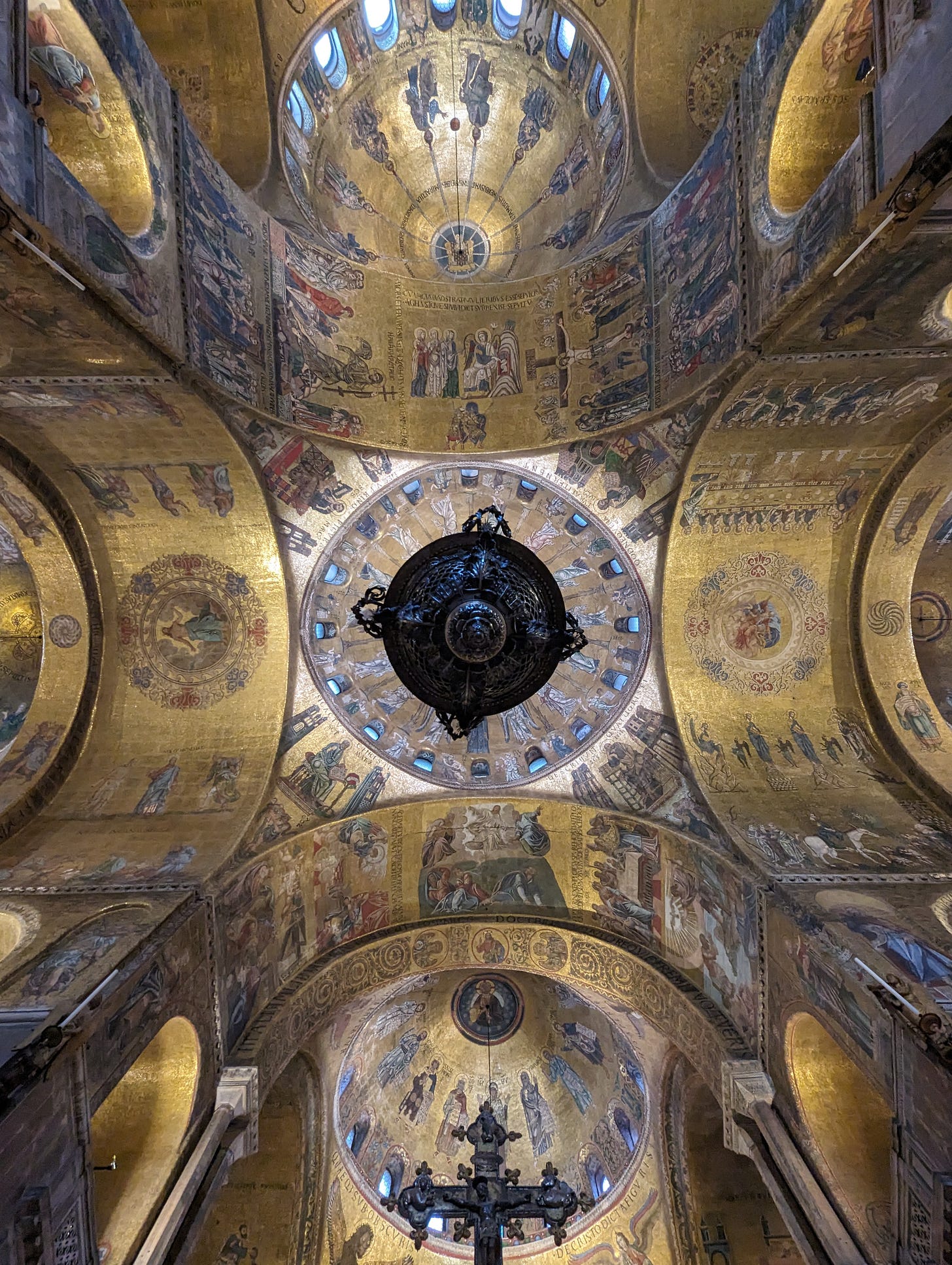
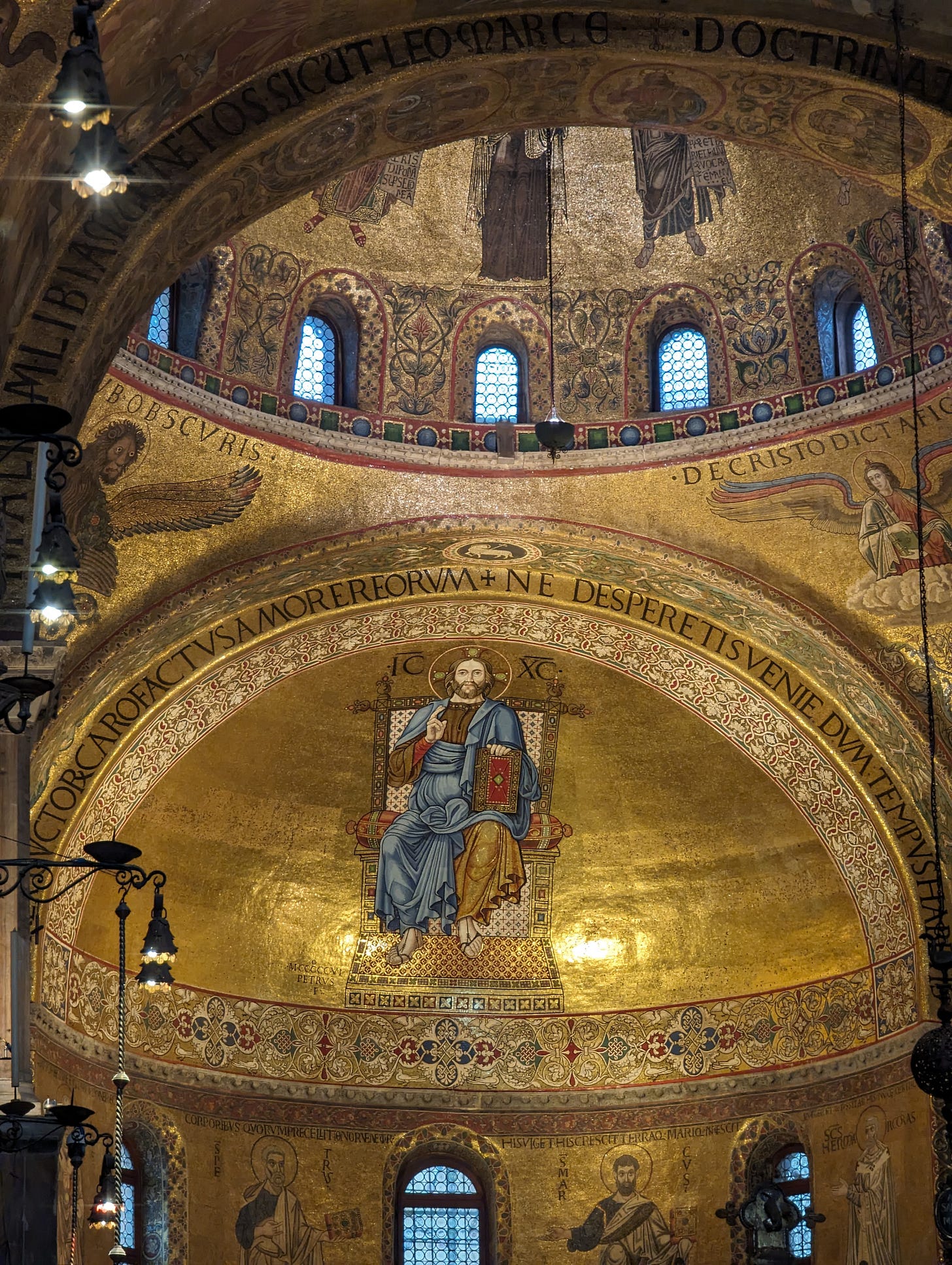
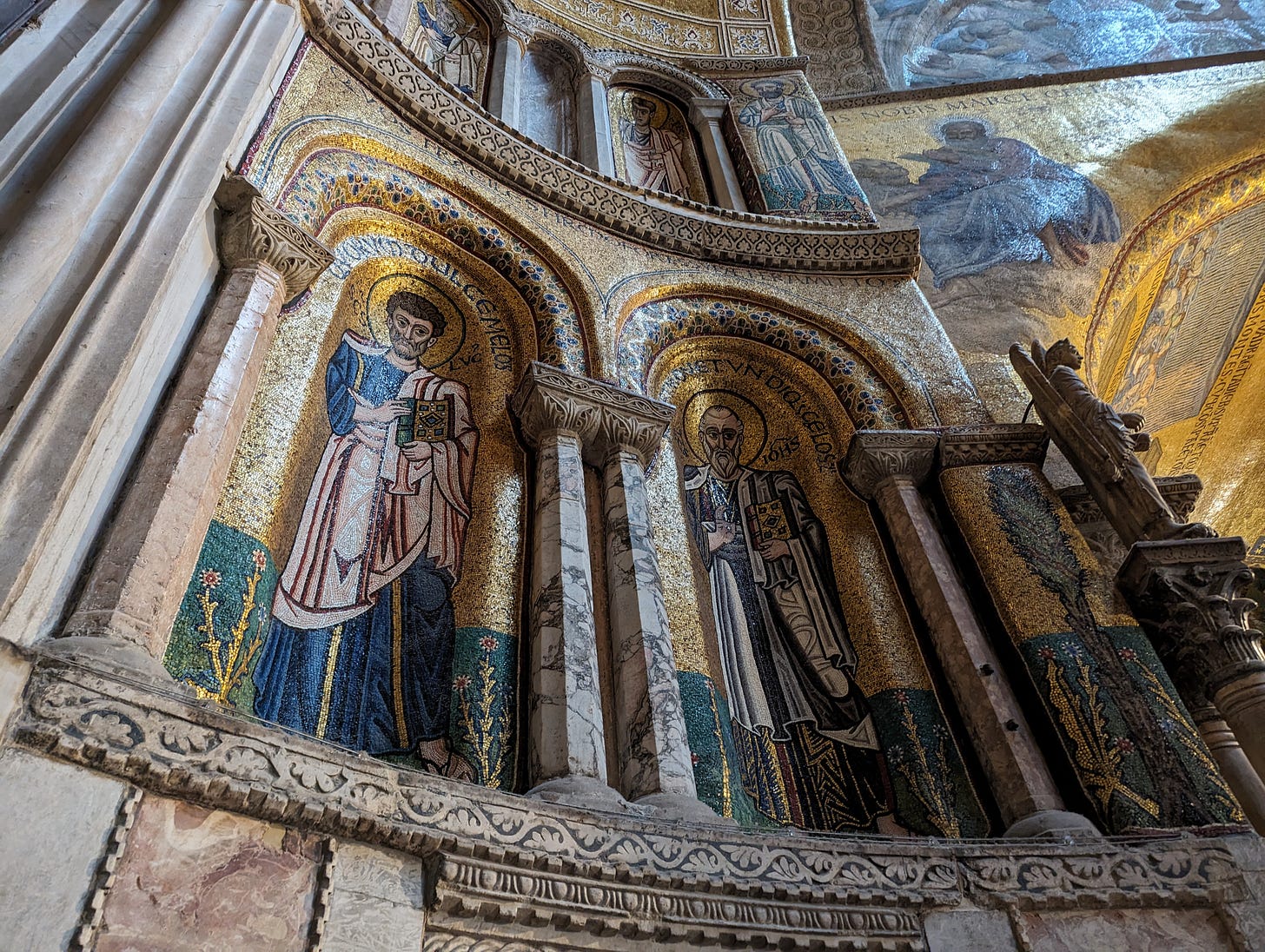
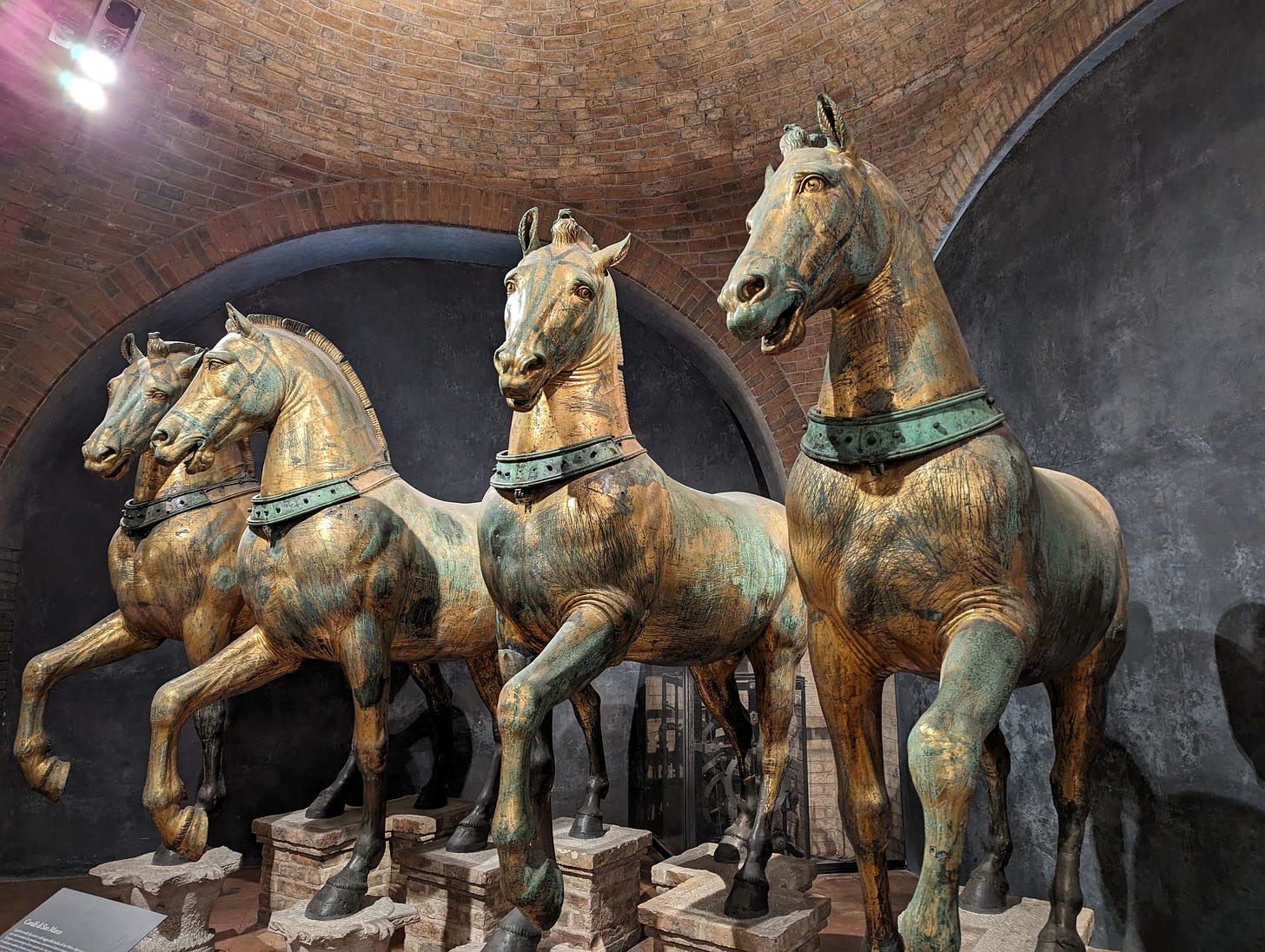



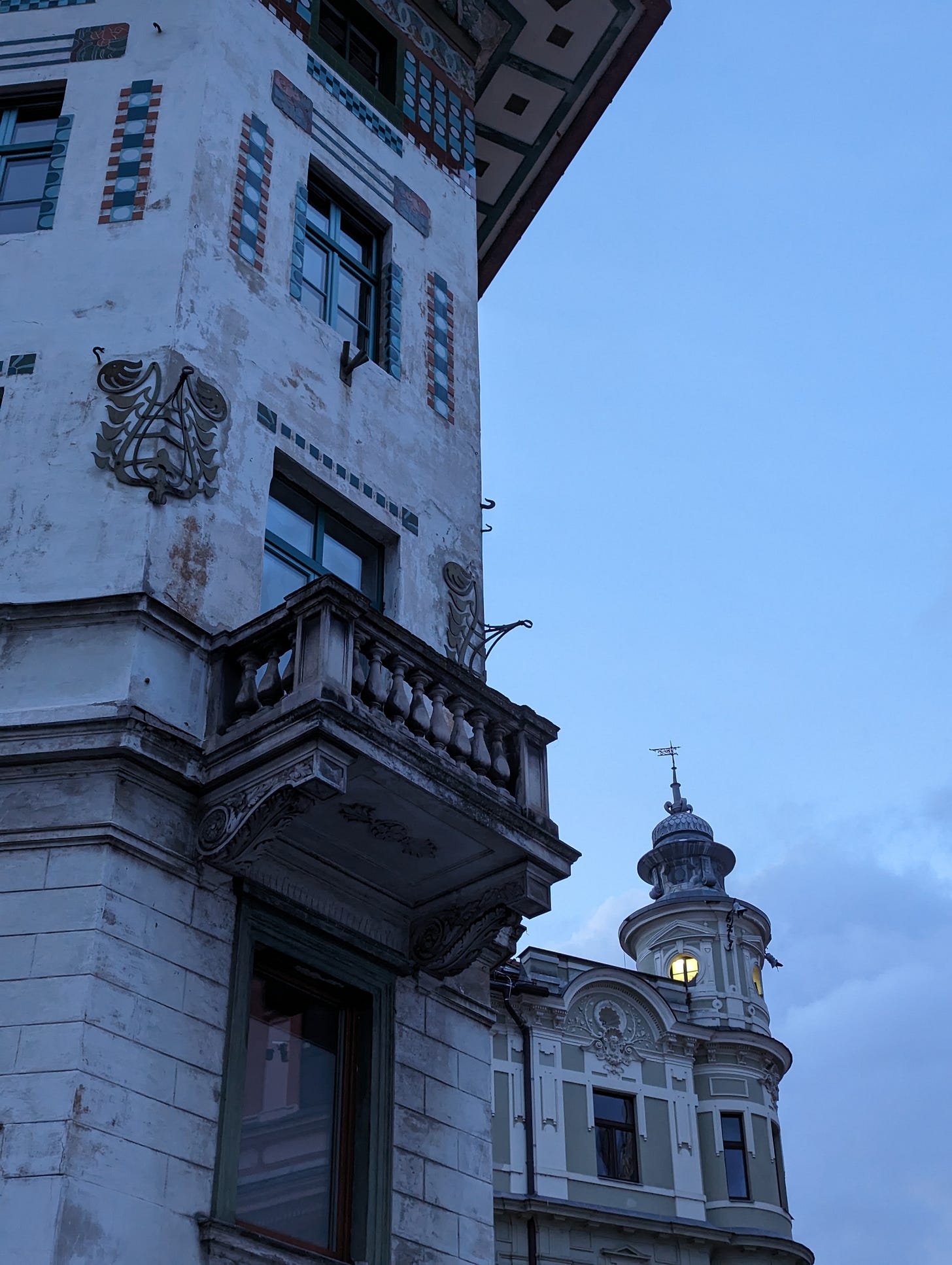
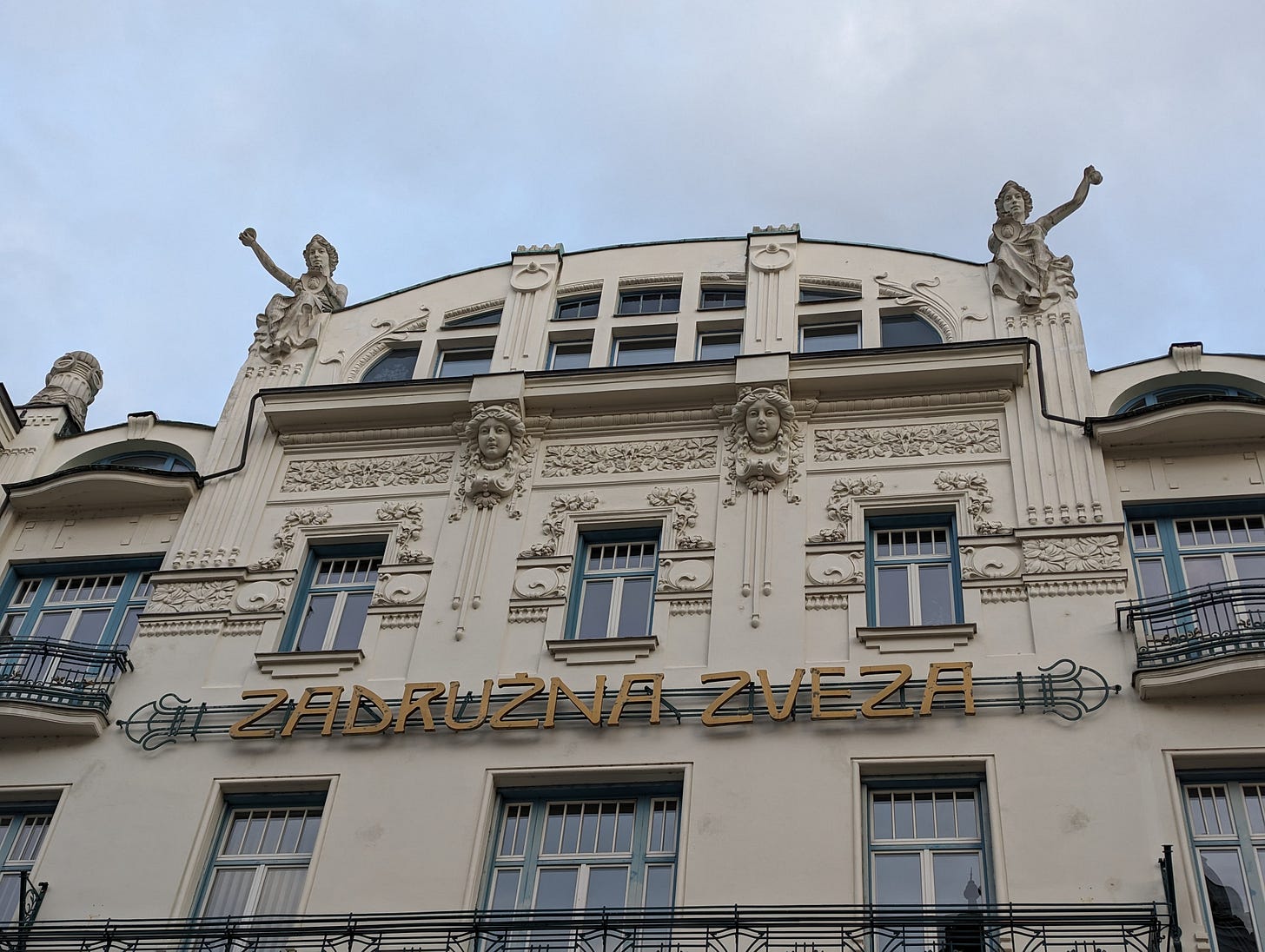

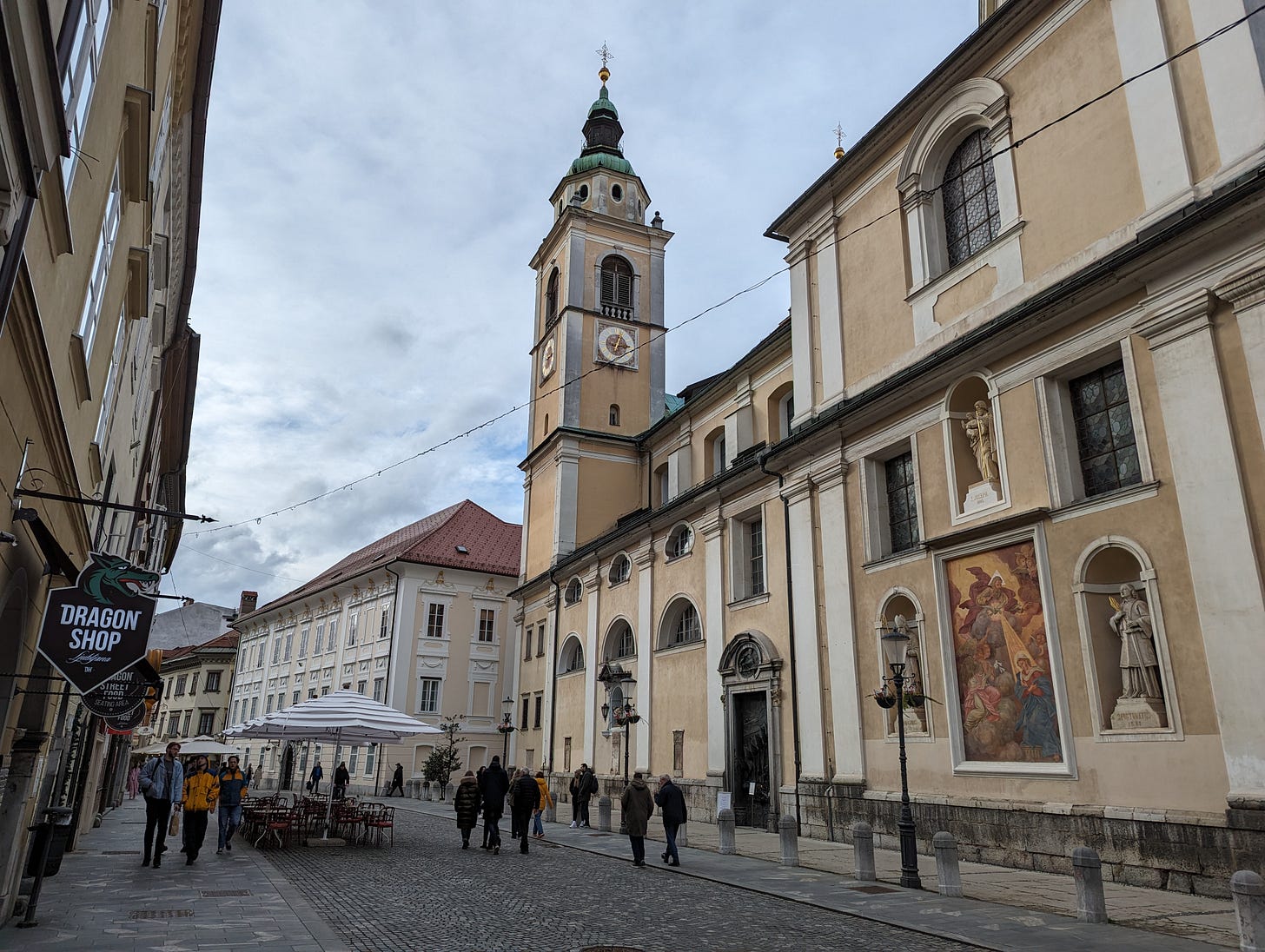
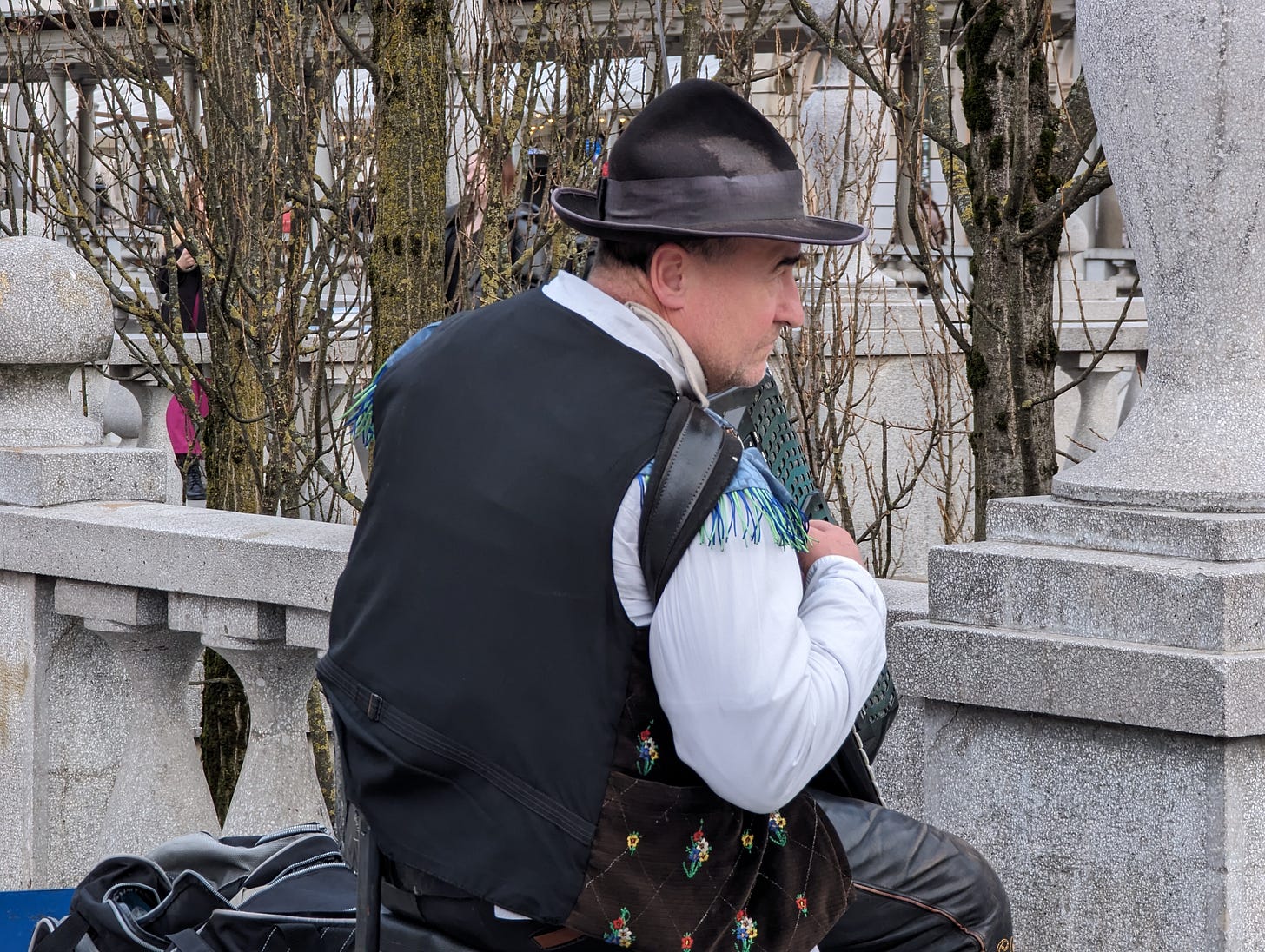

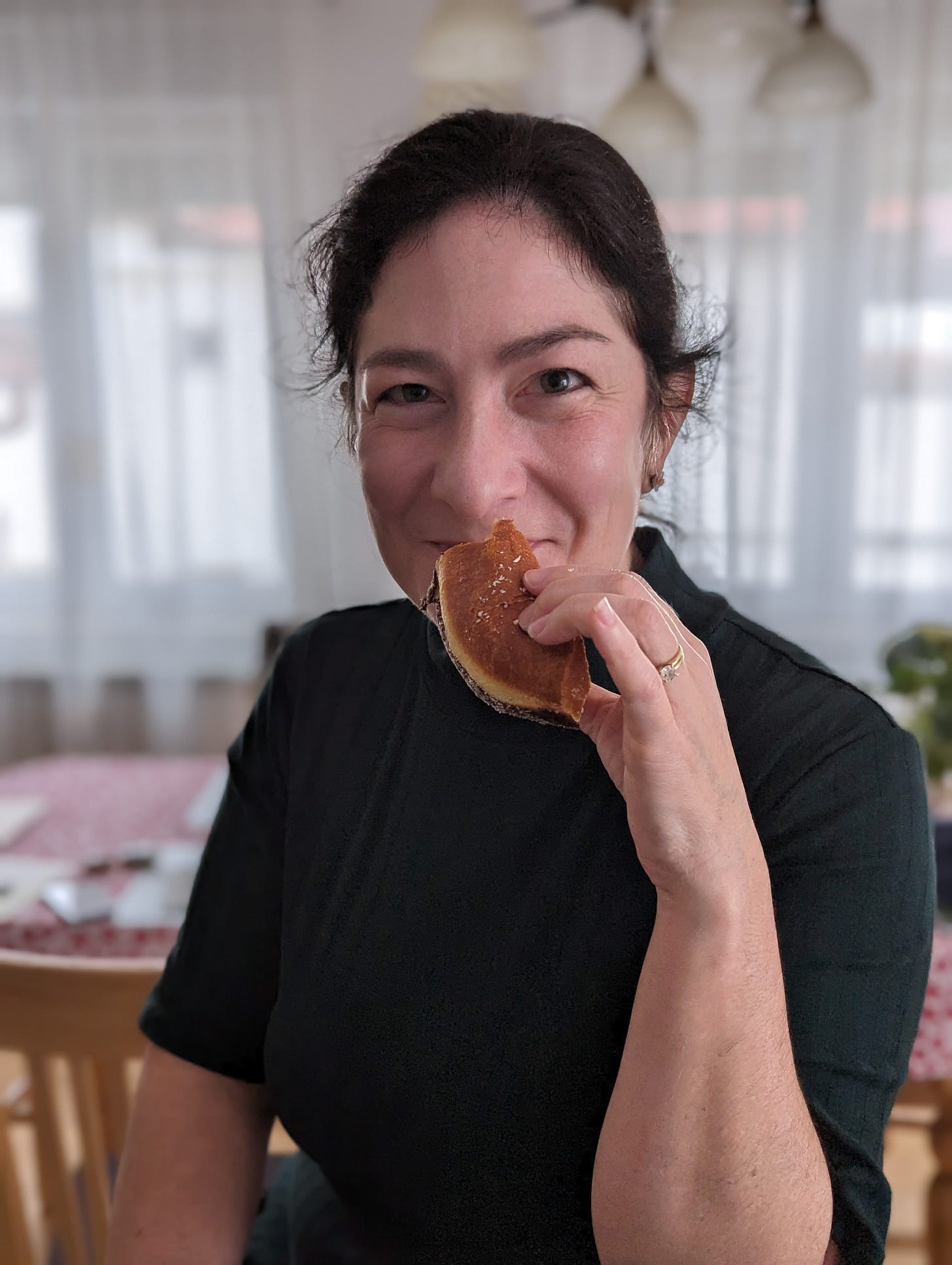


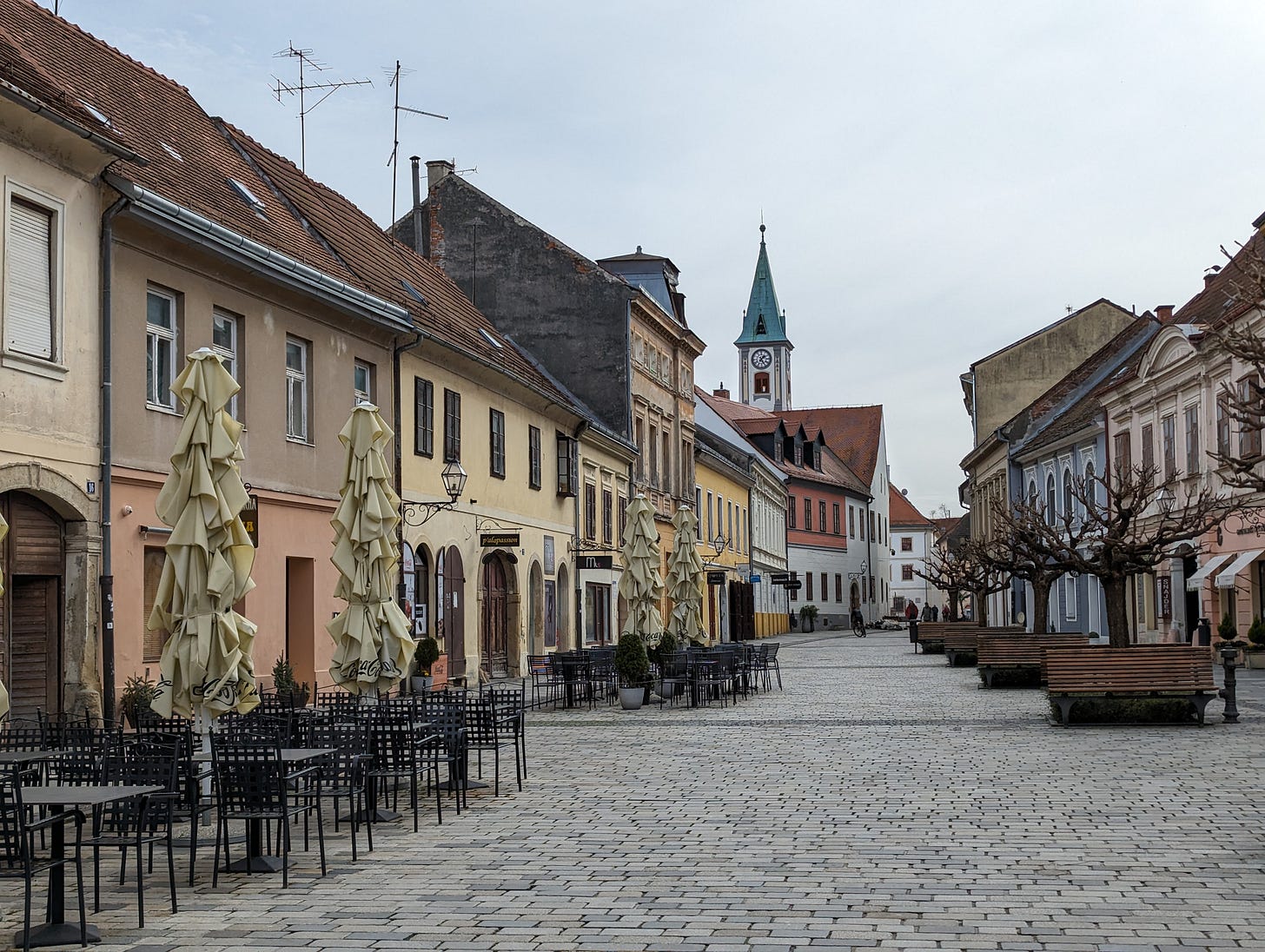
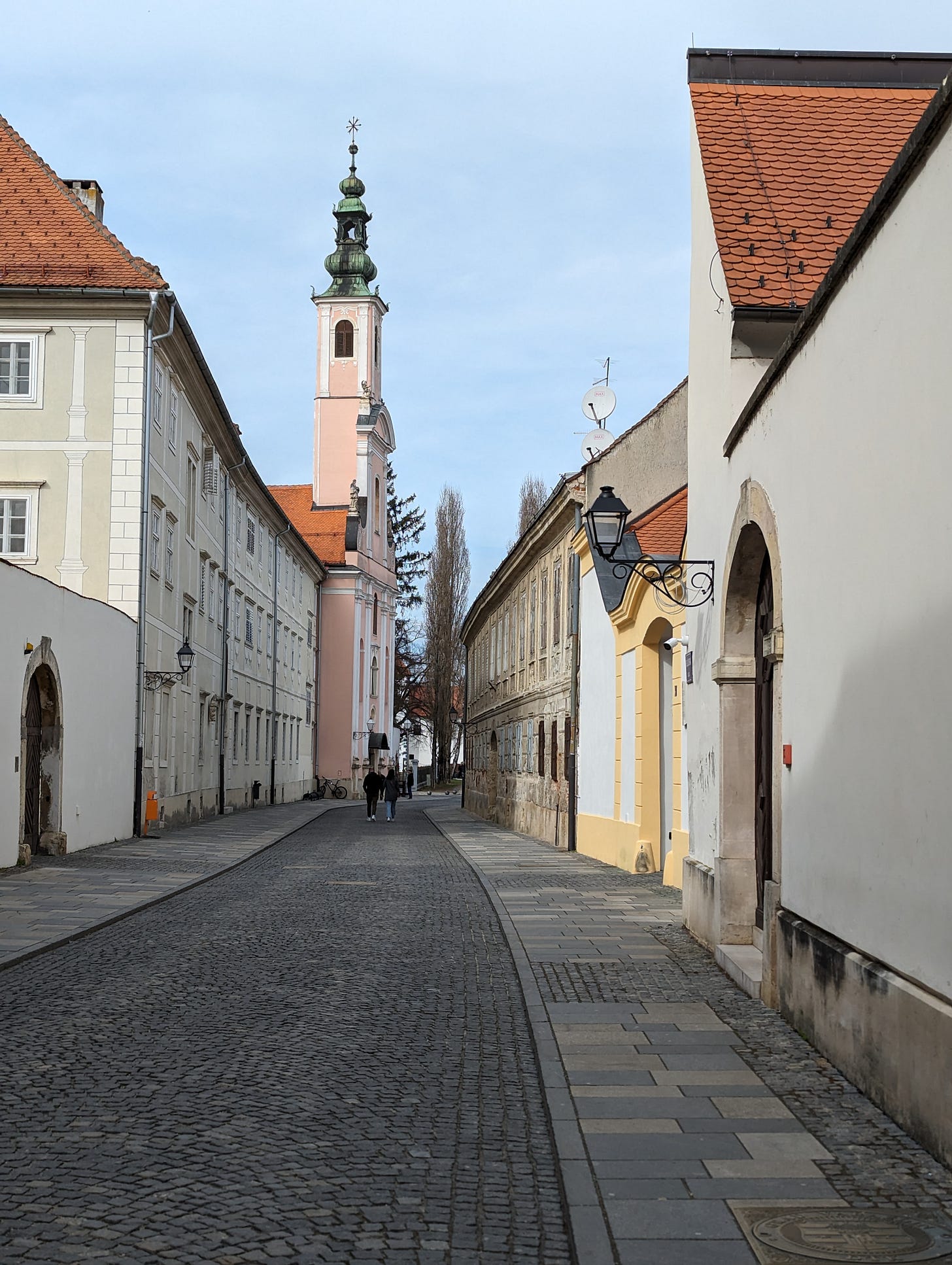
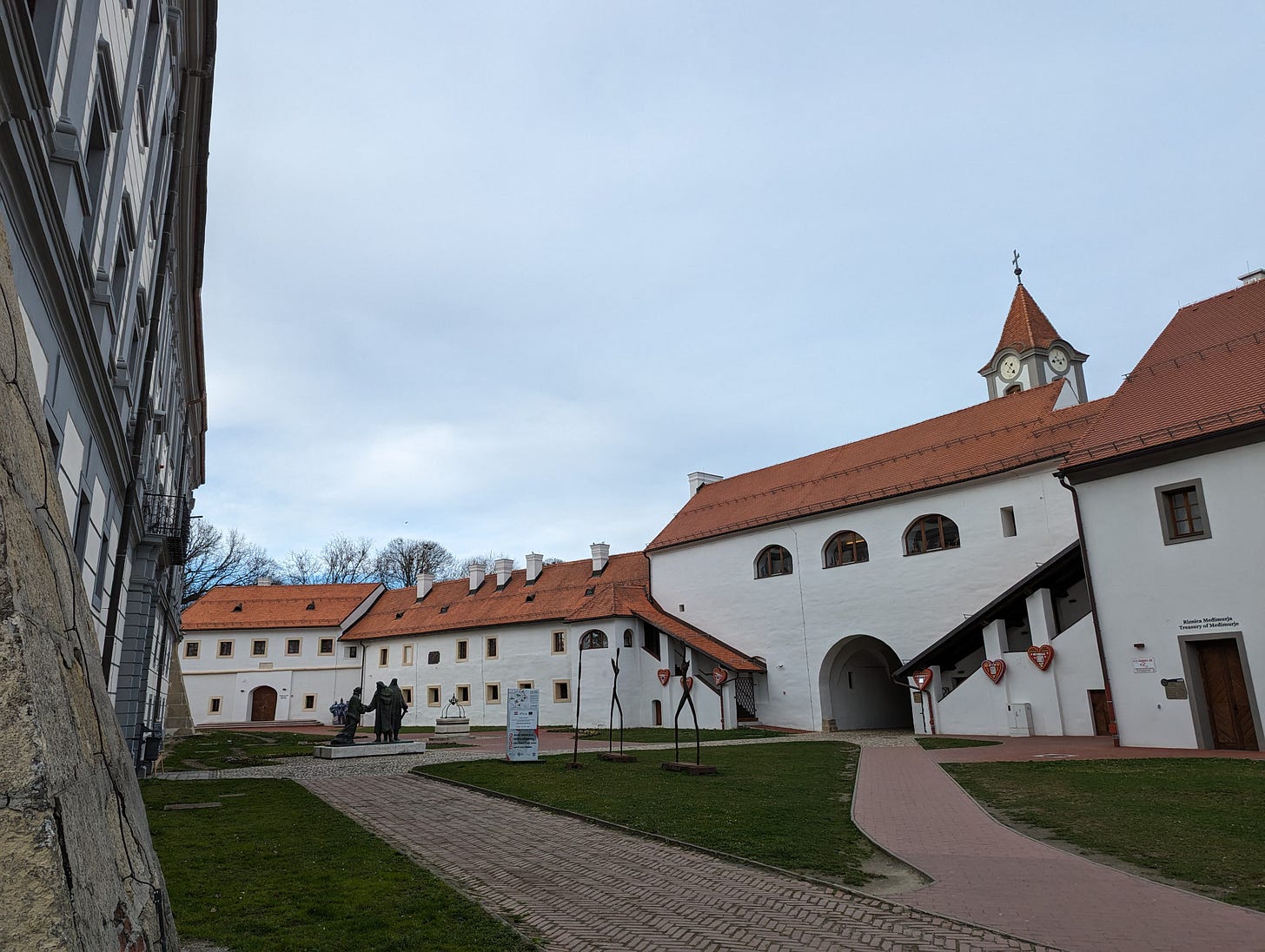


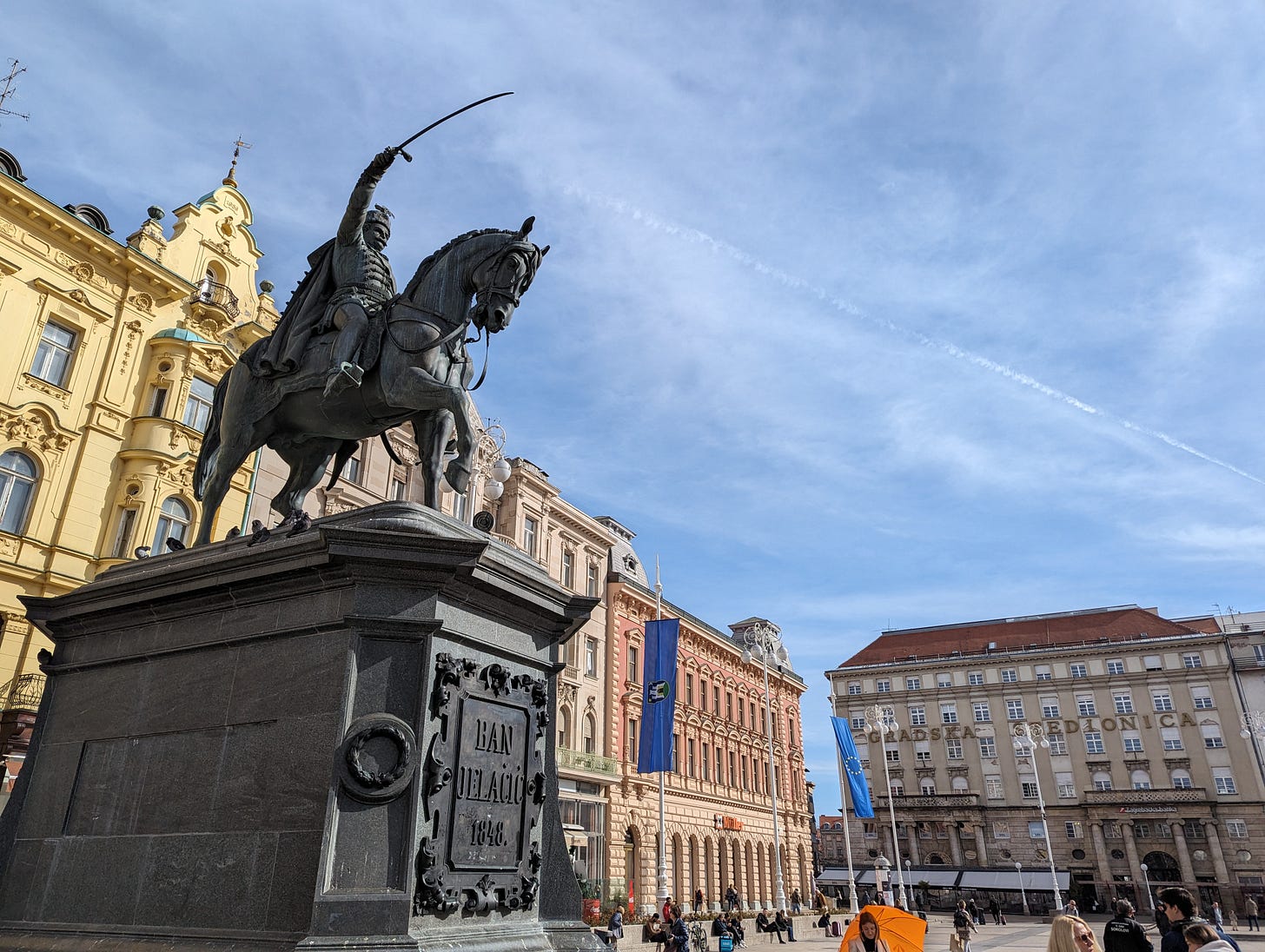
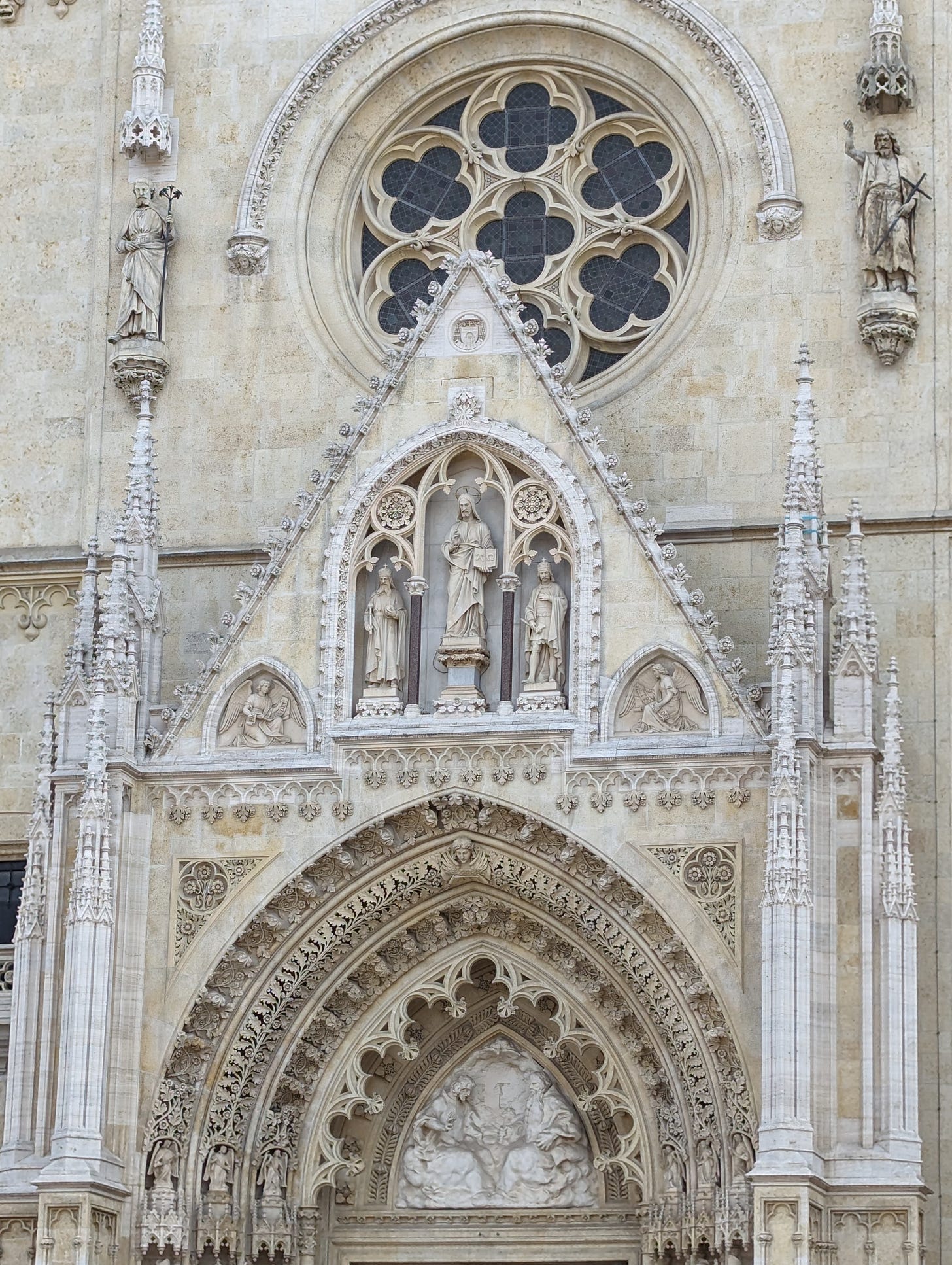

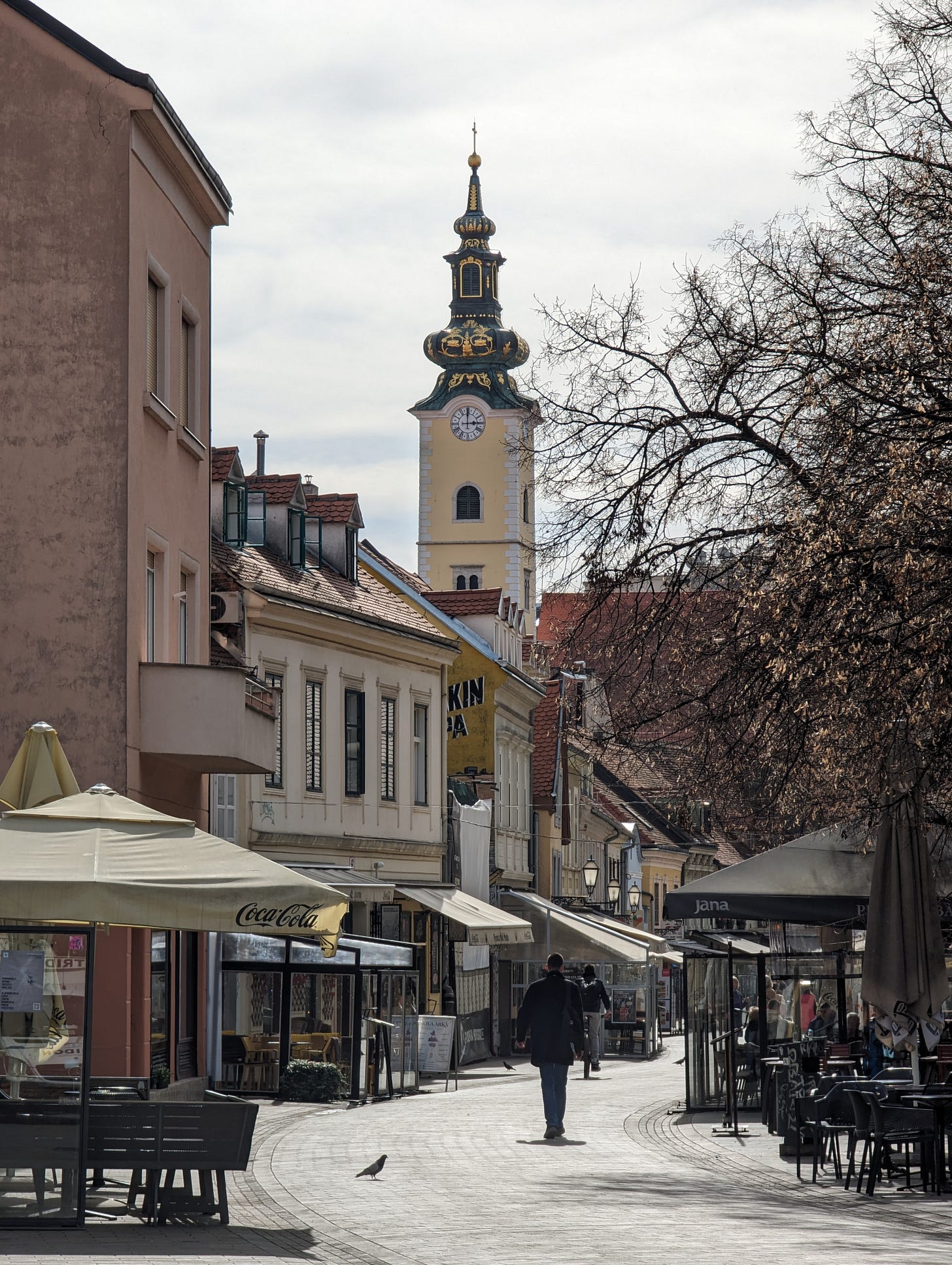
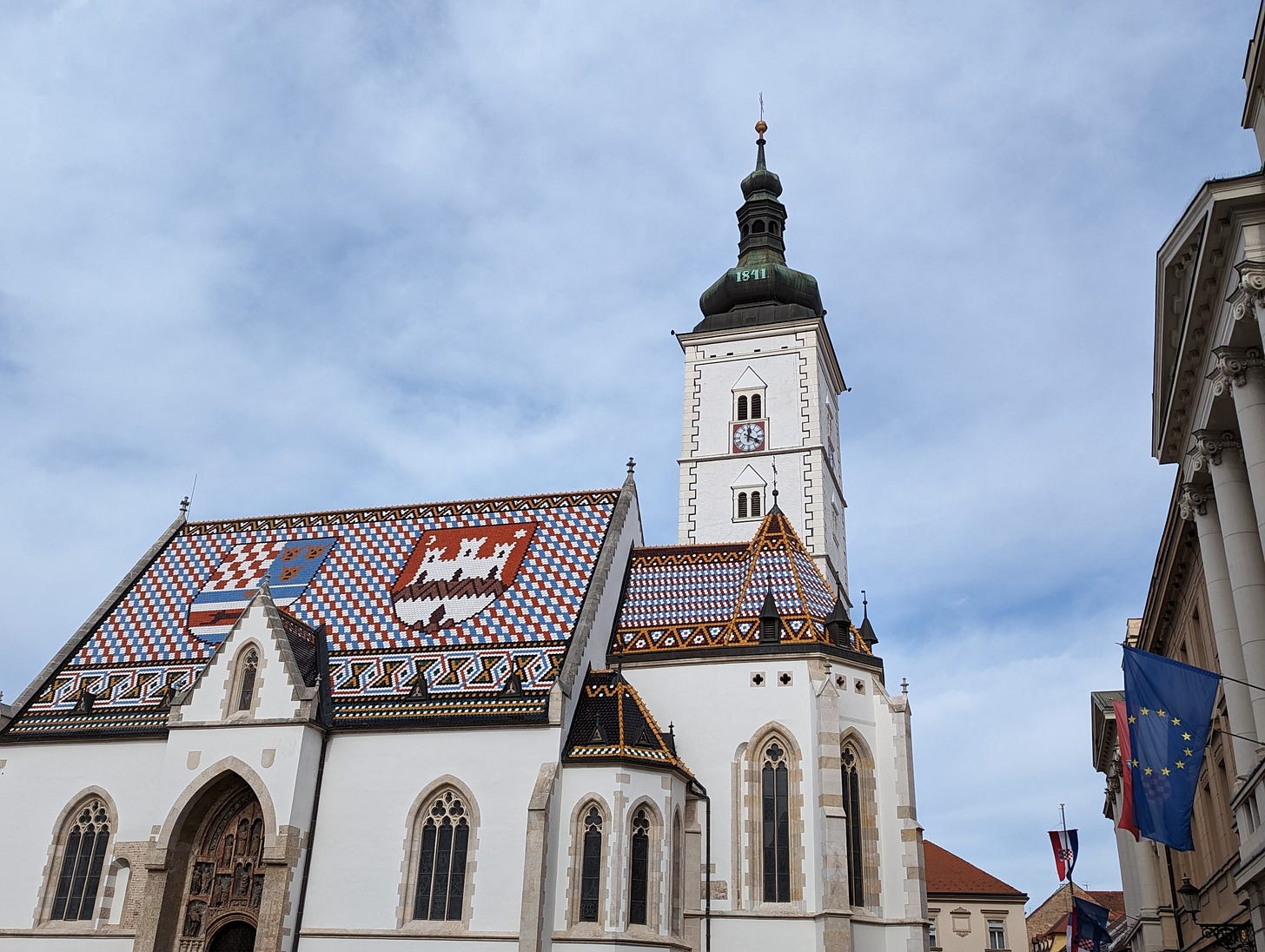
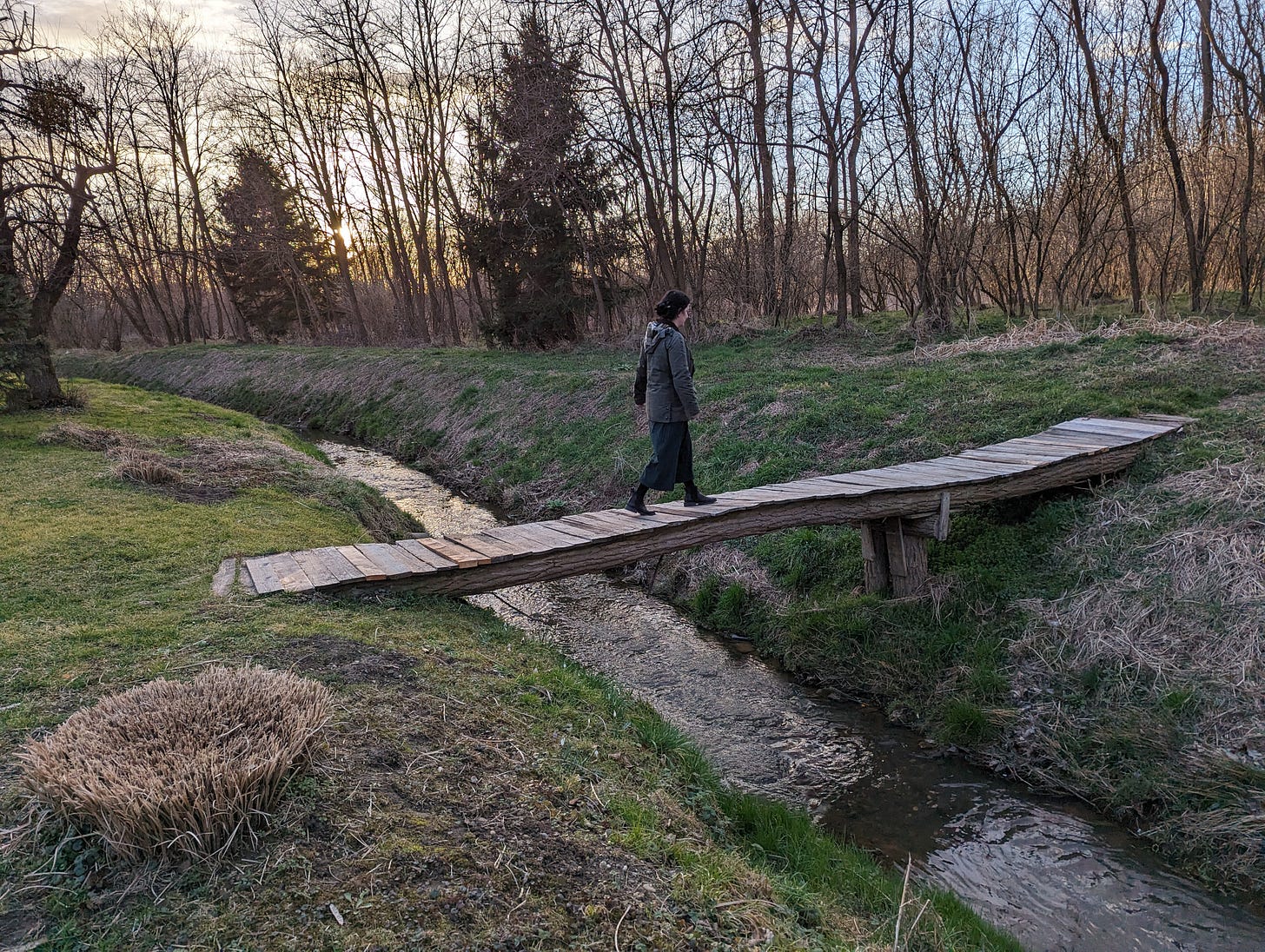
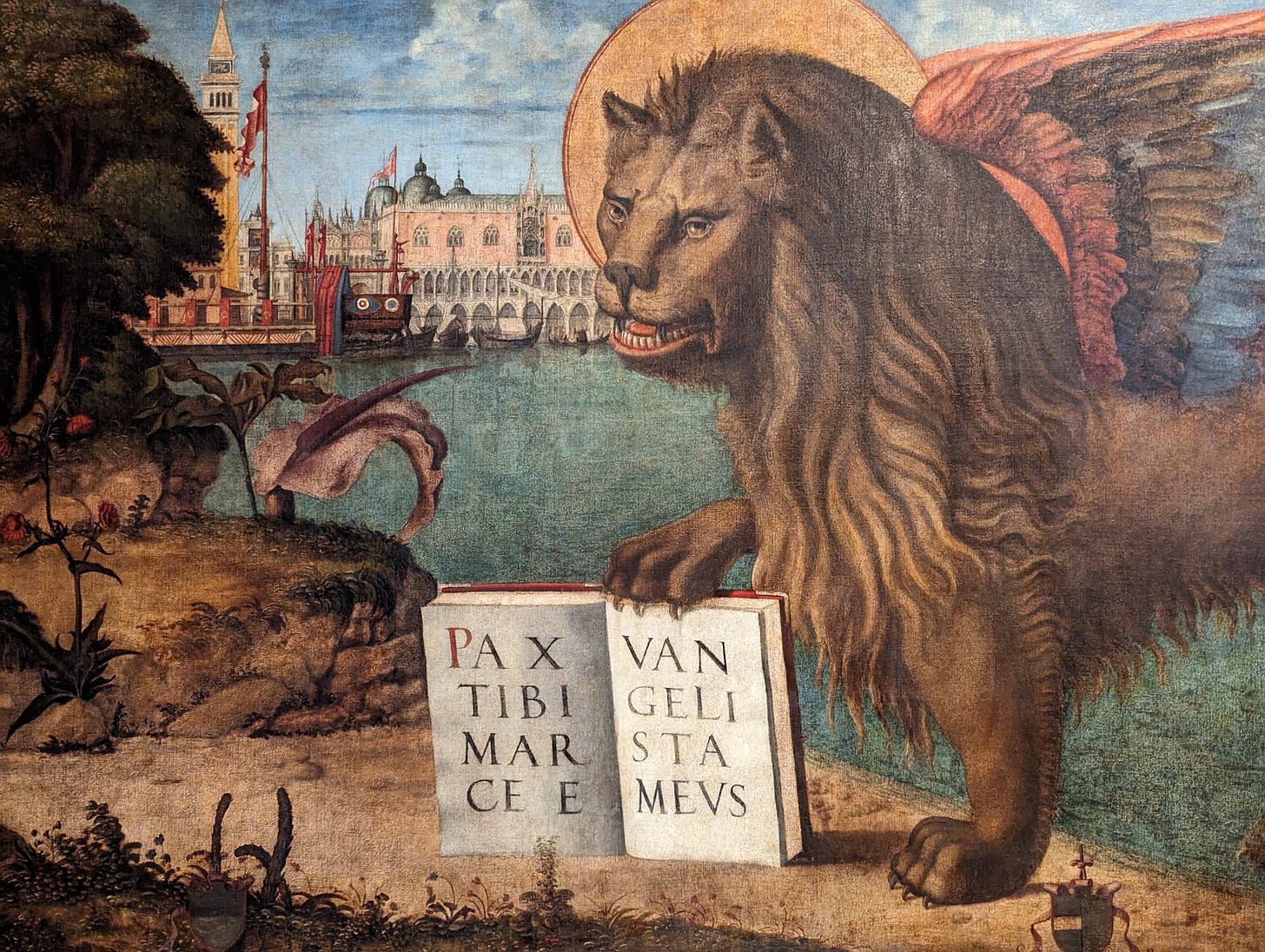
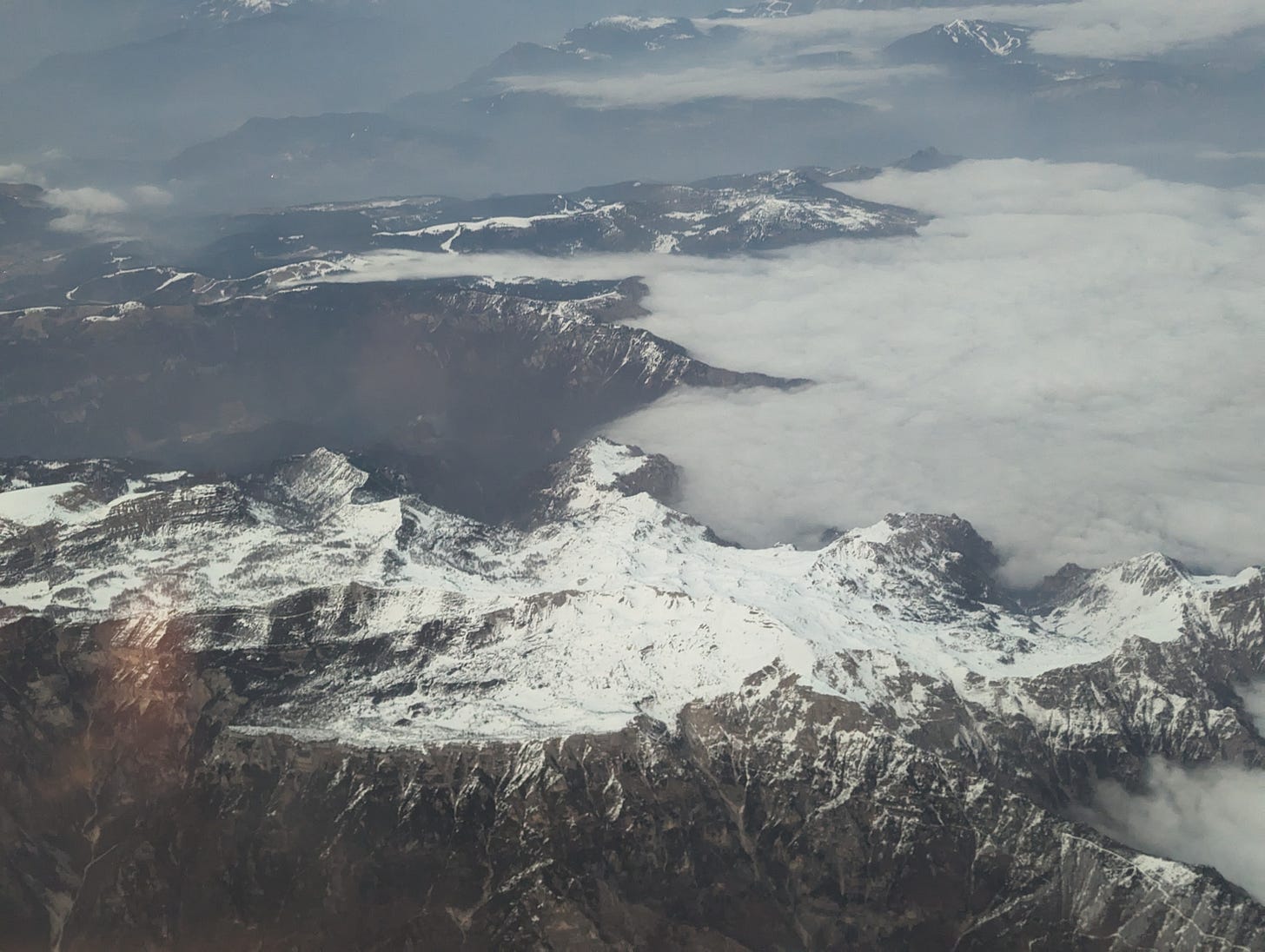

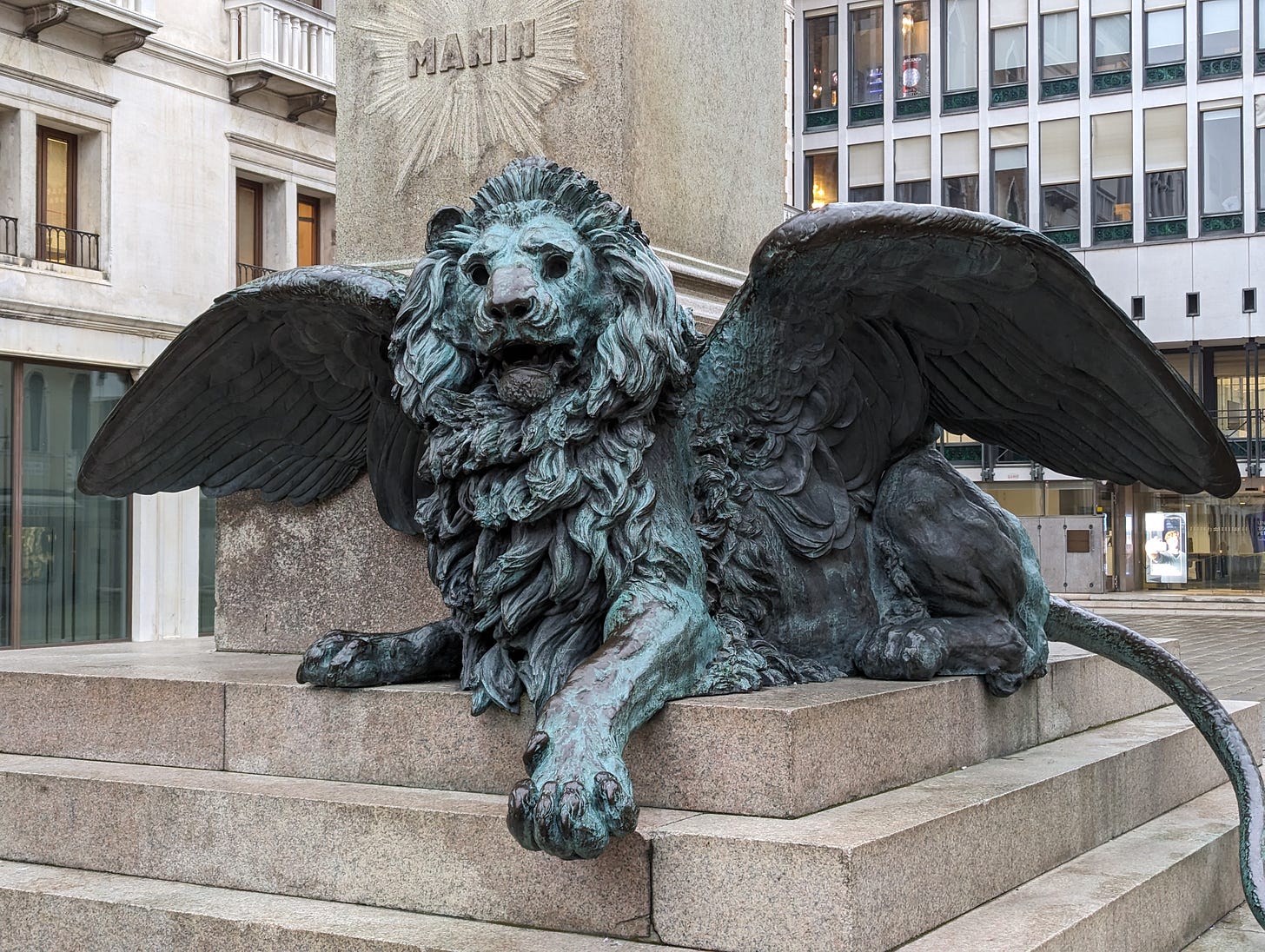
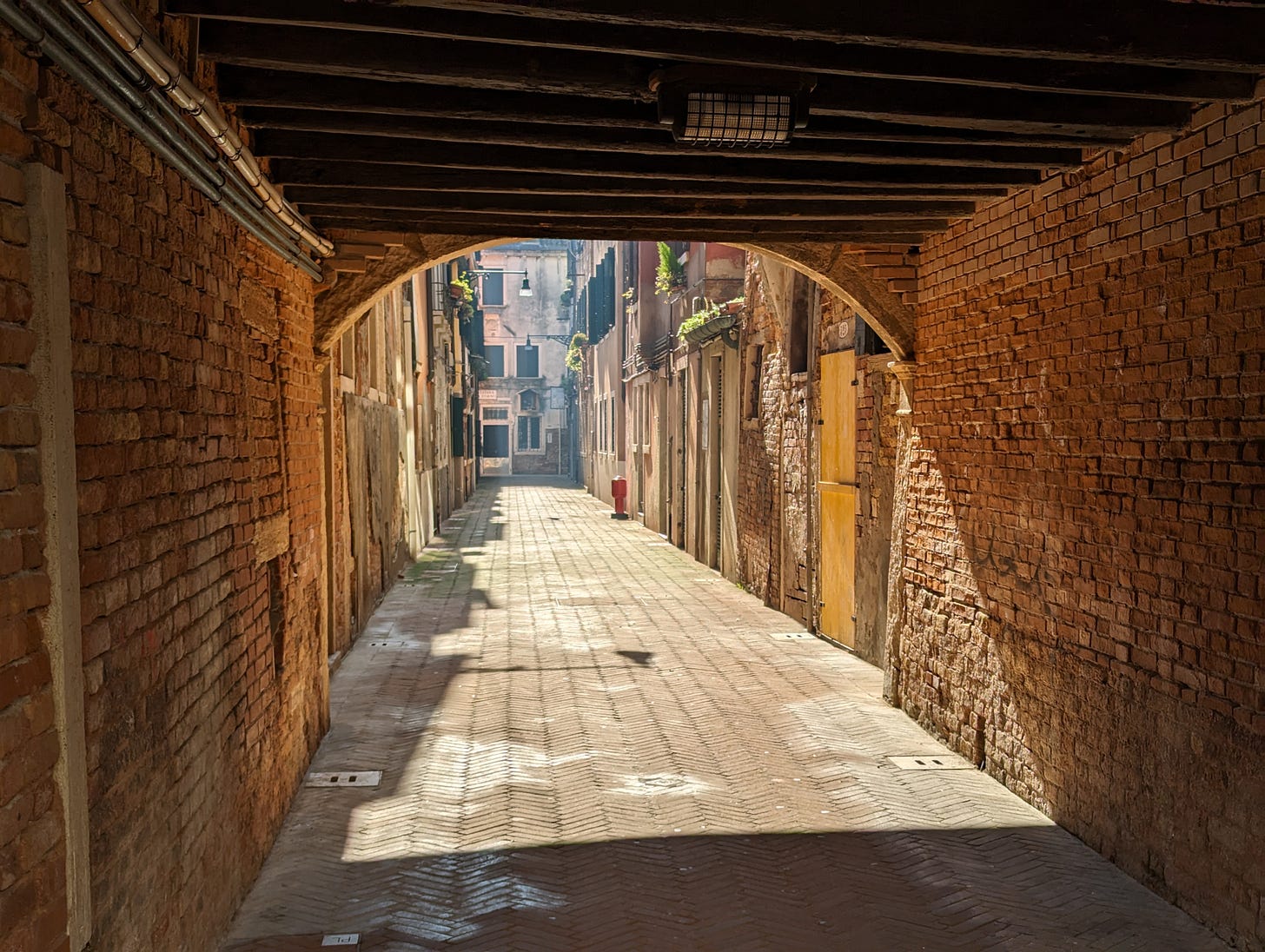
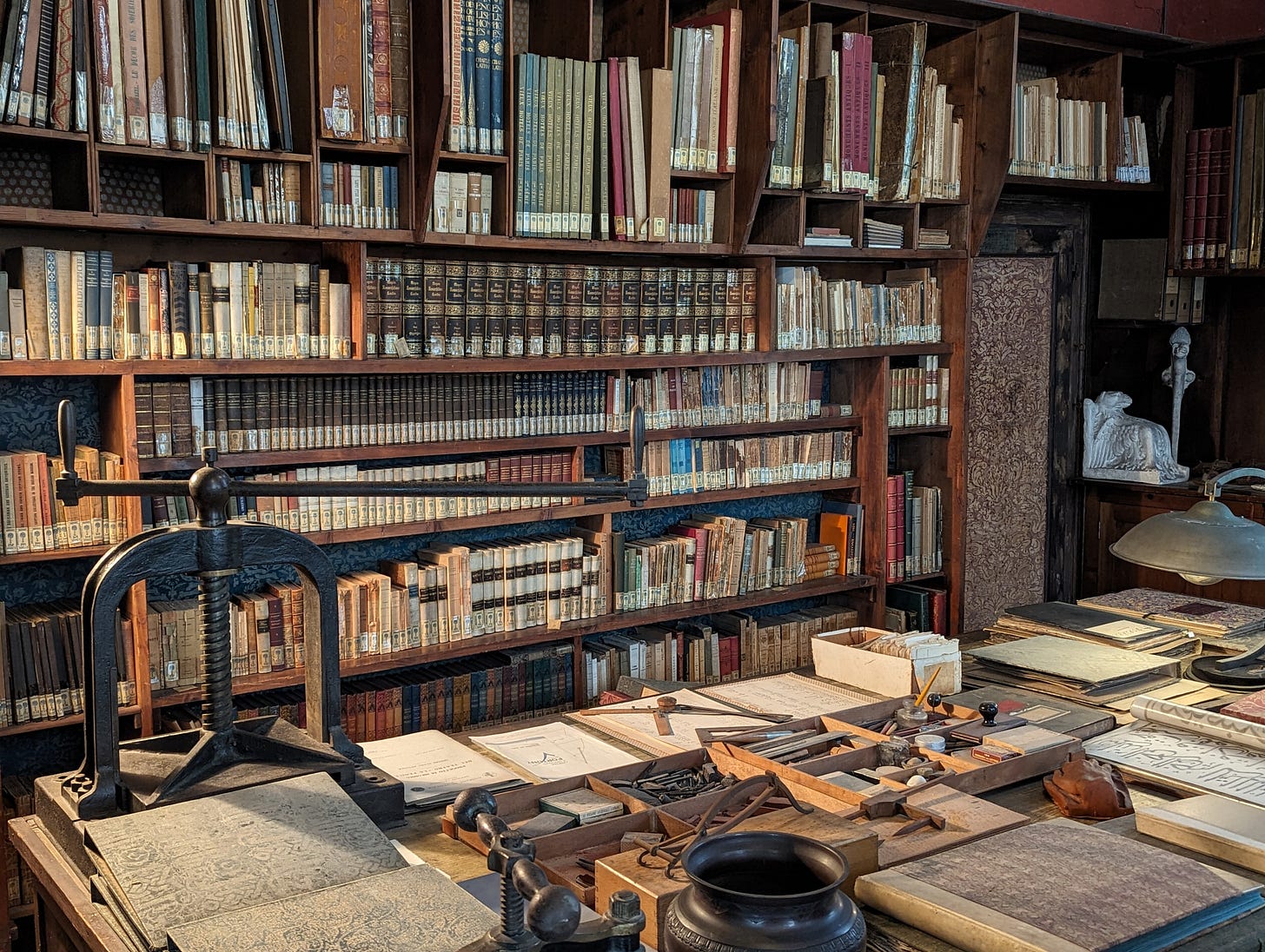

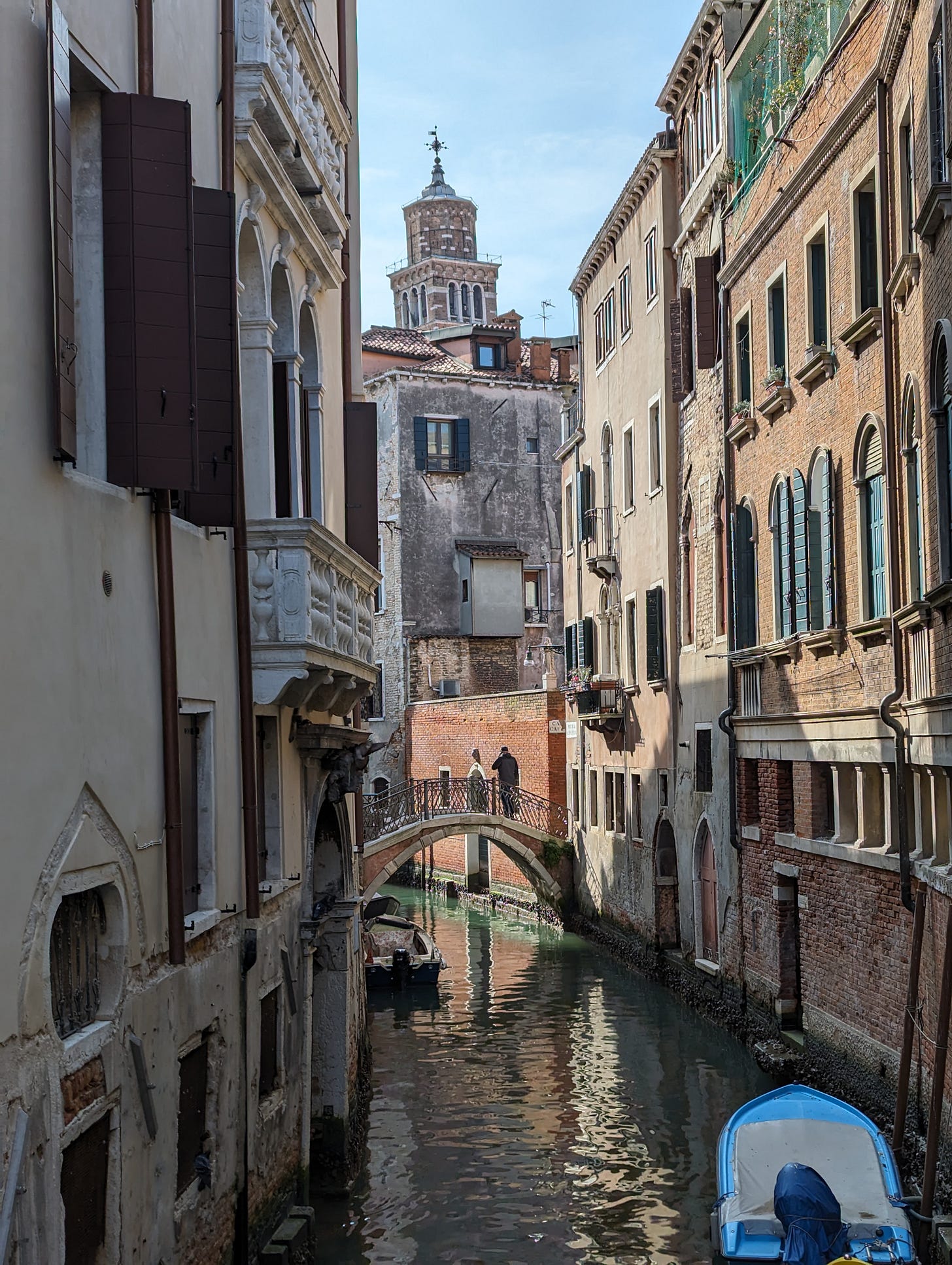

Great meditation on the cross. Herr Luther would approve.
Isn't it amazing that the impact of Christ in history was so significant that even his mode of death was slowly turned into a metaphor, because men increasingly shunned making a spectacle out of it? I'm not completely sanguine about using M.D.s to devise modern capital punishments, as that goes against their oaths, but it heartens me that the civil authorities no longer view it as a means to frighten the citizens into worshipping power, as it was used in Rome.
Now we can talk about bearing our cross even if it's an illness, or family conflict. It retains its humbling and somewhat public character. A means to suffer something faithfully while doing good and serving as an example to the world.
Speaking as a privileged westerner, of course...
That was a delight to read. Thank you. Venice is now slightly demystified for me, and I'm even more eager now to visit someday.
To me, cars don't represent dehumanization, so much as frontier economics. The internal combustion engine and plentiful fuel were effective solutions in certain places to the boom of human growth and what that naturally does to real estate values. As an American, of course, my perception is colored by the western expansion. The car is essentially the horse. The Methodist circuit riders couldn't have done what they did without the horse, or, in another day and age, the car.
But there is no denying the delight of a pedestrian dominated cosmopolitan landscape. I wonder if perhaps these landscapes will emerge more and more as the earth becomes more cosmopolitan, as the bible seems to predict, and newer, more cost effective solutions are developed.
Some extol trains, which have their allure. But it's difficult to imagine those in Venice!
It will be fun to see in 100 or 200 years if even the relatively economically modest demographic set are able to enjoy delightful walking cities. Even some stereotypical sprawling car built cities in the USA, founded after the ICE, are now wealthy enough to install numerous delightful walking and biking greenbelts.